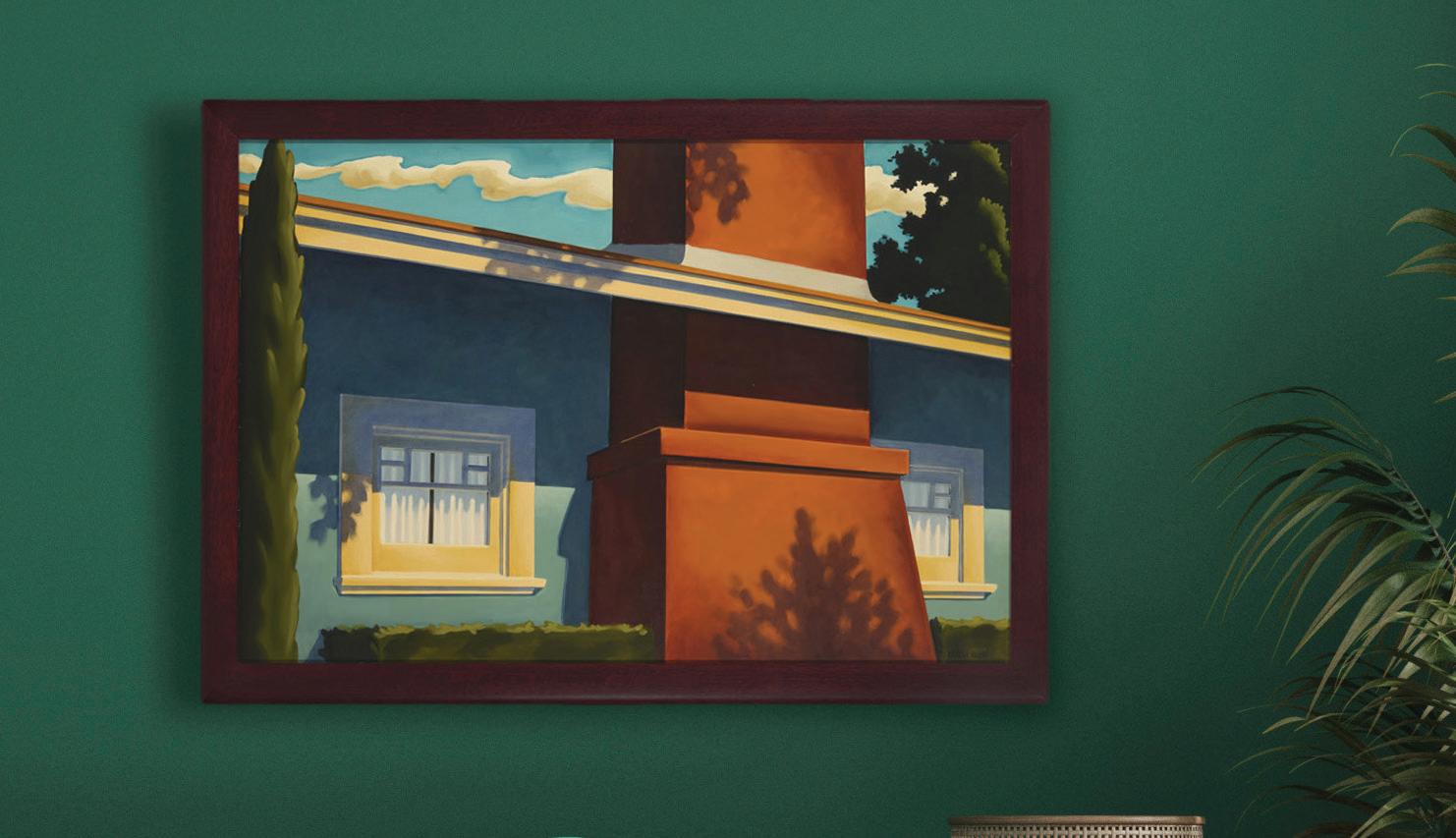
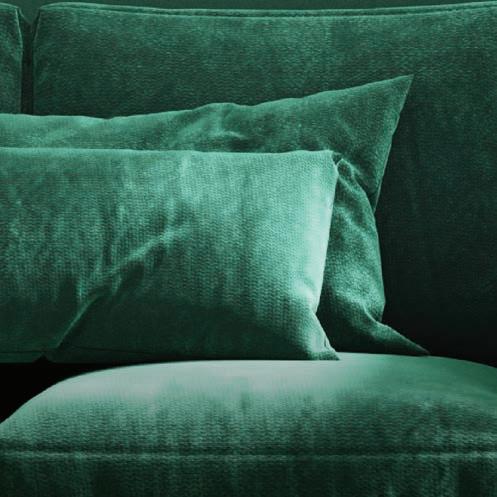
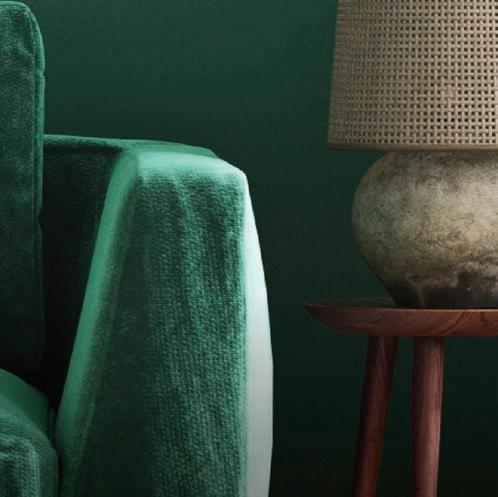
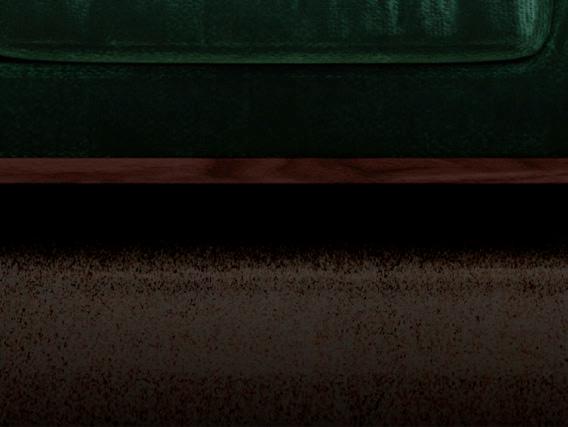
Modern & Contemporary Fine Art
Tuesday, June 17, 2025
SINCE 1969
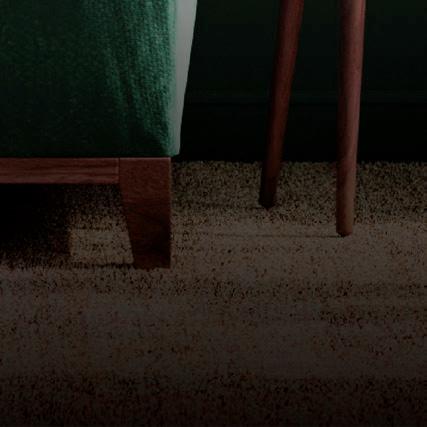
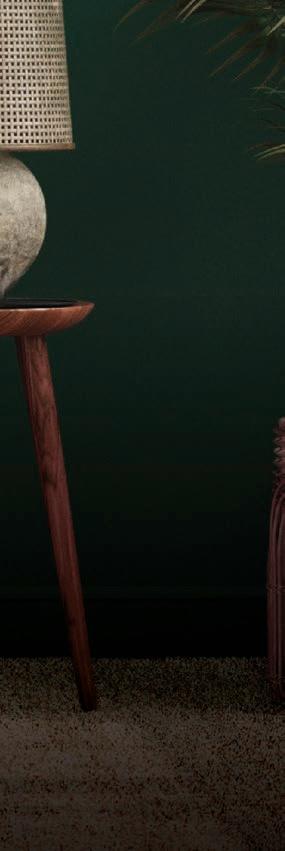

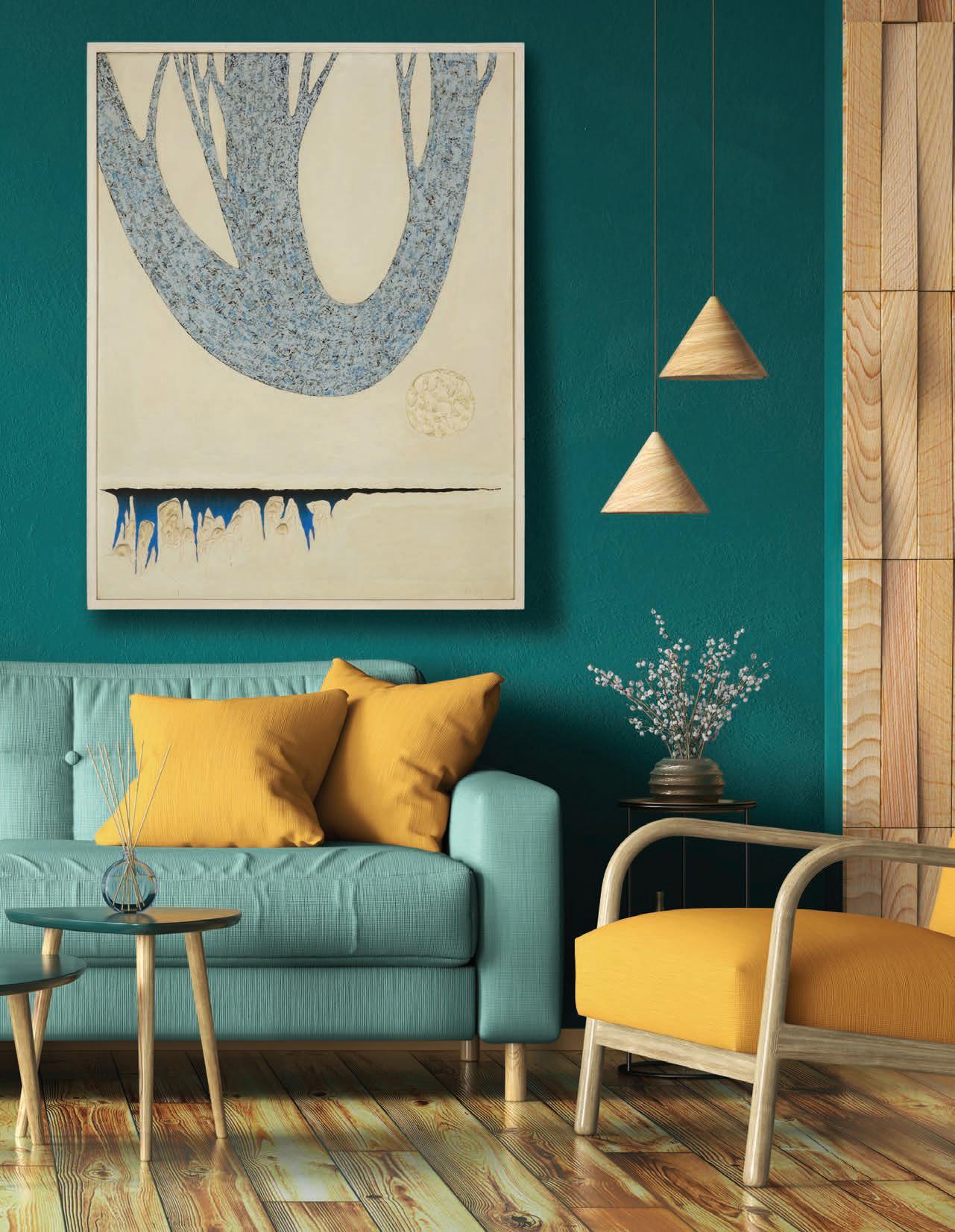





Modern & Contemporary Fine Art
Tuesday, June 17, 2025
SINCE 1969




Katherine
Anne Spink Senior Cataloguer, Fine Art a.spink@johnmoran.com
Madison Ari Cataloguer, Fine Art m.ari@johnmoran.com
Lori Kassabian Cataloguer, Fine Art l.kassabian@johnmoran.com


Joan Miró (1893-1983)
One plate from “Fissures,” 1969 Aquatint in colors on BFK Rives paper
From the edition of unknown size (aside from the numbered edition of 75 and 20 hors commerce in Roman numerals) Signed in pencil lower right: Miró; Maeght Éditeur, Paris, pub. Sheet: 19.25” H x 23” W
$2,000-3,000
Provenance: Private Collection, Los Angeles, CA
Literature: Dupin 470

2
Joan Miró (1893-1983)
One plate from “Fissures,” 1969 Aquatint in colors on BFK Rives paper From the edition of unknown size (aside from the numbered edition of 75 and 20 hors commerce in Roman numerals) Signed in pencil lower right: Miró; Maeght Éditeur, Paris, pub. Sheet: 19.25” H x 23” W
$2,000-3,000
Provenance:
Timothy Yager Fine Art, Beverly Hills, CA Private Collection, Los Angeles, CA
Literature: Dupin 475
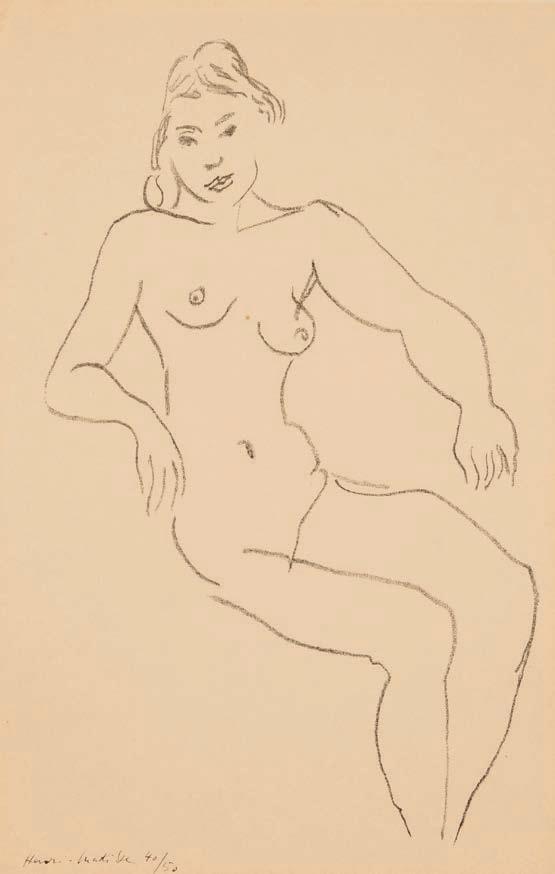
Henri Matisse (1869-1954)
“Nu assis, Chevelure foncée,” 1922
Lithograph on Japan paper
Edition: 40/50 (there were also 10 artist’s proofs)
Signed and numbered in ink along the lower margin edge, at left: Henri Matisse
Image: 15” H x 9.5” W; Sheet: 17.375” H x 11.125” W
$4,000-6,000
Literature: Duthuit 421
Rockwell Kent (1882-1971)
“The Lovers,” 1928
Wood engraving on light-tan imitation Japan paper
From the edition of 100 (there was also a posthumous edition printed in blue on white Arches paper)
Signed in pencil in the lower margin, at right, directly below the image: Rockwell Kent; E. Weyhe, Inc., NY, pub.
Image: 6.5” H x 10” W; Sheet: 12.125” H x 15” W
$4,000-6,000
Provenance:
The East West Gallery, San Francisco, CA
Unidentified blue ink collector’s stamp, verso
Literature:
Burne Jones 23
Notes:
According to Burne Jones, there was a posthumous edition of 100 impressions printed in 1973 via photo silkscreen in blue ink on heavy white Arches paper.
“The Lovers” is a striking example of Rockwell Kent’s ability to combine emotional intimacy with natural settings. In this intimate composition, two nude figures recline against a stark black background, their pale bodies rendered in smooth, sculptural forms. One figure lies peacefully with eyes closed, head cradled in the arm of the other, who gazes outward with a serene expression. The scene is framed by a few stylized ferns, adding a natural, Edenic touch to the otherwise barren space.
Typical of Kent’s printmaking style, Kent’s use of light and shadow is central to the emotional power of the image. The high contrast between the luminous bodies and the surrounding darkness creates a dramatic, almost theatrical effect. The figures are idealized, almost sculptural, recalling classical forms while also embodying Kent’s modernist leanings. Despite the simplicity of the setting, the wood engraving conveys a deep sense of intimacy and tranquility.

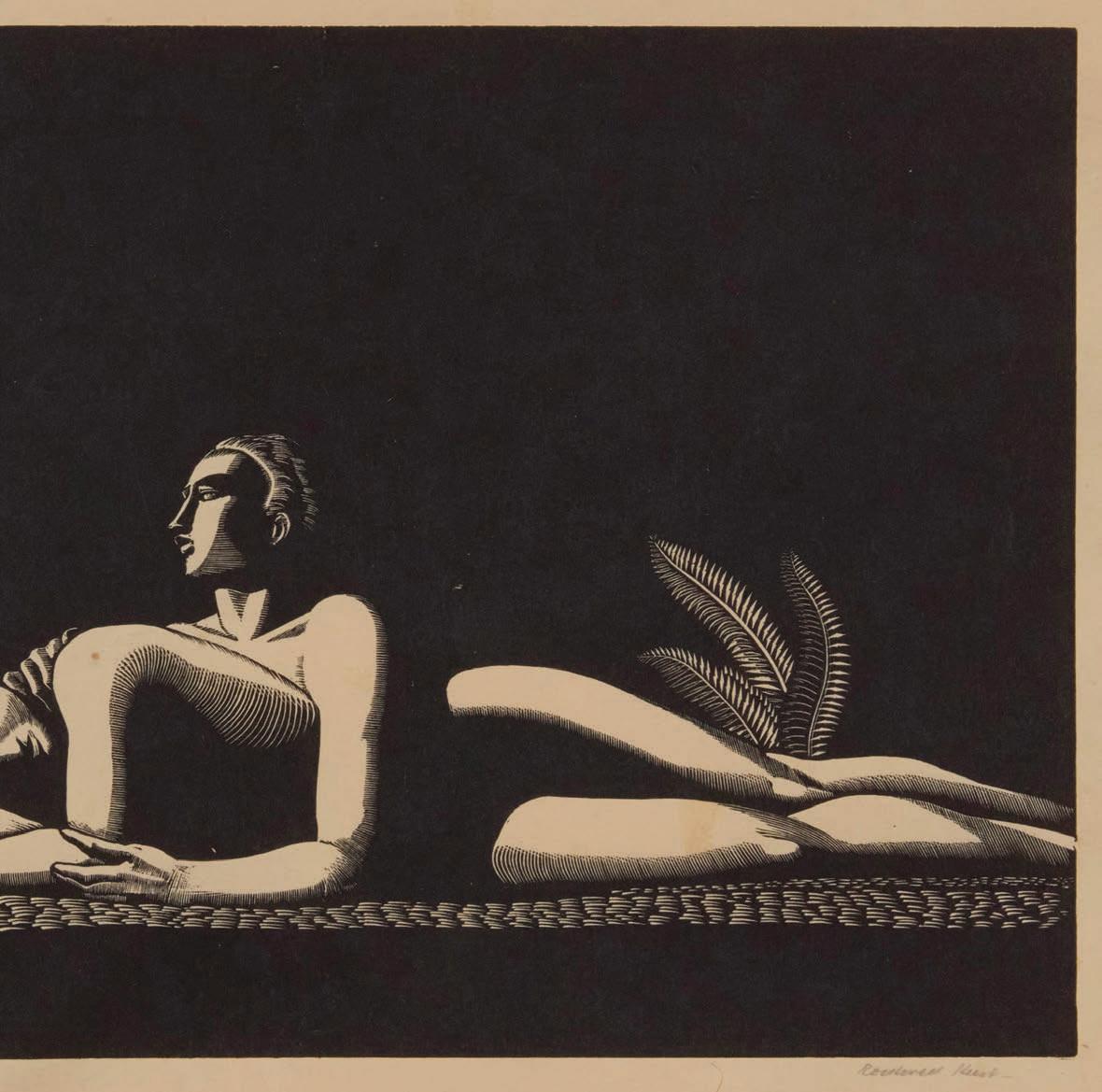
Rockwell Kent (1882-1971)
“Hail and Farewell,” 1930
Wood engraving on wove paper
From the edition of 120
Signed in pencil in the lower margin, at right, directly below the image: Rockwell Kent; titled in pencil, in another hand, in the lower margin edge, at left
Image: 8” H x 5.5” W; Sheet: 14.375” H x 11.25” W
$2,000-3,000
Literature: Burne Jones 55
Notes:
“Hail and Farewell” features a single nude male figure climbing a rope ladder, viewed from behind, with his arms raised outward—one in a gesture of farewell and the other seemingly reaching into the unknown. The figure is suspended in a dramatic, vertical composition, with linear striations in the background suggesting light descending from above.
Kent uses sharp contrasts between the pale flesh of the figure and the deep black background to heighten the emotional intensity of the scene. The body appears both vulnerable and monumental, a testament to Kent’s ability to blend classical form with modern existentialism.
This work highlights Kent’s skill in creating dramatic visual effects through minimal detail and bold composition. The simplicity of the setting and the stylized form of the figure are characteristic of his graphic work from the 1930s. While the gesture of the figure can be interpreted in various ways, the image remains open-ended and visually striking, focusing on movement, isolation, and clarity of design.

6
After Georges Braque (1882-1963)
“Nature Morte,” by Jacques Villon, 1922-23 Aquatint in colors on BFK Rives paper Edition: 126/200
Signed and numbered in pencil in the lower margin: G. Braque; with the printed signature, date, and inscription in the plate, lower left: “gravé par Jacques Villon 1923;” Jacques Villon, prntr.; Galerie Bernheim-Jeune, Paris, pub. Plate: 23.25” H x 8.625” W; Sheet: 25” H x 14” W
$1,500-2,500
Provenance:
Public Library of Cincinnati Fine Arts Department, Cincinnati, OH Private Collection, Los Angeles, CA
Literature:
Ginestet & Pouillon E636


Hayward King (1928-1990)
“Notre Dame de Paris,” 1956
Lithograph on light beige paper
Edition: 10/15
Signed, titled, dated, and numbered in pencil in the lower margin: Hayward King ‘56; inscribed in pencil in the upper margin, at left, “For Janis and John” Image: 19” H x 16.5” W; Sight: 20” H x 17” W
$500-700
Marc Chagall (1887-1985)
“Les Toits (Roofs),” 1956 Lithograph in colors on wove paper Edition: 36/75 (there were also some artist’s proofs)
Signed and numbered in pencil in the lower margin: Marc Chagall; Maeght, France, pub. Image: 21.5” H x 17” W; Sheet: 26.25” H x 19.75” W
$5,000-7,000
Provenance: Private Collection, Los Angeles, CA
Literature: Mourlot 163


9
Marc Chagall (1887-1985)
“The Trampled Flowers” from “Daphnis and Chloe,” 1961
Lithograph in colors on wove paper
From the edition of 250 (there were also 60 signed and numbered impressions with margins)
Unsigned, as issued; Verve, Paris, pub.
Image/Sheet: 16.5” H x 12.625” W
$2,000-3,000
Provenance: Galerie Michael, Beverly Hills, CA
Literature: Mourlot 342; cf. Cramer books 46
Notes:
This lot is accompanied by a certificate of authenticity issued by the gallery mentioned above. Additionally, a photocopy of the original invoice, dated 4/5/01, is affixed to the frame’s backing board.

10
Marc Chagall (1887-1985)
“Devant St. Jeannet (Near St. Jeannet),” 1972
Lithograph in colors on Arches paper
Edition: 20/50 (there were also some artist’s proofs)
Signed and numbered in pencil in the lower margin: Marc Chagall; Andre Seurat, pub. Image: 12.25” H x 9.625” W; Sheet: 20.5” H x 15.875” W
$2,000-3,000
Provenance: Private Collection, Los Angeles, CA
Literature: Mourlot 646


After Pablo Picasso (1881-1973)
“Bacchanale,” circa 1959-63
Aquatint in colors on BFK Rives paper
Edition: 123/300
Signed and numbered in pencil in the lower margin: Picasso; Atelier Crommelynck, Paris, pub. and with their blindstamp in the lower left margin corner Plate: 18.75” H x 22.25” W; Sheet: 22.125” H x 30.125” W
$10,000-15,000
Notes:
“Bacchanale” is an original, limited edition work on paper that was created using the aquatint form of intaglio printing to meticulously reproduce this image as it was first painted in ink and gouache on board by Pablo Picasso on June 22, 1956. It is one example from a print edition of 300 signed and numbered aquatint impressions created at Picasso’s request, and under his direct supervision, between 1959 and 1963. Lacking the highly technical skills required to accomplish his goal, Picasso enlisted the Paris-based master printers Aldo and Piero Crommelynck to etch the elaborate matrix based on his preexisting gouache onto a large copper plate and then, after receiving his approval for the visual accuracy of the design and colors, print 300 examples of this aquatint onto paper for him to sign and number by hand.
Aldo (1931-2008) and Piero (1934-2001) Crommelynck were two of four sons born into an extended family of playwrights, painters, set designers, and classical musicians that encouraged one another to begin mastering a professional craft from a young age. For Aldo and Piero (and to a lesser extent their youngest brother Milan), this exploration began during the 1940s with teenage apprenticeships in the Paris workshop of a family friend, Roger Lacouriere, who had already developed a lasting reputation as one of France’s most highly regarded master printers. He taught them the intricacies of intaglio printing and first introduced them to artists such as Joan Miro and Pablo Picasso. The Crommelyncks continued to train with and work for Lacouriere until 1955, at which point they decided to start their own printing workshop, initially in partnership with another aspiring young master printer, at a cramped location behind Paris’ Montparnasse station. They began to establish their own reputation as a resepected printing workshop when artists such as family friend Georges Braque came to them to explore intaglio printmaking for the first time. In 1959, their partner left to work for printer/ publisher Amie Maeght, and Aldo and Piero were able to move their printing workshop to a better location, still strategically within the creative Montparnasse neighborhood, and named it “Atelier Crommelynck.”
It was at this Paris location, on rue de Gergovie, that Aldo and Piero Crommelynck helped additional artists such as Alberto Giacometti and Andre Mason try their hands at intaglio printmaking for the first time. It was also where, as was an established artistic practice stretching back for several hundred centuries in Europe, the Crommelyncks embarked on highly specialized, multi-year collaborations with Picasso, Miro, and Jacques Villon, to create limited edition “gravures d’interpretations” (i.e. etched color reproductions) based on those artists’ unique works in other mediums. The impression of Picasso’s “Bacchanale” offered here, as already mentioned, is a technical marvel resulting from one of these four-year artistic collaborations.
Picasso was clearly very fond of this image. Bacchanale themes appear numerous times throughout his career. In this case, there is also the thought that this version could simultaneously represent the three ages of man at a time when the aging artist would have been reflecting on his own life. Whatever the case, we know that in addition to his interest in working with the Crommelyncks to produce the aquatint edition, Picasso chose to retain the unique gouache as part of his personal collection until his death in 1973. In February of 2019, Sotheby’s London sold that painting to a private collector. Thanks to Atelier Crommelynck, there are still opportunities such as our auction when the rest of us can try to acquire a Picasso-approved impression of the aquatint.

12
Pablo Picasso (1881-1973)
“Peintre Dessinant et Modele nu au Chapeau,” 1965
Linocut on Arches paper
Edition: HC (an “hors commerce” impression aside from the edition of 160 signed and numbered impressions plus 35 artist’s proofs)
Signed and inscribed “HC” in pencil in the lower margin: Picasso
Image: 20.875” H x 25.125” W; Sheet: 24.625” H x 29.625” W
$5,000-7,000
Literature: Bloch 1194; Baer 1357

Salvador Dalí (1904-1989)
“Bullfight #4,” from “Tauromachie de Dalí,” 1965
Lithograph in colors on BFK Rives paper
Edition: 55/300
Signed and numbered in pencil in the lower margin: Dalí; Sydney Z. Lucas, Paris, pub., and with their copyright ink stamp in the lower margin, at left
Sheet: 30” H x 22” W
$1,000-1,500
Provenance:
Brana Fine Art, Pacific Palisades, CA
Private Collection, acquired from the above
Literature: Michler/Löpsinger 1155; Field 66-1-4

14
Marc Chagall (1887-1985)
“Jour de mai (Day in May),” 1972
Lithograph in colors on Arches paper
Edition: 20/50 (there were also some artist’s proofs)
Signed and numbered in pencil in the lower margin: Marc Chagall Image: 24.875” H x 15” W; Sheet: 30” H x 20.5” W
$5,000-7,000
Provenance: Private Collection, Los Angeles, CA
Literature: Mourlot 654

15
Marc Chagall (1887-1985)
“Jonah I,” 1972
Lithograph in colors on Arches paper
Edition: 20/50
Signed and numbered in pencil in the lower margin: Marc Chagall; Teriade, Paris, pub. Image: 13.5” H x 10.25” W; Sheet: 23.25” H x 16.375” W
$2,000-3,000
Provenance: Private Collection, Los Angeles, CA
Literature: Mourlot 659
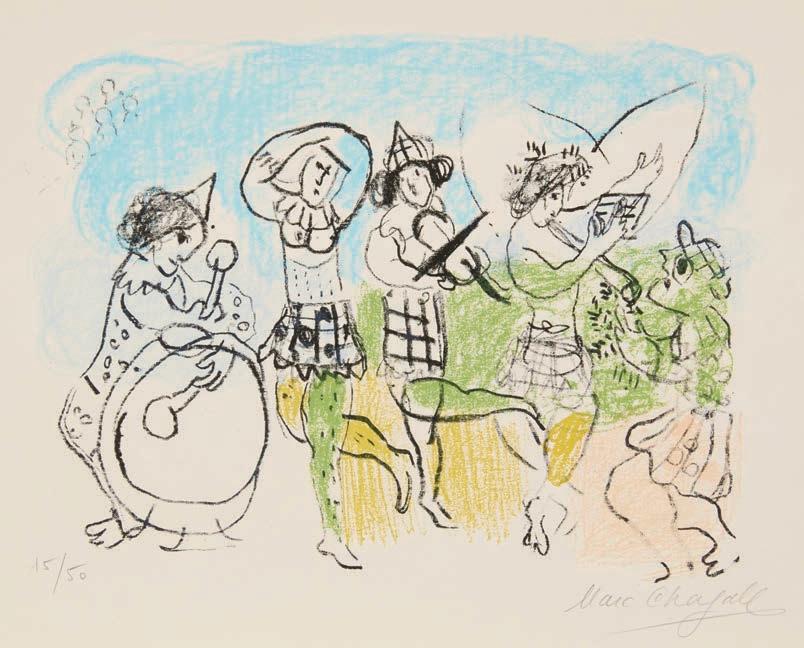
16
Marc Chagall (1887-1985)
“Les Petits Arlequins (The Little Harlequins),” 1962
Lithograph in colors on Arches paper
Edition: 15/50
Signed and numbered in pencil in the lower margin: Marc Chagall Image: 9.5” H x 13.5” W; Sheet: 14” H x 18” W
$2,000-3,000
Provenance: Private Collection, Los Angeles, CA
Literature: Mourlot 377

Ellsworth Kelly (1923-2015)
“Cyclamen IV,” from “Suite of Plant Lithographs,” 1964-65
Lithograph on BFK Rives paper
Edition: 25/75 (there were also 10 artist’s proofs)
Signed and numbered in pencil in the lower margin: Kelly; titled and inscribed “#8” in pencil on the verso of the lower right margin corner; Maeght Imprimerie, Levallois-Perret, prntr.; Maeght Éditeur, Paris, pub.
Image: 26.5” H x 15.75” W (irreg.); Sheet: 35.25” H x 24.25” W
$6,000-8,000
Provenance: John Torson, New York, NY Private Collection, acquired in 1978
Exhibited: New York, NY, The Museum of Modern Art, n.d.
Literature: Axsom

18
Robert Motherwell (1915-1991)
“Africa 10,” from the “Africa Suite,” 1970
Screenprint in black and cream on wove paper
Edition: 8/150
Initialed and numbered in pencil in the lower margin: RM; with the artist’s blindstamp in the lower margin, at right; titled and numbered “#49” in pencil, presumably in another hand, on the verso of the lower left margin corner; Kelpra Studios Ltd., London, prntr.; Marlborough Graphics, Inc., New York, pub.
Image: 31.5” H x 23.25” W; Sheet: 40.625” H x 28.25” W (irreg.)
$800-1,200
Literature: Belknap 49
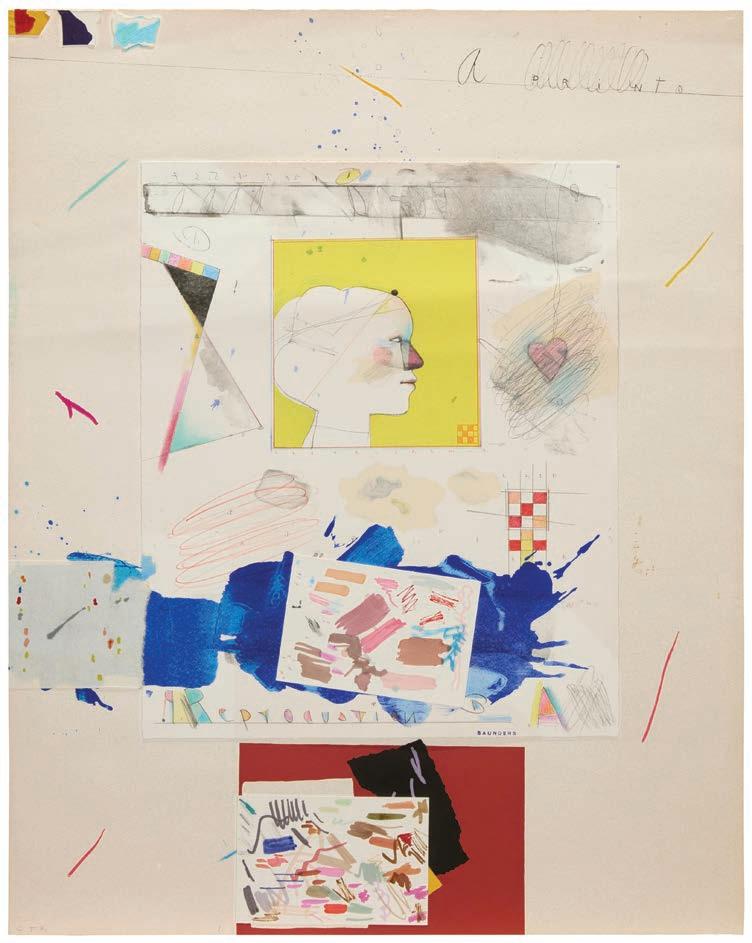
Raymond Saunders (b. 1934)
“Profile in Time,” 1982
Lithograph, screenprint, monoprint, and collage in colors on wove paper
Edition: CTP / 1 [color trial proof 1], aside from the edition of 75
The artist’s name stamped in purple ink in the image at the lower right of center: Saunders, and again in the stone as part of the composition at center: Sssaunders; inscribed “CTP” and “1” in pencil along the lower sheet edge, at left; Trillium Graphics, Brisbane, CA, pub. and with their blindstamp
Image/Sheet: 29.125” H x 23.25” W
$500-700
Provenance:
Triton Museum of Art, Santa Clara, CA

Nathan Oliveira (1928-2010)
“The Rocker,” 2007
Sugar lift aquatint with hard ground etching in colors on wove paper Edition: 35/35
Signed, dated, and numbered in pencil in the lower margin: N. Oliveira; Iaane Kjorlie, prntr.; Crown Point Press, San Francisco, CA, pub., and with their blindstamps in the lower right margin corner
Plate: 45” H x 36” W; Sheet: 52” H x 41” W
$5,000-7,000
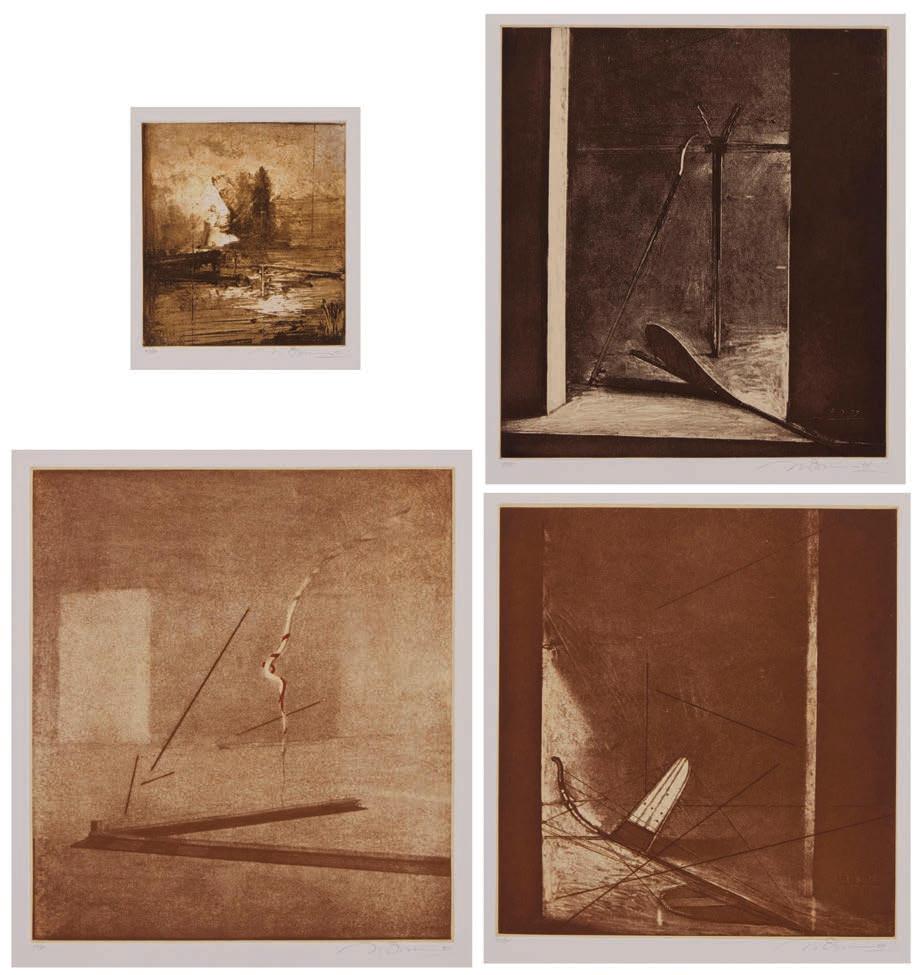
Nathan Oliveira (1928-2010)
“Revisited” portfolio, 1994
The complete suite of four photo-electric intaglios with hand-coloring on BFK Rives with Kitakata Chine collé paper Edition: 47/80
Each plate signed, dated, and numbered in pencil in the lower margin: N. Oliveira 94; Michael Costello and Jeffery Morin, prntrs.; Hand Graphics, Santa Fe, NM, pub., each plate with their blindstamp at the center of the lower margin edge; the title page, four plates, and the colophon, each loose, together with the original interleaving tissues
Plate of smallest: 6.5” H x 5.75” W; Plate of largest: 11.75” H x 10.5” W; Each Sheet: 22.25” H x 19.5” W
$1,000-1,500
Notes:
This lot is accompanied by a small pamphlet from the publisher, Hand Graphics, detailing the portfolio.

Nathan Oliveira (1928-2010)
“Duoro Valley,” 1997
Monotype with hand-coloring on wove paper
Signed, dated, and inscribed “IX” in pencil at the lower sheet edge: N. Oliveira 97; Tamarind Institute, Albuquerque, NM, prntr./pub., and with their blindstamp lower left Image/Sheet: 22.25” H x 30” W
$600-800

Marcus Leatherdale (1952-2022)
“Copper Sentry,” 1988
Screenprint in colors, copper leaf, and oil on linen
Signed, titled, and dated verso: Marcus Leatherdale 1988
Image: 32” H x 30.25” W; Overall: 48” H x 46” W
$800-1,200
Provenance:
The Peter Allen Collection
Private Collection, Palm Springs, CA, acquired from the above
Notes:
This work is one from a small number of variations by the artist. For example, we are aware of another iteration of this image printed with the same dimensions in the same year. It is also screenprinted, however, its copper-toned background is part of the screenprinting and is done on a sheet of paper measuring 40” H x 40” W. The example offered here uses actual copper leaf, screenprinting, and oil pigment on linen measuring 48” H x 46” W.

24
Larry Rivers (1923-2002)
“Homage to Picasso,” 1994
Screenprint in colors on paper Edition: 23/30
Signed, dated, and numbered in pencil in the lower left and right corners of the image, respectively: Larry Rivers ‘94
Image: 23.875” H x 27.875” W; Sight: 25” H x 29” W
$400-600

Mary Heilmann (b. 1940)
“Acid Line Up,” 2006
Aquatint with spit bite and sugar lift in colors on wove paper Edition: 8/15
Initialed, dated, and numbered in pencil in the lower margin: MH 06; Catherine Brooks, prntr.; Crown Point Press, San Francisco, CA, pub., and with their blindstamps in the lower right margin corner
Plate: 15” H x 11” W; Sheet: 21.5” H x 17” W
$500-700
Provenance:
Häusler Contemporary, Munich, Germany, and Zürich, Switzerland Private Collection, Los Angeles, CA, acquired from the above
John Baldessari (1931-2020)
“Two Opponents (Blue and Yellow),” 2004
Screenprint in colors on wove paper
Edition: 98/165 (there were also 24 artist’s proofs)
Signed, dated, and numbered in pencil at the center of the lower edge: Baldessari 04; Gemini G.E.L, Los Angeles, CA, prntr./pub., and with their blindstamp, lower right Image/Sheet: 12” H x 12” W
$3,000-5,000
Literature: Coplan-Hurowitz 148; Gemini 2014


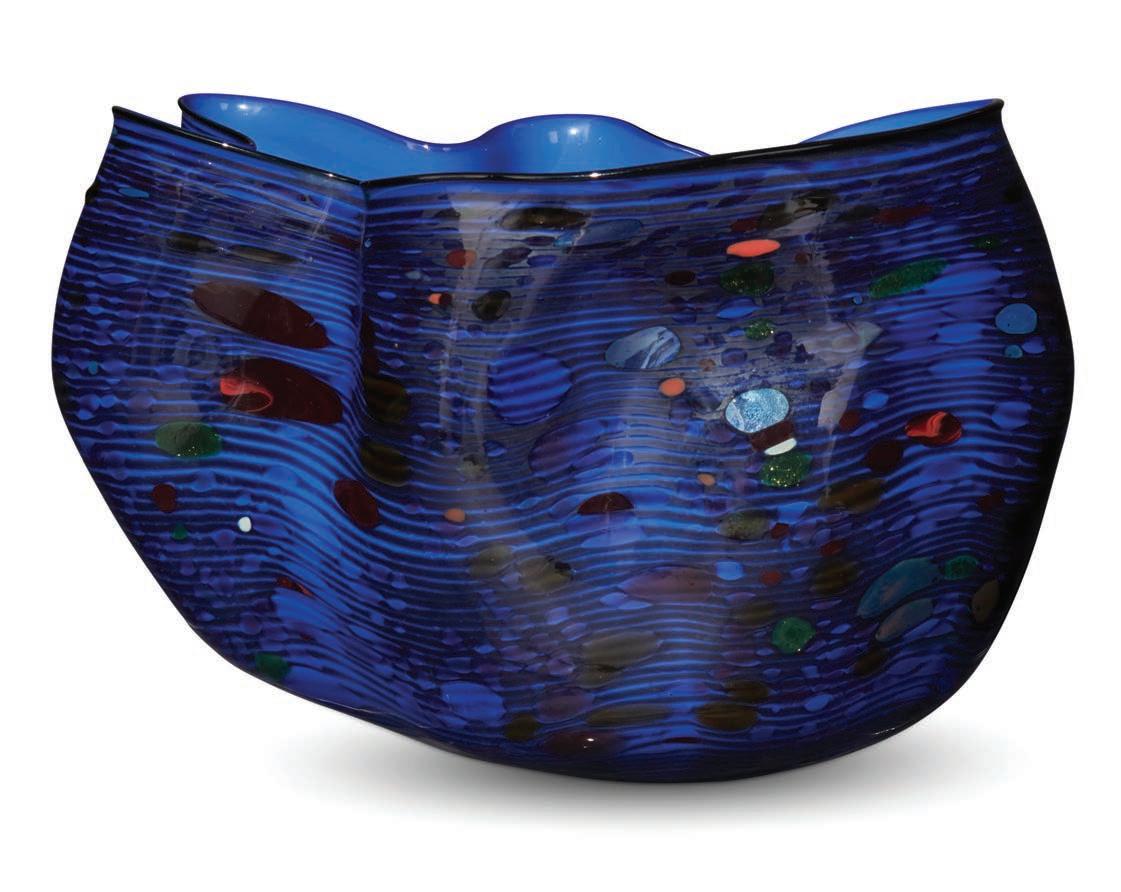
27
Dale Patrick Chihuly (b. 1941)
Cobalt Blue Macchia, 1982 Glass
With etched signature and date to underside: Chihuly / 1982
7.25” H x 10.75” W x 7” D
$3,000-5,000
Provenance: Private Collection, Carlsbad, CA
Dale Patrick Chihuly (b. 1941)
“Carnival Macchia,” 2004
Glass
With etched signature, inscription and date to underside: Chihuly / PP04 [Portland Press]
10.125” H x 12.25” W x 10.5” D
$3,000-5,000
Provenance: Private Collection, Carlsbad, CA


29
After Keith Haring (1958-1990)
“Party of Life” Jigsaw Puzzle, 1987
Screenprint on 100 jigsaw puzzle pieces
Signed, dated, and inscribed to underside of box: [figural drawing] / K. Haring / 87
Box: 1.625” H x 4.125” W x 4.125” D; Assembled: 7” H x 7” W
$1,000-1,500
Notes:
This lot is accompanied by a letter from Burnham-Callaghan Associates that was included with this puzzle as an invitation to an event and press conference at The China Club, held on Wednesday, February 4, 1987.

Andy Warhol (1928-1987)
“The Philosophy of Andy Warhol (From A to B and Back Again),” 1975 Hardcover book
Warhol, Andy. “The Philosophy of Andy Warhol (From A to B and Back Again).” New York and London: Harcourt Brace Jovanovich, 1975
Signed and inscribed with tomato soup can drawing by the artist: Sylvia and Mae / [soup can] / Campbells / Tomato / Soup / Andy Warhol
First Edition, Fifth Printing
8.625” H x 5.875” W x 1.125” D
$1,500-2,500
Notes:
The present book features an original Warhol inscription, signature and ink sketch of a Campbells Tomato Soup can covering the title page.

Mary (Sister) Corita Kent (1918-1986)
“Words of Ugo Betti: Innocence and the Process of Justification in the Late Plays of Ugo Betti,” 1965 The complete portfolio including eight screenprints in colors on 3M Art Fabric paper Edition: 77/275
Each of the screenprints signed in the image in ink: Sister Mary Corita IHM [Immaculate Heart of Mary]; loose, as issued, presented together within the protective section at the back of the original bound portfolio with text quoting the plays of Ugo Betti, and an essay by Sister Marie Fleurettte IHM; signed in ink by both of the Sisters just mentioned, and also numbered in ink, all on the colophon page; Plantin Press, Los Angeles, prntr.; Immaculate Heart College Press, Los Angeles, CA, pub.; all of the loose prints and the bound text presented within the original, red cloth-covered boards Image/Sheet of eight screenprints: 17” H x 13.25” W (or reverse)
$3,000-4,000



32
Mary (Sister) Corita Kent (1918-1986)
“All The Nations Shall Come,” 1955
Screenprint in colors on paper
From the edition of unknown size
Signed and titled in pencil in the lower margin: Sister Mary Corita IHM [Immaculate Heart of Mary]; titled in another hand on the frame’s backing paper
Image: 15.5” H x 21.5” W; Sight: 16.5” H x 22.5” W
$600-800

Peter Max (b. 1937)
“Deco Lady,” 1983
Lithograph in colors on paper
Edition: A/P (an artist’s proof; there was also a numbered edition of 75)
Signed and dated lower right: Max / 1983; numbered in pencil and with the artist’s copyright blindstamp lower left
Sight: 40” H x 29” W
$800-1,200
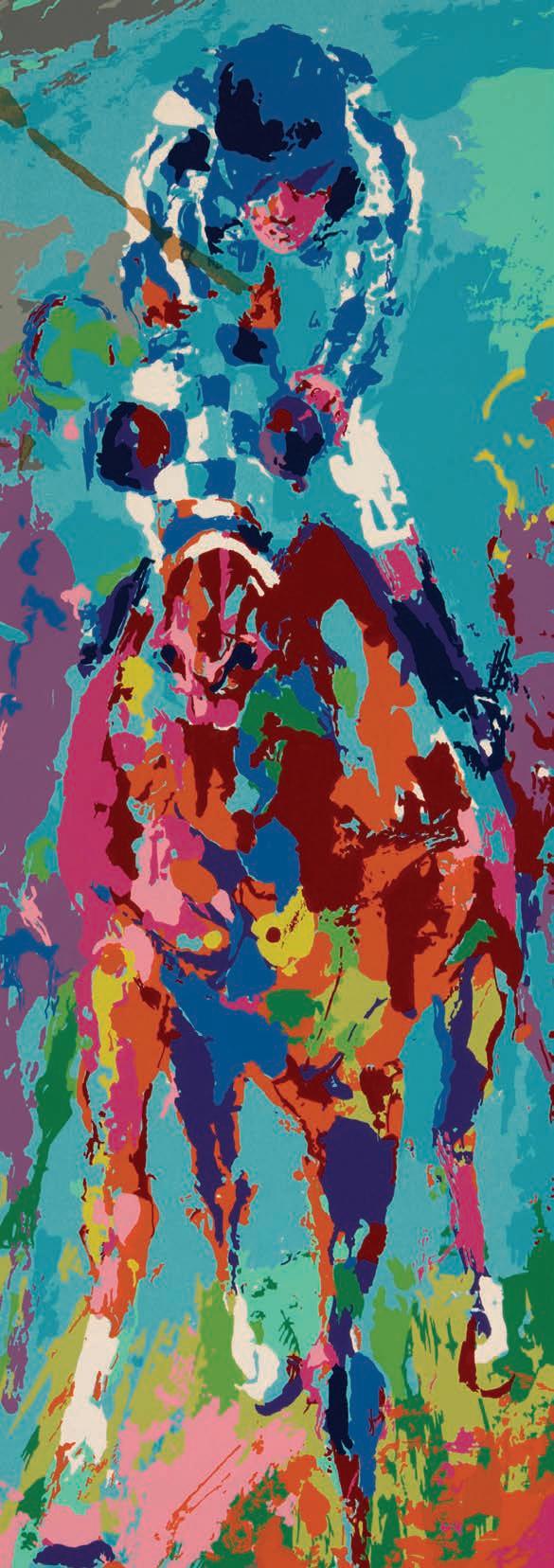
Leroy Neiman was a renowned American artist life. Born in 1921 in Saint Paul, Minnesota, Neiman excitement of live events, from boxing matches He became a public icon through his long association Olympic Games, Super Bowls, and other major including the LeRoy Neiman Center for Print Studies movement, and popular culture.
artist known for his vibrant, energetic depictions of sports, entertainment, and modern Neiman gained fame for his bold colors and dynamic brushwork that captured the matches to jazz performances.
association with “Playboy” magazine and served as the official painter for multiple major events. Neiman left a lasting legacy through both his artwork and philanthropy, Studies at Columbia University. His work remains a vivid celebration of life,
34
LeRoy Neiman (1921-2012)
“Happy Birthday, Mr. President” Screenprint in colors on wove paper Edition: 463/600
Signed and numbered in pencil in the lower margin: LeRoy Neiman Image: 35.75” H x 32.125” W; Sight: 38.5” H x 33.75” W
$1,200-1,800

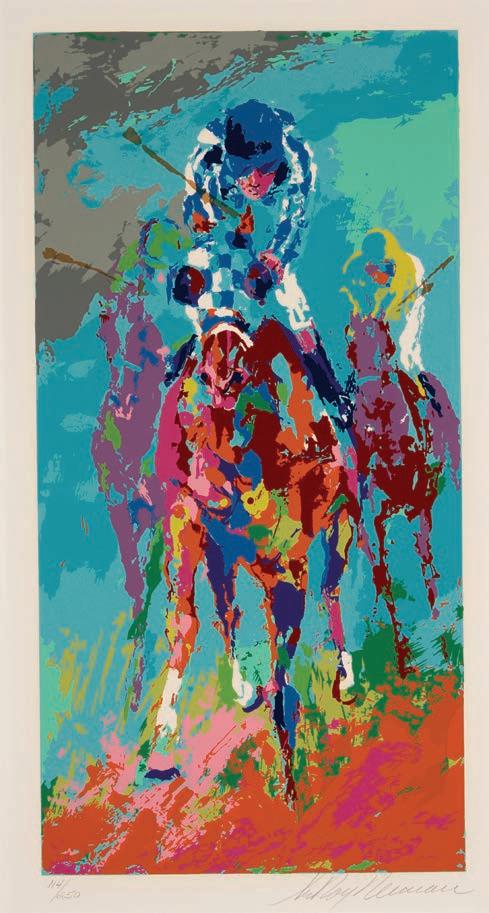
35
LeRoy Neiman (1921-2012)
“Secretariat II,” 1990
Screenprint in colors on paper
Edition: 114/250
Signed and numbered in the lower margin: LeRoy Neiman
Image: 24” H x 12.125” W; Sight: 26.25” H x 14” W
$800-1,200

36
LeRoy Neiman (1921-2012)
“Celebrity Night at Spago’s,” 1993
Screenprint in colors on paper
Edition: 192/600
Signed and numbered in pencil in the Image: 24.75” H x 37.25” W; Sight:
$800-1,200


Wallace Berman was an American visual artist and pivotal for his experimental collage, film, and assemblage works.
Born in 1926 in Staten Island, New York, Berman’s family him to the vibrant, multifaceted culture of Southern California, classes at Jepson Art Institute and Chouinard Art Institute introducing him to start creating sculptures from wood influenced by the jazz scene, the writings of the Beat particularly the Kabbalah (a mystical interpretation of to mysticism and the esoteric helped shape his approach resonance in themes of transcendence, spirituality, and
It was this time during the late 1950s, ‘In a letter to Wallace change—a quality that shaped his life as an artist. This
“No hope in making, assembling, binding together
sleeping poet; on the streets; beneath the sea; in levels, Reconsider the wind that moves flags, touches tents:
Wallace Berman is often credited with the technique modern photocopier. This technology enabled him to symbols. By layering and combining diverse imagery, society. His collages often feature hand-held transistor communication that transcends physical space, echoing as both a powerful force for unity, as well as a tool of creating a language through various images. Additionally, heritage and interest in Kabbalistic imagery gave his of the universe’s hidden meanings. In his collages, Berman representations of cosmic and spiritual principles. It was esoteric sources, drawing viewers into a meditation on
On February 18, 1976, in the early hours of his 50th Canyon home. Despite his limited commercial success photo collage techniques, and he is widely recognized authenticity and unconventionality that made his art of numerous exhibitions and retrospectives, solidifying
pivotal figure in the California counterculture scene of the 1950s and 1960s, and often known works.
family moved to Boyle Heights, Los Angeles when he was a child. This relocation introduced California, which later became an essential component of his creative output. After attending Institute in the 1940s, Berman worked at a factory furnishing store for a few years, thus wood scraps and becoming a full-time artist in the early 1950s. Additionally, Berman was heavily Beat poets (therefore becoming involved in the ‘Beat Movement’), and by Jewish mysticism, of Judaism to understand the divine world and the purpose of human life). Berman’s attraction approach to art, leading him to seek meaning beyond conventional boundaries. He found and inner consciousness, all of which would find expression in his later work.
Wallace Berman from the poet, David Meltzer who captured Wallace’s fluid openness to This openness recalls the layered, transformative imagery often seen in Berman’s work.
ornate bibles of history. The clues are found everywhere: outside the printed word; inside the levels, stratum, the years of a desert; and aurora around all the dead we bury within ourselves. tents: an invisible snake running thru the grass,” (Artforum, Merril Greene).
technique of photocollage, particularly through his use of the Verifax copier, a forerunner to the to create collages that juxtaposed images from popular culture, media, and religious imagery, Berman reflected and critiqued the commercialization and contradictions of modern transistor radios displaying various images instead of speakers, representing a form of echoing the spiritual and mystical undertones of his pieces. Berman saw mass communication of manipulation, questioning its duality by inserting various symbols within the radio, thus Additionally, Berman’s work often explored the mystical and spiritual entities of life. His Jewish pieces a symbolic depth that reflected his quest for enlightenment and understanding Berman would incorporate Hebrew letters, not simply as linguistic symbols but as was these elements above that merge with symbols from advertising, religious texts, and on the pervasive impact of mass media on consciousness.
birthday, Wallace Berman was tragically killed in an automobile accident near his Topanga success during his lifetime, Berman is now celebrated as one of the fathers of the assemblage and recognized as an artist who bridged the Beatnik and hippie countercultural movements. It was his transformative. In the years following his sudden death, Berman’s work has been the subject solidifying his place in the history of American art.
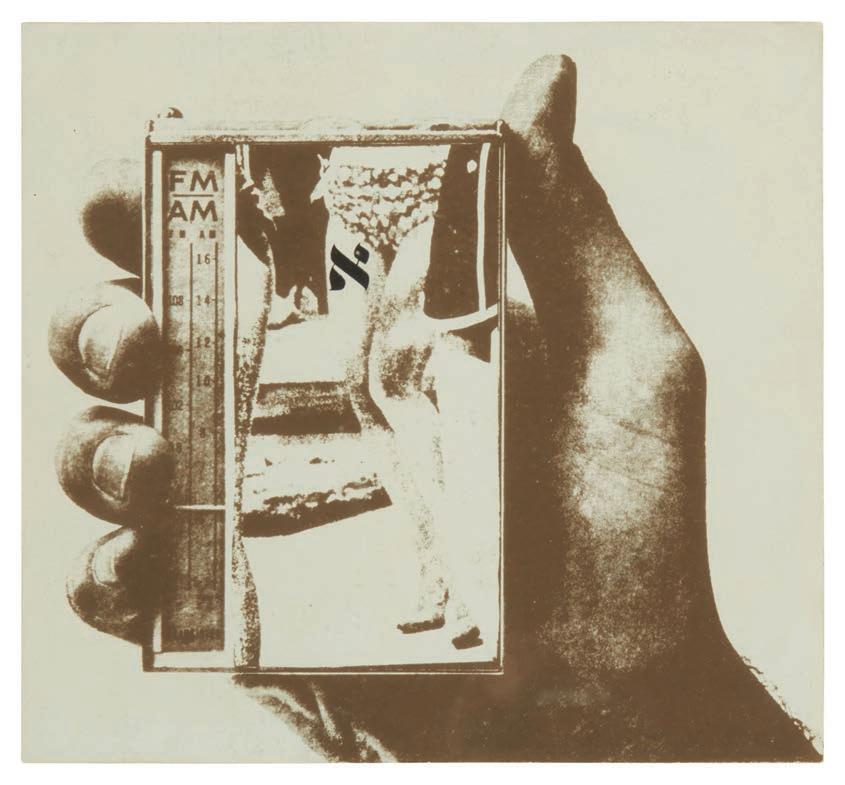
37
Wallace Berman (1926-1976)
Untitled, circa 1965
Verifax collage and acrylic on paper laid to board
Appears unsigned; attributed and dated on a gallery label affixed to the frame’s backing board
5.75” H x 6” W
$3,000-5,000
Provenance:
Property from the Estate of Teri Garr, Los Angeles, CA
Exhibited: Michael Kohn Gallery, Los Angeles, CA

38
Alfred Wertheimer (1930-2014)
“Elvis on the Train Home from New York to Memphis,” 1979 Gelatin silver print on paper mounted to mat board Appears unsigned Sight: 13.125” H x 8.75” W
$1,000-1,500


39
George Tice (b. 1938)
“Rooftops, 21st. Ave. & King St., Paterson, N.J.,” from the “Paterson” portfolio, 1969 Platinum print on paper mounted to thin matboard, as issued Signed in pencil in the lower right of the matboard: Geo. A. Tice; titled in pencil on the verso of the matboard, along the upper edge
Image/Sheet: 7.625” H x 9.625” W; Matboard: 14” H x 17” W
$1,000-1,500
40
Joel D. Levinson (b. 1953)
“Untitled, number 11; 17; 18; 21; 26; 35; 49; 50; 52; 54; 56; 60; and 63,” from the “California Flea Market” series,” 1975-77
13 gelatin silver prints on paper mounted to thin matboard, as issued
Each signed, dated, and with the artist’s copyright in ink on the verso of the matboard mount: Joel D. Levinson, 1977 ©; each also titled and dated (ranging from 1975-1977) in pencil on the verso of the matboard mount, presumably in another hand
Each image/sheet: 9.75” H x 11.75” W (or smaller and/or reversed); Each matboard mount: 14” H x 17” W (or reversed)
$1,500-2,500
Provenance:
Mr. and Mrs. David C. Ruttenberg
Palm Springs Art Museum, Palm Springs, CA, gift from the above
Notes:
All works in this lot are copyrighted 1977, however their individual negative dates vary as follows:
“Untitled, number 11; 17; and 18” are individually dated 1975
“Untitled, number 21, 26; and 35” are individually dated 1976
“Untitled, number 49; 50; 52; 54; 56; 60; and 63” are individually dated 1977





Marina Abramovic, born in Belgrade in 1946, stands from the fringe into a deeply personal, durational, influenced by Eastern spiritual traditions, Abramovic’s and the fraught relationship between artist and audience. sometimes confrontational, and always rooted in
A critical chapter in her career began in 1976, when similarly interested in identity and duality. Over the Other,” and blurring gender, selfhood, and authorship. their bodies to test thresholds of trust, confrontation, and ultimately “The Lovers,” in which they walked performance art’s capacity for lived symbolism.
Alongside their performances, Abramovic and Ulay which occupied a hybrid space between documentation cameras, transformed ephemeral actions into iconic, Polaroids functioned as constructed identities—deliberate, tableaux that echoed their thematic concerns: duality, meticulous - capturing Abramovic in a state of constructed
In recent years, Abramovic has continued to push retrospective, “The Artist Is Present,” held at the museum and introduced her to a global audience. duration performance and interdisciplinary collaboration. history to be given a solo exhibition in its main galleries—an broader canon of contemporary art. Today, she remains spiritual endurance, continuing to question what
stands as one of the most influential figures in performance art, transforming the medium durational, and widely institutionalized practice. Rooted in the post-war Yugoslav avant-garde and Abramovic’s work consistently interrogates the limits of the body, the endurance of the mind, audience. Her art is not about representation, but about experience—often visceral, presence.
when she met and began collaborating with Ulay (Frank Uwe Laysiepen), a German artist the next twelve years, the duo developed a radical joint practice, calling themselves “The authorship. Their performances were marked by physical rigor and emotional intensity, using confrontation, and interdependence. Works like “Relation in Time,” “Breathing In/Breathing Out,” walked from opposite ends of the Great Wall of China to say goodbye, are emblematic of
Ulay made a significant body of photographic work, particularly large-format Polaroids, documentation and performance. These monumental prints, made using 20x24 Polaroid iconic, almost sculptural portraits. Rather than merely illustrating past performances, the identities—deliberate, performative, and mythic. They were not snapshots but highly controlled duality, ritual, and transformation. The process itself was performative - immediate yet constructed presence.
push the boundaries of performance within institutional frameworks. Her landmark Museum of Modern Art in New York in 2010, brought performance into the heart of the audience. She has since founded the Marina Abramovic Institute, a space dedicated to longcollaboration. In 2023, she became the first woman in the Royal Academy of Arts’ 250-year galleries—an honor that affirmed her position not only within performance but within the remains an active and often polarizing figure, exploring themes of legacy, mortality, and it means to be present in an increasingly distracted world.

41
Ulay (1943-2020) & Marina Abramovic (b. 1946)
Portrait of Marina, 1988 Polaroid print in colors on paper
Signed, dated, and partially inscribed indistinctly, all slightly faint in the lower margin: Marina Abramovic / Ulay / 1988 / “For Tara and Burnett / from Marina” Image: 26.5” H x 21.875” W; Sheet: 29.5” H x 22” W
$10,000-15,000
Provenance: The artist Burnett Miller Gallery, Los Angeles, CA, acquired from the above
Exhibited: Los Angeles, CA, Burnett Miller Gallery, “Recent Works,” January 22-February 20, 1988
42
Kim Weston (b. 1953)
“Print-of-the-Month Portfolio,” 2010
The complete set of 12 gelatin silver prints on paper mounted to board mounts, as issued
Each print signed in pencil on the board mount, lower right: Kim Weston; the title page signed in red ink and dated “2010” in pencil; the title page and 12 prints, each loose, and the original interleaving tissues, all housed together in the original, black, cloth-covered portfolio, as issued
Image/Sheet of each: 9.75” H x 7.75” W (or reverse); Board Mount of each: 18” H x 15” W (or reverse)
$800-1,200



43
Brett Weston (1911-1993)
“Dunes, Baja,” 1968
Gelatin silver print on paper mounted to mat board, as issued
Signed and dated in pencil along the lower edge, at right, of the matboard: Brett Weston 1968
Image/Sheet: 7.625” H x 9.625” W; Matboard: 13.25” H x 15” W
$1,000-1,500

44
Lucien Clergue (1934-2014)
“Nu à la Plage”
Gelatin silver print on paper mounted to paper, as issued Edition: 18/50
Signed and numbered in pencil in the lower portion of the paper mount, directly below the image at right and left, respectively: Lucien Clergue
Image/Sheet: 11.625” H x 15.5” W; Paper mount: 14.25” H x 17.375” W
$700-900

45
Andre Masson (1896-1987)
“Massacre,” 1935
Pastel on off-white laid Ingres d’Arches MBM paper
Signed in pencil lower right: Andre Masson; titled and dated on a label affixed to the frame’s backing paper
Sheet: 19” H x 25” W
$2,500-3,500
Provenance: Arnold Herstand & Co, New York, NY

46
Claude Buck (1890-1974)
“The Wave Spirit,” 1939 Oil on board
Signed and dated lower right: Claude Buck / 1939; titled, dated again, and inscribed, all verso: “Background / changed from / original with / crescent moon / This is same painting” 30” H x 22” W
$1,000-1,500
Provenance:
Sold: John Moran Auctioneers, Pasadena, CA, June 15, 1993, Lot 138
Sold: John Moran Auctioneers, Pasadena, CA, October 20, 1998, Lot 85

47
Edward Biberman (1904-1986)
“Fisherman Three” Oil on Masonite
Signed lower right: Biberman; signed again and titled on the frame’s verso 24” H x 32” W
$2,500-3,500

Raymond Howell (1927-2002)
San Francisco skyline with the Golden Gate Bridge Oil on Masonite
Signed lower left: Raymond Howell 24” H x 36” W
$2,000-3,000
49 Mher Abeghyan (1909-1994)
“Green Mountains,” 1969 Oil on canvas
Signed in Armenian and dated lower left: M. Abeghyan 1969; signed and dated again, and titled, all in Russian, verso 32.5” H x 24.25” W
$3,000-5,000




Minas Avetisyan was born in 1928 in the village of daily rhythms of his hometown appeared throughout In 1960, he moved to Yerevan and held his first solo brought him widespread recognition as a bold and
Avetisyan’s style was marked by wild, expressive of Fauvism yet remained rooted in Armenian tradition. successor to Martiros Saryan, both in his palette public art, designing the set for Aram Khachaturian’s
In 1972, a fire destroyed much of his studio and many short life, Avetisyan left behind a powerful body a tribute to an artist whose vision remains deeply
of Jajur, Armenia, a place that remained central to his life and art. The landscape and throughout his paintings and played an active role in shaping the themes and identity of his art. solo exhibition; two years later, his participation in the “Exhibition of Five” in Yerevan and original voice in Soviet Armenian art.
brushwork and vivid, clashing colors. His brilliant use of color aligned him with the spirit tradition. He drew inspiration from medieval manuscripts and folk art, and saw himself as a and his devotion to capturing the Armenian soul. Avetisyan also worked in theater and Khachaturian’s “Gayane” ballet and completing large murals in Gyumri.
many of his finest works. He died tragically in 1975, just three years later. Yet, despite his of work that continues to influence Armenian art. His house-museum in Yerevan stands as deeply cherished.
50
Minas Avetisyan (1928-1975)
“Autumnal Jajur,” 1973 Oil on canvas
Signed in Armenian and dated lower left: Minas 73; signed and dated again, and titled, all in Armenian, verso 23.75” H x 31.5” W
$8,000-12,000
Notes:
This lot is accompanied by a certificate of authenticity in Russian signed by Gayane Avetisyan-Mamajanyan and Arman Avetisyan.





Ottone Rosai was a 20th century Italian painter and graphic artist who people in and around his Florentine birthplace. The average viewer characterized by a minimalist approach to detail, with strong outlines, brush strokes. Futhermore, rather than focusing on the classic landmarks, Rosai typically presented stylized street views of modest houses and neighborhood cafes or taverns. Frequently devoid of any real sense fact that the people, when shown, tend to be stiff and fairly expressionless,
Regardless of Ottone Rosai’s lack of interest in using Florence’s immediately atmosphere and time during which he lived there impacted his thinking would join him in the family business, however, it was clear as a teenager focusing on working alongside his father.
In 1910, when Rosai was 15 years old, he realized his dream of enrolling fellow students and instructors, and was soon expelled for misbehaving.
Cezanne, and then, after becoming acquainted with the movement’s Gino Severini, and the journal “Lacerba,” he became interested in interest in the tenets of Futurism was relatively short-lived, and yet, final working style. Reflecting back on his brief association with the of forms and colors.”
The dynamism of the Futurist movement in Florence also helped propel war, his outlook on life was both more mature and more somber. Soon was obliged to temporarily return to his father’s business in order to with these major life experiences behind him and a more grounded lasting influences on his mature style was again found by Ottone Rosai the 14th and 15th century masterpieces painted by his Tuscan predecessors and chapels.
Ottone Rosai had a multi-faceted life beyond his career as a painter as in Zurich, Madrid, Paris, and London. A Fascist supporter during avoid a public scandal. In 1942, he became Chair for the painting division several decades earlier. Both of the works in this auction have an authentication this same feature, probably because Rosai’s unexpected death from Bertolini and his relationship with Rosai, except that he has been described
Public institutions with works by Ottone Rosai in their permanent Museum, and New York’s Museum of Modern Art.
who spent the majority of his relatively short life creating timeless images of streets, architecture, and viewer would be forgiven, however, for not recognizing Florence in his images. This is because Rosai’s works are outlines, simplified, volumetric forms, and a muted color palette applied with carefully controlled, painterly landmarks, panoramic views, art treasures, or fashionable inhabitants of this famous city as his subjects, and town squares, or small groups of working class people walking or seated at small tables suggestive of sense of the time of day, season, or atmosphere, there is often a brooding, moody quality to his scenes. The expressionless, can evoke a sense of loneliness or isolation.
immediately recognizable features as the subjects of his artworks, there is no doubt that the artistic thinking and work. His father was carpenter who owned his own shop in Florence and hoped that Ottone teenager that his son was more interested in observing and sketching his surroundings than he was in
enrolling at the Academy of Fine Arts in Florence, but he didn’t like the greedy, competitive tendencies of his ehaving. From then on, he was largely self-taught, turning first to an independent study of the works of movement’s founder, Filippo Tommaso Marinetti, member artists such as Ardengo Soffici, Umberto Boccioni, and the burgeoning Italian Futurist movement and exhibited with their group in Rome in 1914. Rosai’s artistic as with his even earlier admiration for Paul Cezanne’s paintings, much of it was eventually distilled into his Futurists decades later, he credited that interaction with helping him understand painting as “a discipline
propel Ottone Rosai into volunteering to fight in World War I. By the time he returned to Florence after the Soon thereafter, in 1922, feeling burdened by financial debt, Rosai’s father committed suicide, and Ottone to save it and to support his mother. Eventually, Rosai was able to return to his own career full time, and grounded sense of himself, he finally settled into a mature painting style. Interestingly, one of the final and most Rosai in his hometown. He developed a great appreciation for the order, solidity, and relative simplicity of predecessors such as Giotto and Masaccio which were on permanent display in some of Florence’s churches
painter and graphic artist who eventually achieved international success via exhibitions throughout Italy, as well the early 1920s, he was also a published novelist, an art critic, and a homosexual who married in order to division of Florence’s Academy of Fine Art, the very school from which he had been expelled as a student authentication statement and signature by Giovani Bertolini on their versos. Many of the artist’s works share from a heart attack in 1957 occurred when he was only 62 years old. Very little is known at this point about described as an art critic and friend.
collections at this time include Florence’s Uffizi Gallery, Rome’s Modern Art Museum, London’s British

51
House with a small tree Oil on canvasboard
Signed lower left: O. Rosai; inscribed with an authentication statement in Italian written and signed by Giorgio Bertolini, verso 27.5” H x 19.5” W
$8,000-12,000

Signed lower left: O. Rosai; inscribed with an authentication statement in Italian written and signed by Giorgio Bertolini, verso 27.5” H x 19.5” W
$8,000-12,000

53
Sujarit Hirankul (1946-1982)
“Siam,” 1979 Oil on canvas
Signed and dated lower right: Sujarit 1979; signed and dated again, titled, and inscribed in Thai, all verso 24” H x 28” W
$1,000-1,500
Provenance:
Sold: John Moran Auctioneers, Monrovia, CA, “Art + Design,” February 28, 2023, Lot 180

54
Nhek Dim (1934-1978)
Portrait of Cambodian women, 1964
Oil on canvas
Signed and dated lower right: Nhek Dim / 1964; signed and dated again, and inscribed with the artist’s address, all verso 24” H x 18” W
$2,000-3,000

55
Hong Viet Dung
(b. 1962)
Lady with a fan Oil on canvas
Signed lower right: Viet Dung
35.25” H x 35.25” W
$4,000-6,000

56
Jean Jansem (1920-2013)
Reclining nude
Watercolor and ink on paper
Signed lower left: Jansem
Image/Sheet: 19.625” H x 26.25” W
$800-1,200

57
Margo Hoff (1912-2008)
“Waterfall,” 1965
Oil and collage on Masonite
Signed lower right: Hoff; signed again and titled in pencil on the upper portion of the frame’s verso: M Hoff; titled again and dated 1965 on two gallery labels affixed to the frame’s verso
48” H x 36” W
$2,000-3,000
Provenance:
Banner Gallery, New York, NY
The Corcoran Gallery of Art, Washington, DC

58
George Stillman (1921-1997)
Untitled abstract, 1949
Oil monotype on rice paper laid to cardstock
Unsigned; dated on a gallery label affixed to the frame’s backing board
Sheet: 18” H x 12” W
$1,500-2,500
Provenance:
The Estate of George Stillman Carlson 20th Century Paintings, Carmel, CA

59
Raymond Parker (1922-1990)
“Bright Grey,” 1950 Oil and collage on paper
Signed and dated lower right: R. Parker 50; titled in pencil, verso Sheet: 13.25” H x 11.25” W
$2,000-3,000
Provenance: Carlson 20th Century Paintings, Carmel, CA

Thornton Willis (b. 1938)
Untitled, 1969
Mixed media on canvas
Signed, titled, and dated, verso: Thornton Willis ‘69 24” H x 24” W
$800-1,200
Provenance: Sold: Nye and Company, Bloomfield, NJ, “Estate Treasures Auction,” June 14-15, 2023, Lot 495
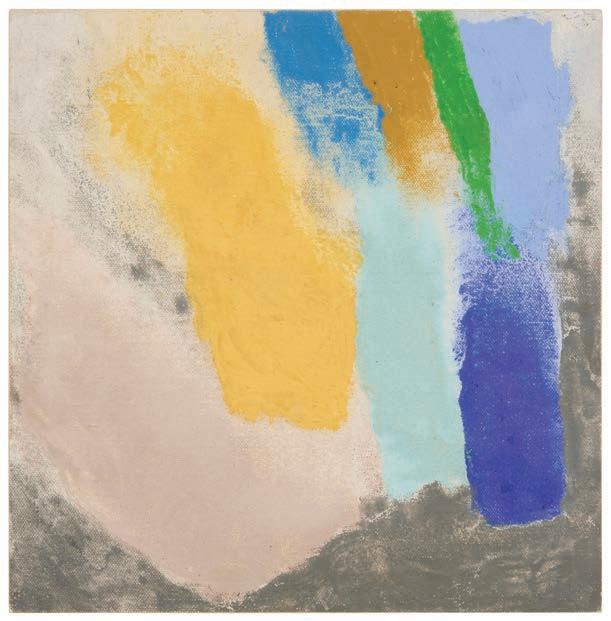
61
Friedel Dzubas (1915-1994)
“Alleman (sketch),” 1973
Acrylic on canvas mounted to board
Appears unsigned; titled and dated “73” in ink on a piece of the canvas cut from the work and affixed verso; titled and dated again on two gallery labels affixed verso 10” H x 10” W
$4,000-6,000
Provenance:
Loretta Howard Gallery, New York, NY
Yares Art Gallery, New York, NY
Private Collection
Sold: Wright, Chicago, IL, and New York, NY, “20th Century Art,” March 12, 2020, Lot 115

62
Robert Goodnough (1917-2010)
“Horses,” 1960
Oil on canvas
Signed and dated lower right: goodnough / ‘60; signed and dated again, and titled, verso 22” H x 28” W
$4,000-6,000
Provenance: K. Nathan Gallery, La Jolla, CA
Notes:
Robert Goodnough explored the concept of a group of horses in dynamic movement, or horses with riders, in degrees of representational to Cubist to completely abstracted compositions for over a decade between the late 1950s and early 1970s. An artist difficult to define but generally considered a second-generation Abstract Expressionist, Goodnough’s work, like the present painting, features kinetically calligraphic forms and loose, gestural brushwork that belies an underlying artistic discipline honed from his strong educational background studying under Amedee Ozenfant and Hans Hofmann.

John Charles Haley was born in Minneapolis, and Munich under German Modernist Hans Hofmann
After Haley returned to the US, he taught art in Minneapolis the University of California at Berkeley giving him
During the 1930s and 40s, Haley was known as an While teaching, he also exhibited his work with the focus had moved from the watercolor medium and post-wars shifts in artistic aesthetics, Haley experimented
Haley received numerous awards for his early career extraordinary forty-two-year period teaching at Berkeley, country and influencing a generation of artists including
Throughout his career, Haley tirelessly experimented changes in artistic style and focus. An artist difficult “What is enjoyable about Haley’s work is his deep
and studied at the Minneapolis School of Art in the 1920s. He continued his studies in Hofmann whose Cubist and Abstract Expressionist style had a profound influence on the artist.
Minneapolis before moving to California in 1930 where he became a Professor of Art at him a platform where he continued to promote Hofmann’s modernist ideas.
an innovative watercolorist and leader of the Berkeley School of Watercolor Painting. the California Watercolor Society beginning in 1942. By the mid-1950s, Haley’s style and and creating more regionalist-leaning works toward Abstract Expression. Responding to experimented with increasingly fragmented and abstracted compositions.
career watercolors and had a one-person show at the de Young Museum in 1980. After an Berkeley, Haley is credited with building one of the strongest art departments in the including Elmer Bischoff and Paul Wonner.
experimented in his work, trying new mediums to find fresh visions, and responding to external difficult to classify, “Artforum” art critic John Koplans wrote of Haley in the July 1962 issue, deep concern for painting rather than a search for a brand image.”

$5,000-7,000
Haley circa 1970 formed fiberglass titled and dated by repute x 2.75” D artist Art, Oakland, CA, acquired from the above Collection, Oakland, CA, acquired from the above

Venice, Italy-born abstract painter Gino Morandis
Accademia Clementina in Bologna in 1935. In Bologna
Morandis was actively exhibiting by the early 1930s, the 1935 II Quadrennial exhibition in Rome. In 1947 had his first solo exhibition at the Galleria dello Scorpione receive significant prices including the Saviat prize frescos for the Polyclinic of the University of Padua Rome Quadriennales between the 1930s and 1970s.
In earlier works Morandis experimented with color other abstraction and visual language influences
Morandis studied under Virgilio Guidi, first at the Academy of Fine Arts in Venice and then at the Bologna he also received lessons from Giorgio Morandi.
1930s, including at the 1932 Collective Exhibition of the Opera Bevilacqua La Masa and at 1947 Morandis received the Gino Rossi Prize at the Bevilacqua La Masa Foundation, and Scorpione in Trieste the following year. Critically acclaimed, Morandis continued to prize at the Michetti Prize in 1951 and in 1964 he was awarded commission the to create Padua in a national competition. Morandis participated in numerous Venice Biennales and 1970s.
color harmony in Cubist and Fauvist styles, but by the 1950s, his work was responding to including Lucio Fontana’s “Movimiento Spaziale.”
Gino Morandis (1915-1995)
“Immagine Spaziale M. 101,” 1962 Oil on canvas
Signed lower right: Gino Morandis; faintly signed again and inscribed “Venezia” verso; signed yet again, titled, and dated “1962” on two of the artist’s Venetian address labels, one affixed to the canvas and one affixed to the stretcher
40” H x 55” W
$6,000-9,000
Provenance:
Galerie Internationale, New York, NY
Property from the Collection of Buck Houghton, West Hollywood, CA, acquired from the above, circa 1960s
Notes:
Archible Ernest “Buck” Houghton (1915-1999) is today most often remembered as the producer for the first three seasons (1959-62) of “The Twilight Zone” television series.
This lot is accompanied by an illustrated flyer with an introductory paragraph written by Peggy Guggenheim for a May 1-14, n.d., exhibition at Galerie Internationale, 1095 Madison Avenue, New York, NY. The flyer states that the exhibition was “...organized with the collaboration of Mr. Carlo Cardazzo, Director of the Naviglio Gallery in Milan, and of the Cavallino Gallery in Venice.”



Josef Liesler was a born in the small town of Vidolice explored Surrealism in his work, as well as a graphic engineering school Architektury a Pozemního Stavitelství artists Cyril Bouda, Oldrich Blažícek and Josef Sejpka.
In 1938, the Munich Agreement was signed, which turned formed a protest group called “The Seven.” Though Salon in 1939, exhibiting works that depicted man’s
In the 1940s, Liesler explored themes of Surrealism, retrospectively at earlier artists such as Francisco Jose allegory. Allegorical images of monsters, ghosts, and Liesler had the freedom to reach new heights in his work influenced by Modern artists including Pablo Picasso, 1945.
Liesler was a founding member of the Czechoslovak focused on experimenting with new artistic forms and international fame and was elected a member of the Academy of Florence. He participated in the Venice
From the 1950s to about 1975, Liesler illustrated numerous
Vidolice near Kadan, Czechoslovia to German-born parents. He was a noted Czech painter who designer and illustrator. Liesler received his artistic training at the architectural and structural Stavitelství na Ceském vysokém ucení in Prague between 1934 and 1938, where he studied under Sejpka.
turned the Czech border region over to Hitlers’ Germany. In response, Liesler and fellow artists Though short-lived after disbanding in 1941, the group had one major show at the Prague Stocker humanity and dignity during war time.
branding his art “surreal reality,” in imagery that was colorful with bold outlining. He also looked Jose De Goya Y Lucientes and Honore Daumier, creating related themes of theater, music and and beasts, in particular, were a visual outlet to protest occupation and government oppression.
work post-war when he created imagery inspired by memory, fantasy and irony increasingly Picasso, and Salvador Dalí.. He also began teaching at the Czech Technical University in Prague in
art group the “58” who were active in the 1950s and 1960s. The group’s members were and challenging the prevailing artistic style of social realism. By this period, Liesler had achieved the Royal Belgian Academy and awarded Accademico Onorario (honorary member) of the Biennale three times, and had extensive international exhibitions.
numerous books, and after 1975 designed more than 100 stamps. Liesler died in Prague.

Josef Liesler (1912-2005)
“Nadia,” 1959
Oil on Masonite
Signed and dated lower right: Liesler 1959; signed and dated again, inscribed, and titled, all verso 39.25” H x 27.5” W
$5,000-6,000
Provenance: Galerie Art Praha, Prague
Notes:
This lot is accompanied by a copy of a sales invoice dated 22.08.2001 from the gallery mentioned above, and a copy of a letter in Czech from Prof. PhDr. František Dvorák confirming that this work is in the hand of the artist.
In the present portrait of a young woman seated at a table, the sitter’s expression is difficult to read, but she seems deep in thought, holding her head in her hands, her elbows leaning on the table’s patterned cloth. Painted with bold, confident linework, and layers of gestural patterning, the portrait of sitter “Nadia” is emotionally provocative and showcases the artist’s modernist style and artistic influences.
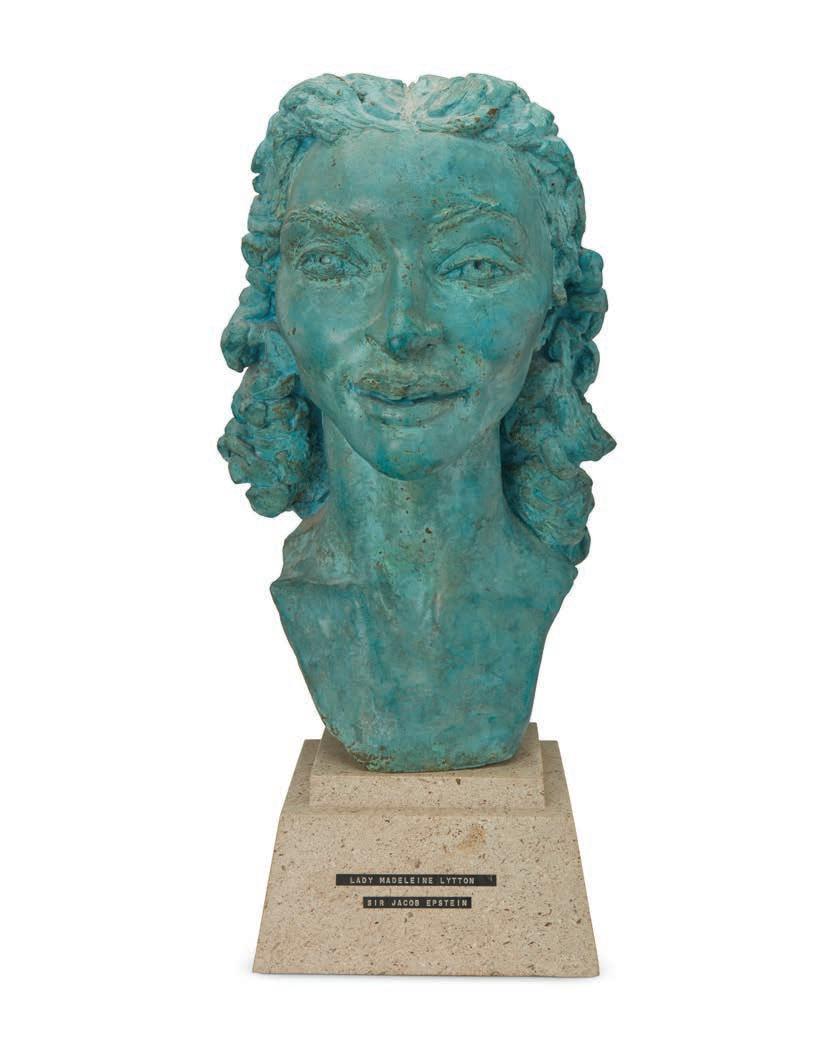
66
Sir Jacob Epstein (1880-1959)
“Lady Madeleine Lytton”
Verdigris patinated bronze on stone plinth
Bronze unmarked; attributed and titled to label applied to plinth Bronze: 15.25” H x 9” W x 10.5” D; Overall: 19.5” H
$3,000-5,000
Provenance: The Estate of Sir Jacob Epstein

67
Sir Jacob Epstein (1880-1959)
“Elsa”
Patinated bronze on stone plinth
Bronze unmarked; attributed and titled to label applied to plinth
Bronze: 15.75” H x 11.5” W x 11.25” D; Overall: 19.75” H
$2,000-3,000
Provenance: The Estate of Sir Jacob Epstein

68
Sir Jacob Epstein (1880-1959)
“H.I.M. Haile Selassie,” 1936
Patinated bronze on composite plinth
Bronze unmarked; attributed, titled, and dated to metal plaque applied to plinth Bronze: 11.5” H x 8” W x 9.125” D; Overall: 14.25” H
$2,000-3,000
Provenance: The Estate of Sir Jacob Epstein
Notes:
Haile Selassie I was Emperor of Ethiopia between 1930 to 1974.
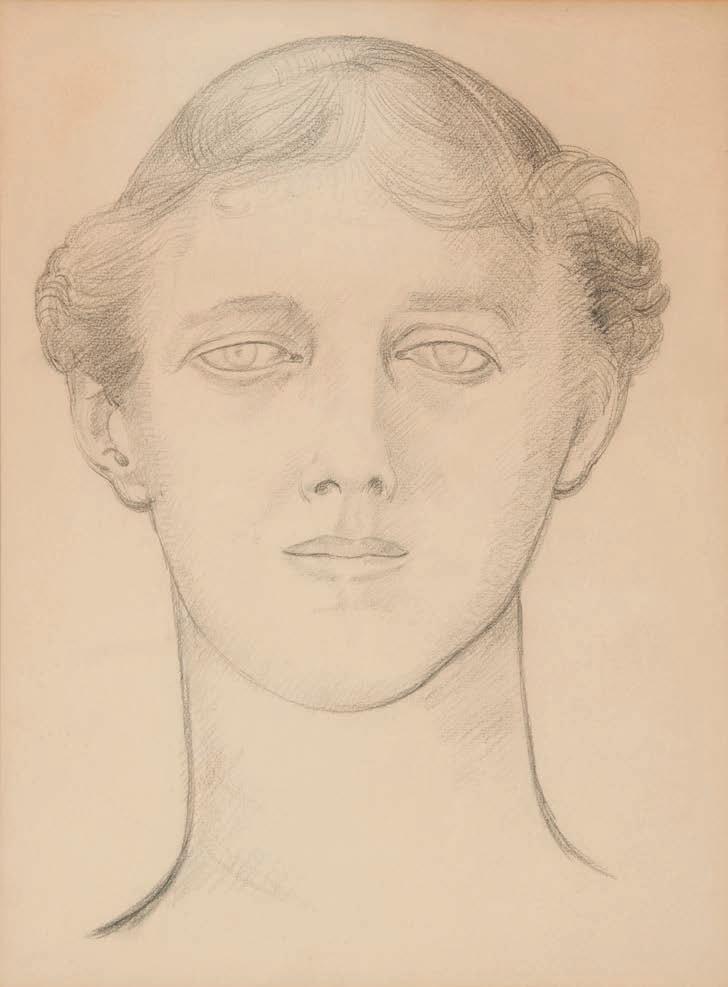
Sir Jacob Epstein (1880-1959)
“Study for a bust of Mrs. Francis Dodd”
Graphite on paper
Signed and titled in pencil, verso: Jacob Epstein
Sight: 16” H x 12” W
$700-900
Provenance: The Estate of Sir Jacob Epstein
Don Bachardy
(b. 1934)
Portrait of a man
Watercolor on paper
Signed lower right: Bachardy
Sight: 22” H x 14.75” W
$800-1,200





71
Earle Raine (1911-2005)
“Hula Hooey,” 1937
Watercolor, gouache, and traces of graphite on paper
Signed and dated lower right: Raine / 8-2-37; titled on a gallery label affixed to the frame’s backing board
Sight: 18.5” H x 13” W
$800-1,200
Provenance: Ralph Spano Antiques & Fine Art, Milwaukee, WI
72
Fannie Hillsmith (1911-2007)
“Tea Cups,” 1955
Oil, tempera, and sand on Masonite
Signed lower right: f. Hillsmith; signed again and titled verso; titled again and dated on a label affixed verso
7.75” H x 12” W
$1,000-1,500
Provenance: The Collection of Mrs. William P. House

Margaret Keane was an American artist with international figures with expressive “big eyes.” The large eyes paintings but also spoke to the profound and emotional I draw on my children are an expression of my own children, women, and animals—evoke an emotional her distinctive voice as an artist, Keane’s early career claimed credit for her work.
For years, Margaret painted in private while Walter “big eyes” paintings captured public fascination, revelation in the 1970s.
A 1986 courtroom showdown famously concluded behind the iconic works. Keane’s story is one of resilience brighter and more hopeful, reflecting her liberation. “Big Eyes,” which dramatized her struggles and
Margaret Keane’s legacy lies not only in her evocative creative identity. Her big-eyed figures continue to perseverance.
international acclaim, especially known for her signature style: haunting, melancholic eyes that Keane painted onto her figures not only intrigued those who viewed the emotional meaning Keane was imparting in her work. Keane once said, “The eyes own deepest feelings. Eyes are windows of the soul.” Her paintings—often of emotional vulnerability that resonated with audiences in the 1960s and beyond. Despite career was overshadowed by controversy, as her then-husband, Walter Keane, falsely
Walter marketed and sold the pieces under his name. The emotional intensity of the fascination, but the truth behind their creation remained hidden until Margaret’s public
concluded with a live painting challenge, where Margaret proved she was the true artist resilience and self-reclamation. After reclaiming authorship, her later works became liberation. In 2014, her life gained renewed attention with the release of Tim Burton’s film triumphs.
evocative and widely beloved artwork but also in her courageous journey to assert her to look out at the world with a depth of feeling that speaks to both pain and
Margaret Keane (1927-2022)
Girl playing jacks, circa 1965
Oil on canvas
Signed near the center of the right edge: Keane
28” H x 18” W
$5,000-7,000
Provenance:
Triton Museum of Art, Santa Clara, CA
Notes:
In “Girl Playing Jacks,” the single figure features Keane’s signature unblinking eyes that look directly at the viewer. The artist’s use of light, scale, and tone are displayed here as well, with the overall-clad young girl in a squat position as she plays jacks on a city sidewalk backed with a brick and plastered urban wall. The composition showcases Keane’s ability to blend innocence with emotional weight, emphasizing her distinctive approach to portraying the inner world of children.
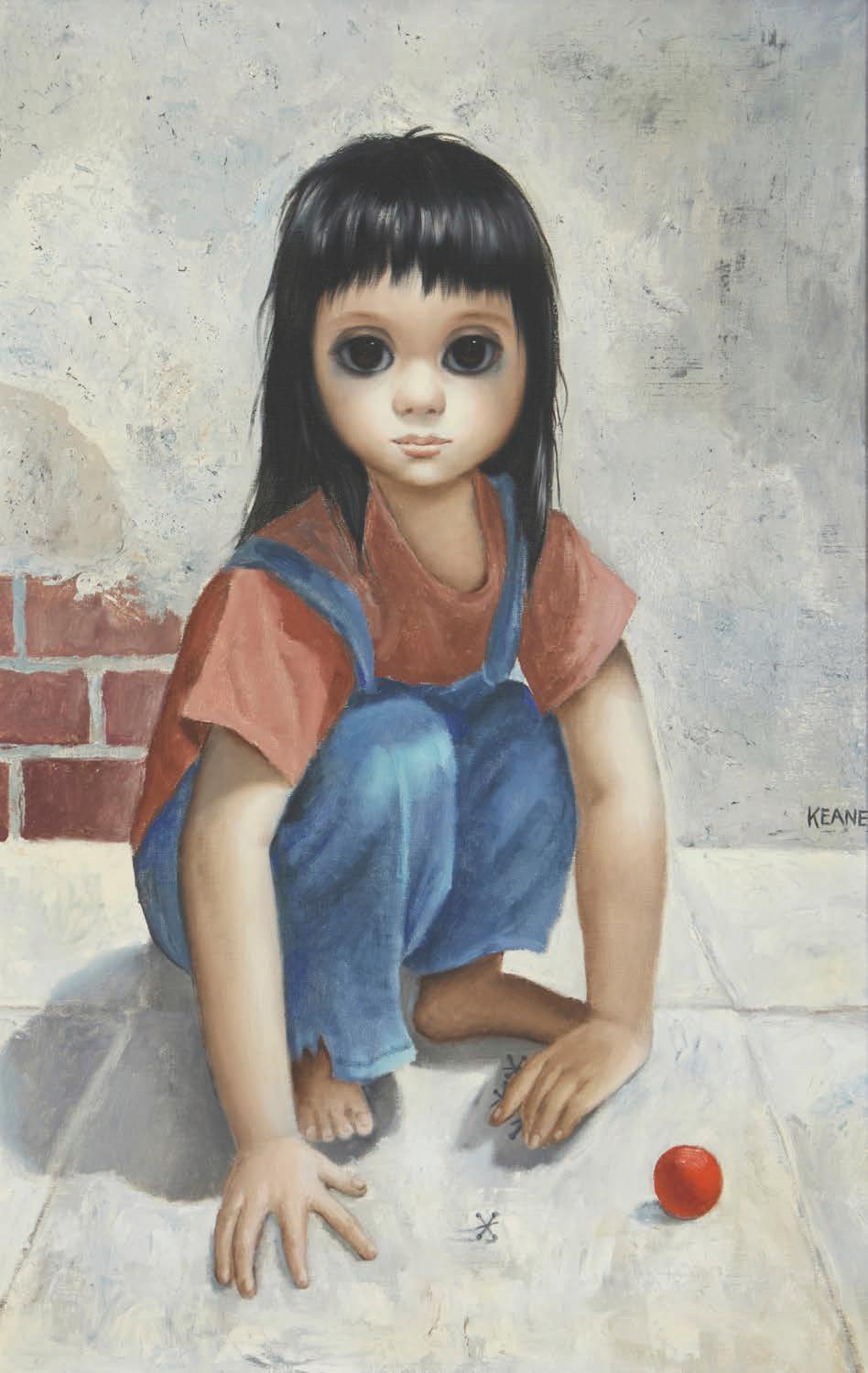
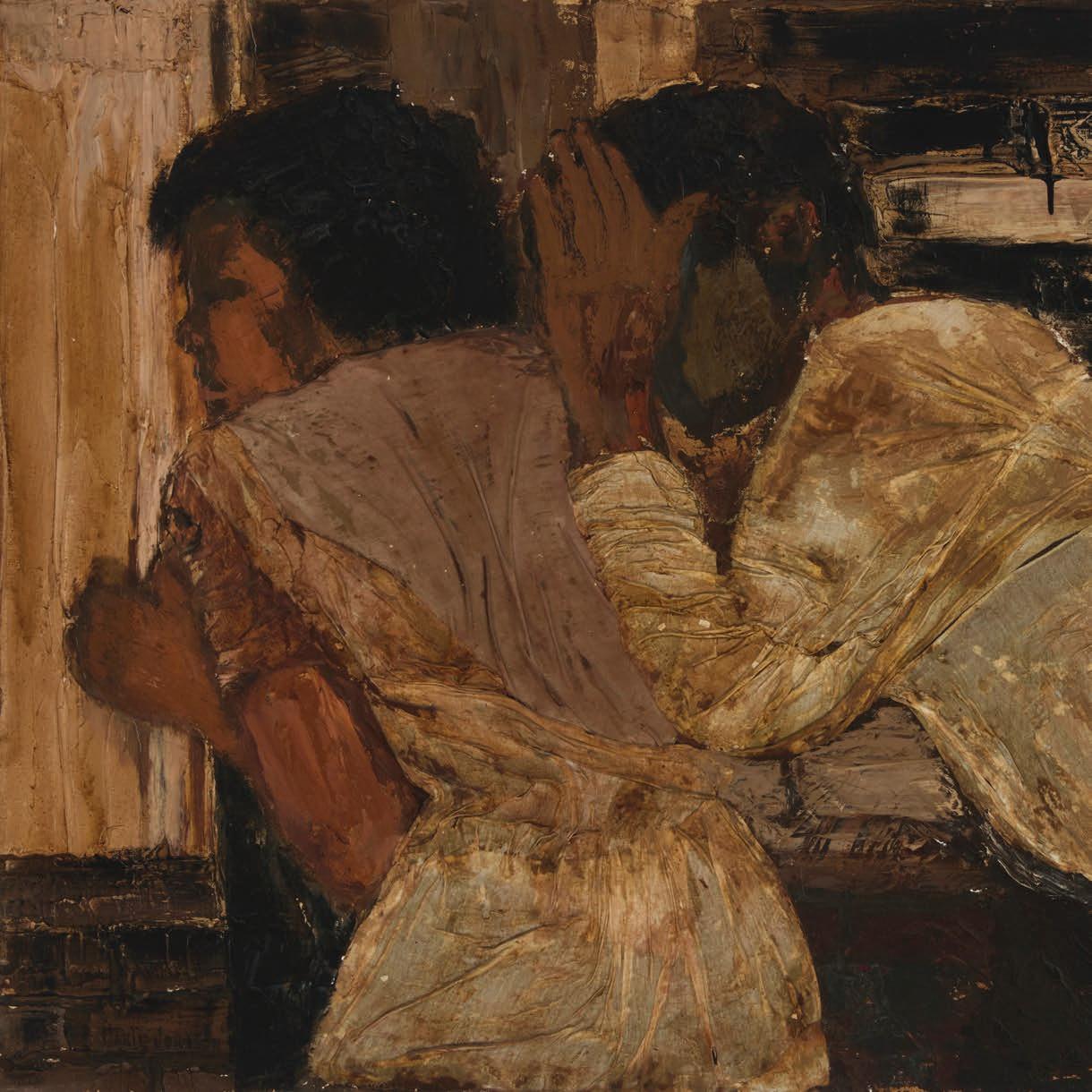

74
Marie Johnson-Calloway (1920-2018)
“Birmingham - After Life Mag.,” 1963
Oil and collaged fabric on canvas
Signed and dated lower left: Marie Johnson 63; titled verso; signed again and inscribed, then crossed out, on the stretcher: “For they know not what they do - After Life Magazine” 30” H x 40” W
$3,000-5,000
Provenance:
Triton Museum of Art, Santa Clara, CA
Notes:
This painting is based on a photograph in “Life Magazine,” taken on May 3, 1963 by Charles Moore, showing civil rights demonstrators being sprayed by high-pressure water hoses during a protest in Birmingham, Alabama.

Duilio (Dubè) Barnabè (1914-1961)
“Cardinal Rouge,” 1961 Oil on canvas
Signed lower right: Barnabè; titled and dated by repute 39.25” H x 25.5” W
$5,000-7,000
Provenance: R.S. Johnson International, Chicago, IL
Exhbited: Chicago, IL, R.S. Johnson Fine Art, “Barnabe in Retrospect,” Fall 1982, no. 59, illus. p. 30
Notes: The artist is also known as Dulio Barbade, Duilio Barnabe, Dulie Dube Barnabe, or simply Dube.
This lot is sold together with a copy of an invoice dated September 21, 1982, as well as an appraisal dated September 12, 2007, both issued by the gallery mentioned above.

76
Duilio (Dubè) Barnabè (1914-1961) St. Sebastian, 1953 Oil on canvas
Signed lower right: Barnabè; with the incised signature and number 64 in a circle, both possibly in another hand, on the central stretcher bar, verso; dated by repute 21” H x 13.75” W
$4,000-6,000
Notes:
The artist is also known as Duilio Barbade, Duilio Barnabe, Dulie Dube Barnabe, or simply Dube.

77
Galina (Gala) Didur (b. 1961)
“Morning Beauty”
Acrylic on canvas
Signed lower right: Didur; titled by repute 40” H x 30” W
$2,000-3,000
Provenance: Sold: Jasper52, New York, NY, “Investment Fine Arts from Rishon Art Gallery,” January 12, 2022, Lot 6

78
Polia Pillin (1909-1992)
Two women with birds
Gouache and watercolor on paper laid to board
Signed lower right: Polia Pillin
Sheet: 16.75” H x 11.375” W (irreg.)
$1,000-2,000

Signed with the artist’s pseudonym lower left: Pucci
15.75” H x 10” W
$800-1,200

Carlo Canevari (1922-1996)
Nun and Cardinal with umbrella
Oil on panel
Signed with the artist’s pseudonym lower left: Pucci
15.75” H x 10” W
$800-1,200

81
Carlo Canevari (1922-1996)
Cardinal and a demon in a tree
Oil on panel
Signed with the artist’s pseudonym lower right: Pucci 15.75” H x 9.75” W
$800-1,200

82
Carlo Canevari (1922-1996)
Cardinal reading a book
Oil on panel
Signed with the artist’s pseudonym lower right: Pucci 15.75” H x 10” W
$800-1,200

83
Pompeo Borra (1898-1973)
Double portrait Oil on canvas
Signed lower left: P. Borra 39” H x 27.5” W
$1,500-2,500
Provenance: Estate, Los Angeles, CA

84
Harold Frank (1917-1995)
Portrait of a woman
Oil and tempera on board
Signed lower right: H. Frank
Sight: 29.5” H x 23.5” W
$800-1,200
Provenance: Estate of the artist K. Nathan Gallery, La Jolla, CA

Vaclav Vytlacil was born to Czechoslovakian parents School of the Art Institute of Chicago in 1906 before scholarship from 1913 to 1916 and studied under
After finishing his art studies at the League, Vytlacil 1916 to 1921. The position enabled him to travel Munich, Dresden, Prague and Berlin, he sought exposure
After visiting relatives in Prague, Vytlacil settled in American artists, Ernst Thurn and Worth Ryder. Thurn the two art students left the Academy to study with studied and worked as a teaching assistant to Hofmann summer school on Capri beginning in 1924.
Vytlacil returned briefly to the US in 1928 where became a member of the Art Students League faculty. 1935. In his six years back on the continent, the artist successfully persuading Hofmann to teach at the Back in the US, Vytlacil co-founded the American Queens College in New York, Black Mountain College divided his time between homes in New York and Group, and he taught at the Martha’s Vineyard Art
Vytlacil rejoined the Arts Student League faculty including at Feigle Gallery in New York in 1951; a The Carnegie Institute; Phillips Memorial Gallery; is in a number of major US institutional collections.
parents in New York City in 1892. He grew up in Chicago and initially studied art at the before returning to New York. There he attended the Art Students League on under portrait painter John C. Johansen and Anders Zorn.
Vytlacil took a teaching position at the Minneapolis School of Art where he worked from travel extensively throughout Europe. In Paris, he studied the art of Paul Cezanne and in exposure to Old Master Painters.
in Munich, and enrolled in Munich’s Royal Academy of Art. There he met two other Thurn introduced Vytlacil to the work of important abstractionist Hans Hofmann and with Hofmann, becoming some of the earliest American artists to do so. Vytlacil Hofmann from about 1922 to 1926, and together with Thurn, organized the Hofmann
he lectured at the University of California, Berkeley, on modern European art, and faculty. The following year, Vytlacil returned to Europe where he would remain until artist studied the works of Henri Matisse, Pablo Picasso and Jean Dufy, while also Art Students League.
American Abstract Artists group in 1936 while continuing to teach at the League as well as College in North Carolina and the College of Arts and Crafts in Oakland, CA. He and Chilmark, Massachusetts, where he was associated with the area’s Old Sculpin Art Association beginning in 1941.
in 1946 and remained there until his retirement in 1978. He exhibited regularly a major retrospective exhibition at the Montclair Art Museum, New Jersey in 1975; Gallery; Krasner Gallery, University of Notre Dame; and Rochester Art Gallery, and his work collections. Vaclav Vytlacil died in 1984 at the age of 92.
85
Vaclav Vytlacil (1892-1984)
Cubist musical composition, circa 1930s Oil on canvasboard
Signed lower right: Vaclav Vytlacil 16” H x 20” W
$5,000-7,000
Notes:
In paintings like the present work, Vytlacil’s modernist style, particularly an understanding of the work of Cubist painters like Picasso that he had studied in Europe in the 1930s, is evident. Vytlacil plays with the notion of sound in a two-dimensional format of this musical composition as instruments and sheet music seemingly dance and move. The Cubist spatial fragmentation and reduction breaks from traditional perspectives to create a dynamic and expressively cohesive music-themed composition.




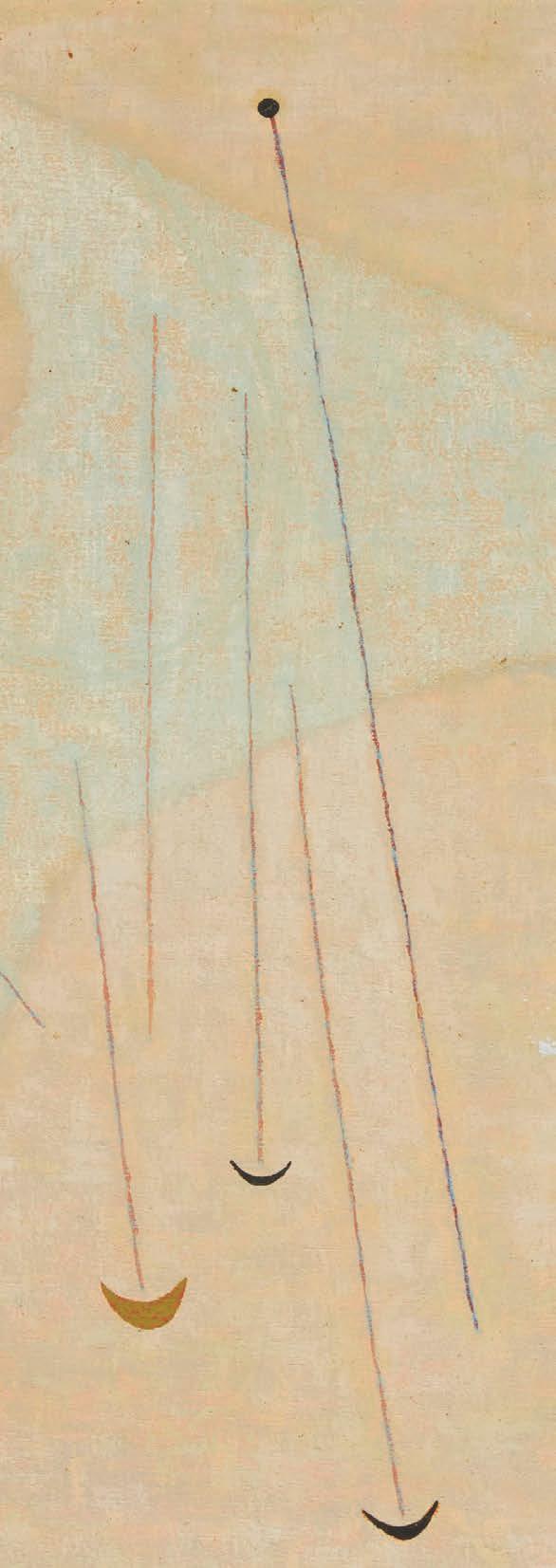
James Bishop was born in 1927 in Neosho, Missouri. 1945. In 1950, Bishop shifted his focus to art and years. His painting education continued at Black Columbia University, New York. Throughout his career, created his own visual language that explored compositional versus opacity, flat versus three-dimensional.
Bishop moved to Europe in 1957. He spent time most of his career. Galerie Lucien Durand in Paris Fellowship for fine arts in 1970. Bishop’s work was country travelling show “James Bishop, Paintings institutions before finishing at the Art Institute of New York exhibited a solo show of the artist’s work.
Bishop’s work has been compared to Abstract Expressionism, Surfaces,” but the artist described himself as “an use of color and light, Bishop creates architectural John Ashbery described Bishop’s work as “half architecture, Paintings and Works on Paper” (Düsseldorf: Richter
Missouri. He received a bachelor’s degree in journalism from Syracuse University in and enrolled at Washington University, St. Louis where he studied painting for three Mountain College, North Carolina, and he also studied art history for a year at career, Bishop worked interchangeably in painting and drawing mediums, as he compositional form alongside an interplay of material considerations: transparency in Italy and Greece before relocating to Blévy, France, where he would remain for Paris mounted his first solo show in November 1963, and he received a Guggenheim was also featured in major museum exhibitions including in a 1993 to 1994 threePaintings and Works on Paper,” and another travelling show that had two stops at German Chicago between 2007 and 2008. Most recently in 2014, David Zwierner Gallery in work.
Expressionism, minimalism and the late 1960s French movement “Supports/ “an Abstract Expressionist of the quieter branch.” Airing toward discreet and diffuse architectural compositions that play with form, scale and space. In an essay, art critic and poet architecture, half air” (Dieter Schwarz and Alfred Pacquement, eds., “James Bishop: Richter Verlag, 1993), p. 109).


86
James Bishop (1927-2021)
Abstract forms, 1950
Oil on canvas
Signed and dated lower left: Bishop / 50 26” H x 40” W
$30,000-50,000
Provenance: Estate, Los Angeles, CA



87
James Bishop (1927-2021)
Abstract composition, 1949 Oil on canvas
Signed and dated lower left: Bishop / 49 39” H x 39” W
$30,000-50,000
Provenance: Estate, Los Angeles, CA

88
James Bishop (1927-2021)
Abstract composition, 1953 Oil on canvas
Signed lower right: Bishop / 53 44” H x 35” W
$30,000-50,000
Provenance: Estate, Los Angeles, CA

Printmaker, painter and teacher Juliette Steele was fashion design at the Traphagen School of Design artist married her second husband Percy Cyril Edward
There Julia changed her first name to Juliette and Steele went on to receive a Masters of Fine Arts (CSFA) under Ray Bertrand, Clay Spohn and Stanley esteemed colleagues such as Ansel Adams, Richard including the Weyhe Gallery in NY, one of the first Steele’s work from the 1940s and 50s feature geometric painted compositions, such as the present work. critical acclaim for her work. Steele began exhibiting also featured in annual shows at the San Francisco Gallery in San Francisco, and a second solo exhibition
Steele was a member of and exhibited with the San president in 1949 and 1950), and the Laguna Beach Art, Washington, D.C., the Laguna Art Museum, Steele operated Steele’s Patio Shop in San Rafael,
was born Julia Eleanor Wilm in Union City, NJ. During the 1920s, Steele studied art and Design in New York. After an earlier marriage to John Dodig that produced a son, Gerald, the Edward Steele in 1939 and the couple settled in San Francisco.
and enrolled in San Francisco State College where she earned a Bachelor of Arts degree. from Stanford University, and she also studied at the California School of Fine Arts Stanley William Hayter. In 1949, Steele began teaching printmaking at CSFA, joining Richard Diebenkorn and Clyfford Still, while also exhibiting her prints at various galleries first galleries to specialize in art prints.
geometric abstraction, abstract expressionism and modernist figurative printed and In this mature period, Steele exhibited regularly and received numerous awards and exhibiting with the San Francisco Art Association in 1945 and continued until 1948, and was Francisco Museum of Modern Art. Her first solo exhibition was held in 1947 at the Artists Guild exhibition followed in 1949 at Seattle’s Kharouba Gallery.
San Francisco Art Association, the San Francisco Society of Women Artists (serving as Beach Art Association. Her work is represented in the collections of the National Gallery of Laguna Beach and the Worcester Art Museum, Massachusetts. Along with her husband, Rafael, California where they had lived from the mid-1950s. She died there in 1980.
89
Juliette Steele (1909-1980)
“Suspicion,” 1948 Oil on canvas
Signed and dated lower right: J. Steele ‘48; signed again and titled in pencil, likely in the artist’s hand, on a gum label affixed to the stretcher
34.25” H x 26.25” W
$1,000-1,500
Provenance:
Sold: Butterfield & Butterfield, Los Angeles and San Francisco, CA, October 29, 1998, Lot 6285



90
George Grosz (1893-1959)
“Zimmer Einer Prostituierten” (Room of a Prostitute), 1914 Watercolor, ink, and white heightening on laid paper, watermark Erclass Schreibmaschinen Papier
Signed in pencil along the lower sheet edge, at left: Grosz, titled in ink along the lower sheet edge, at right; titled again and dated in another hand on a remnant of old cardboard Image: 8.5” H x 10.75” W; Sheet: 8.75” H x 11.25” W
$2,000-3,000
Provenance: Glass Gallery, 315 Central Park West, New York, NY

Stanton Macdonald-Wright (1890-1973)
“Santa Monica,” 1926
Graphite on paper
Signed, titled, and dated lower center: S Macdonald-Wright / ‘26
Sight: 15” H x 18.5” W
$800-1,200


John Charles Haley (1905-1991)
Untitled (buildings with palm tree), circa 1960 Oil on canvas stapled to a backing board Appears unsigned; titled and dated on a gallery label affixed to the frame’s backing paper
Overall: 16.5” H x 22” W
$4,000-6,000
Provenance:
Estate of the artist Krevsky Fine Art, Oakland, CA, acquired from the above Private Collection, Oakland, CA, acquired from the above
Notes: Public institutions with works by Ottone Rosai in their permanent collections at this time include Florence’s Uffizi Gallery, Rome’s Modern Art Museum, London’s British Museum, and New York’s Museum of Modern Art.

Ukrainian-born American painter Sergei Bongart is known Los Angeles art scene. Trained in the rigorous Russian enduring the trauma of war-torn Ukraine, and spending
Arriving in the United States in 1948, Bongart quickly established his studio and home in the Hollywood Hills, they anchored a rare artistic enclave deeply rooted in Bongart’s paintings are known for their dynamic energy beyond his own canvases through the many students “one of the most important painters in the West, if not Society, summed it up best: “Whether in paint, crayon,
known best for his vivid color palette, expressive brushwork, and commanding presence in the Russian academic tradition, Bongart survived the horrors of WWII, fleeing Soviet-occupied Kiev, spending six years in postwar Munich awaiting a US visa.
quickly gained recognition, winning prestigious awards and commissions. In Los Angeles, he Hills, adjacent to that of fellow Russian émigré and esteemed painter Nicolai Fechin. Together, in Russian aesthetics and cultural heritage.
energy and luminous color, spanning still life, landscape, and portraiture. His influence extends far students he mentored. As Howard Burke of The Los Angeles Examiner noted in 1959, Bongart was not in the United States.” The late Mario Cooper, N.A., President of the American Watercolor crayon, poetry, or culinary endeavor, Sergei will always be brilliant.”
93
Sergei Bongart (1918-1985)
Abstract townscape Oil on Masonite
Signed upper right: Sergei Bongart; variously numbered in black or red marker, ballpoint ink, or stick-on label, verso of the work or of the frame: “N1” / “90.” / “SRB-105” / “14”
35.5” H x 48” W
$1,000-1,500
Provenance: The Estate of Sergei Bongart



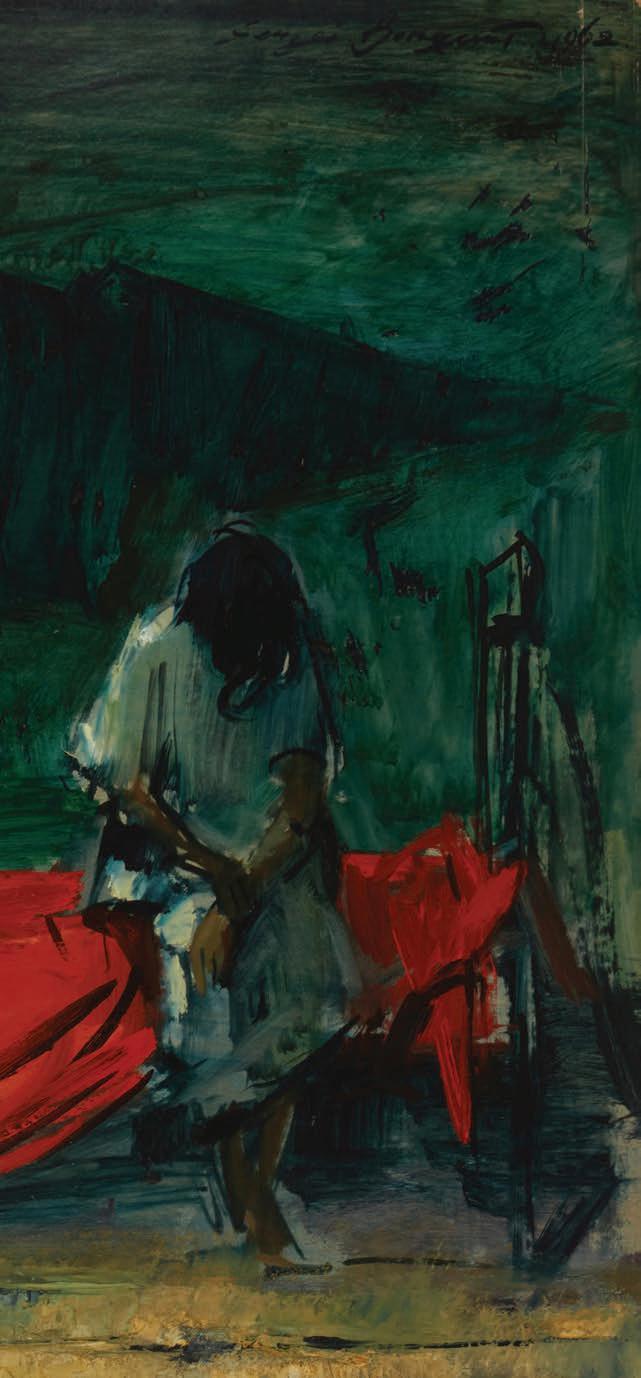
94
Sergei Bongart (1918-1985)
Awakening figure in a green room, 1962
Oil on board
Signed and dated upper right: Sergei Bongart 1962; signed and dated again, and inscribed verso: “L.A.”
30” H x 40” W
$1,000-1,500
Provenance: The Estate of Sergei Bongart
95
LeRoy Neiman (1921-2012)
Roberto Durán in training, 1981 Oil on board
Signed and dated lower left: LeRoy Neiman ‘81 24.25” H x 36” W
$25,000-35,000
Notes:
Roberto Carlos Durán Samaniego is a Panamanian former professional boxer who competed from 1968 to 2001. Durán held world championships in four weight classes: lightweight, welterweight, light middleweight and middleweight.



96
LeRoy Neiman (1921-2012)
“Jockey John L. Rotz,” 1972 Oil on board
Signed and dated lower left: LeRoy Neiman N.Y. ‘72; signed (twice) and dated again, and inscribed, all verso: “colours of left to right / King Ranch / Sonny Werblin / Darby Dan Farm” 24” H x 18.75” W
$8,000-12,000
Notes:
Known as “Gentleman John,” John L. Rotz was North America’s leading stakes-winning rider in 1969 and 1970, when he rode Hall of Famers “Gallant Bloom” and “Ta Wee.” In 1970, he won the Belmont Stakes on “High Echelon.” In the present triple portrait, Rotz wears the colors of King Ranch for whom he rode “Out of the Way” in 1968; Sonny Werblin (former owner of the New York Jets) for whom he rode “Silent Screen;” and Darby Dan Farm.

Vassil Stoev was born in Parvomay in the Plovdiv Academy in Sofia, graduating in 1979. He has been the “Philippopolis” group of artists.
Stoev had his first solo exhibition in Bulgaria in 1981 works began to be sold at Sotheby’s, London. Since internationally and is considered one of the top Bulgarian Stoev received the “Plovdiv” award in 1999, an annual institutions for their contributions to the cultural life International Biennale, and in 1998 he was awarded
A difficult childhood has not diminished the artist’s passion and intuition, not necessarily knowing where in his work. “I like to mix several colors, I like to find rhythm, something to happen. This is something creativity - Interview - BNR News). The present painting’s bold palette indicative of the artist’s best works.
region of Southern Bulgaria, and studied applied graphics at the National Art been a member of the Union of Bulgarian Artists since 1987 and is also a member of 1981 and his first international exhibition in Vienna in 1983. Beginning in 1989, Stoev’s Since the 1980s, Stoev has participated in over 100 solo and group exhibitions Bulgarian artists working today.
annual honor given to artists, creative collectives, or other cultural or educational life of the ancient city of Plovdiv. In 1997 Stoev received Second Prize at the Malta awarded the Malta Honorary Award.
artist’s optimistic attitude, and Stoev has said that he approaches a blank canvas with where the artistic process will take him compositionally, and finding a childlike creativity find the balance between the turbulent and the calm. I always try to have some characteristic of my style” (Vasil Stoev: Between the shadow and the light stands painting’s dreamlike composition features a spontaneity of dynamic brushwork and a
97
Vassil Stoev (b. 1950)
“Arena,” 1988 Oil on canvas
Signed in Bulgarian and dated lower right: V. Stoev ‘88; with the artist’s last name and title in Bulgarian on a partial label affixed to the strainer 35.375” H x 27.625” W
$1,000-1,500
Provenance:
Sold: Sotheby’s, London, circa 1989, Lot 399 Private Collection, US, acquired from the above Private Collection, CA, gifted from the above, circa 2005


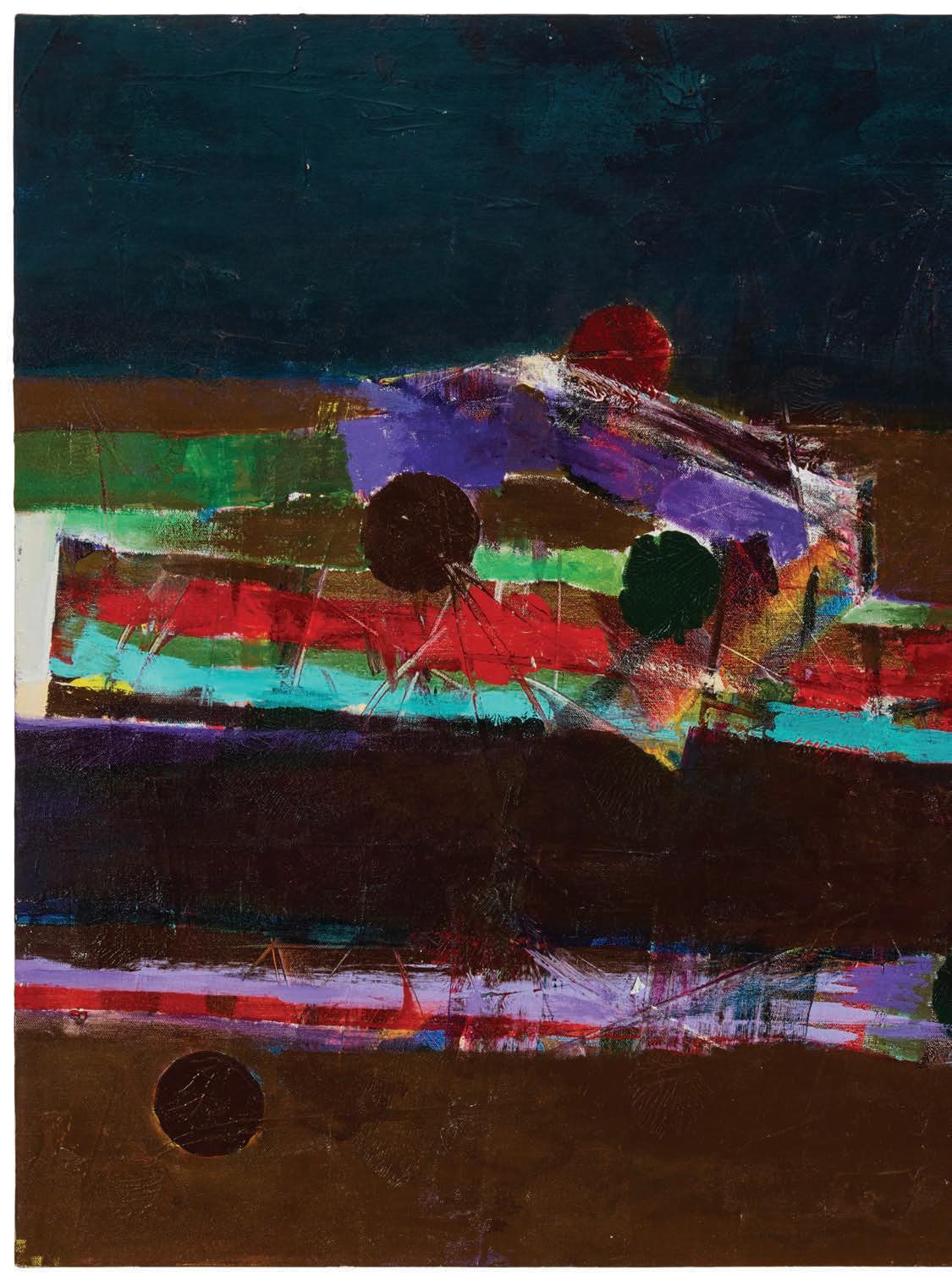

98
John Saccaro (1913-1981)
“Belle Sortie,” 1979 Oil on canvas
Unsigned; titled, dated, and inscribed on the upper stretcher bar: Oct. 31 / ‘79 30” H x 30” W
$2,000-3,000
Provenance: The Estate of John Saccaro
Exhibited: Sonoma, CA, Modern Art West, “Field of View: San Francisco Art from the 1960s and 1970s,” n.d.
Notes:
This lot is accompanied by a copy of a checklist from the exhibition mentioned above.



Alice Baber, born in Charleston, Illinois in 1928, began Stable Gallery’s Sixth Annual Exhibition of New York Annual’s extensive roster, was shown alongside Grace Elaine de Kooning. While many of the male artists Expressionist movement, Baber, who died at the at large.
Throughout her career, Baber experimented with often featured organic forms, flowing lines, and translucent particularly fascinated by the interplay of light and
Speaking of Baber’s work in the San Francisco Chronicle up of broad, lobular shapes that resemble rounded colors, some full and intense, others vaporous and pianist….The musical analogy extends to the movement but more often flowing and gliding in complex, swirling currents and cross-currents in a pool of water fed
Baber was diagnosed with cancer in the late 1970s work is held in numerous public collections, including and the Santa Barbara Museum of Art. Today, she United States and is celebrated for her unique and
began exhibiting her work in New York City in 1957 when she was included in the York artists. Baber, as one of the approximately twenty women included on the Grace Hartigan, Louise Nevelson, Lee Krasner, Mary Abbott, Joan Mitchell, and artists featured in this exhibition have been recognized as key figures of the Abstract age of fifty-four in 1982, has long been overlooked by museums and the art market
with different mediums, including oil paint, watercolor, and printmaking. Her paintings translucent layers of color, creating a sense of depth and movement. She was and color, and this became a central theme in her artistic exploration.
Chronicle in 1976, the art critic Thomas Albright noted, “Baber’s abstractions are made rounded beach stones. These become scaffolds for applications of richly harmonized oil and transparent, unified by a softness of surface that resembles the sensitive touch of a movement that these forms appear to undergo, sometimes crowded and compacted… swirling rhythms and counter-rhythms, advancing and receding in depth like the fed by a hidden spring.”
1970s and continued to paint until her death on February 2, 1982, in New York City. Her including the Metropolitan Museum of Art, the San Francisco Museum of Modern Art, she is recognized as an important figure in the development of abstract art in the and innovative style.
99
Alice Baber (1928-1982)
“The Jaguar Drum Leaps to Daylight,” 1978 Oil on canvas
Signed and dated upper left: © Baber 78; signed again, titled, dated, all twice, and numbered “#151,” all on the upper and lower canvas overlaps, verso 36” H x 72” W
$60,000-80,000
Provenance: Private Midwest Institutional Collection


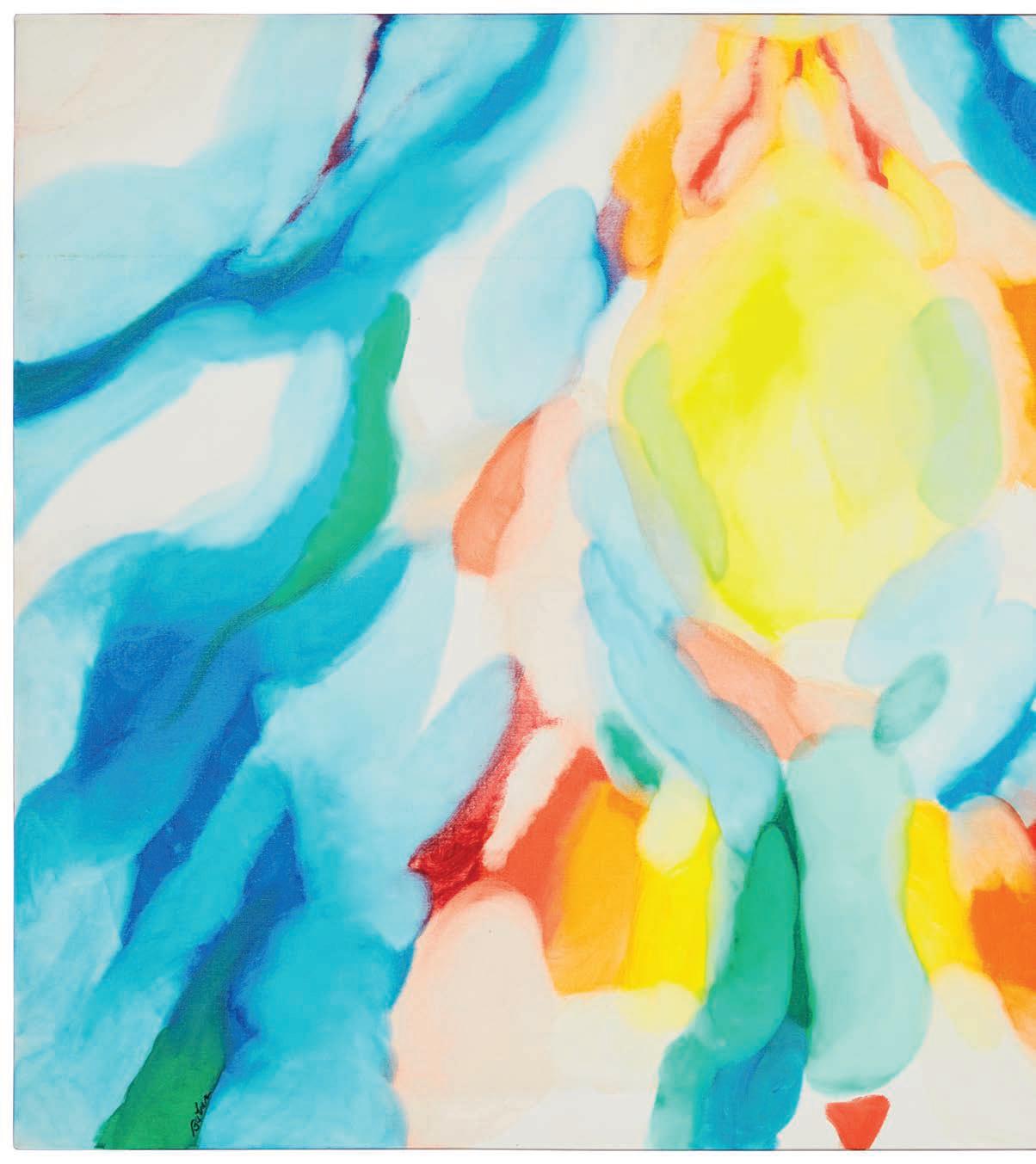

Alice Baber (1928-1982)
“Cave of the Hermit,” 1972 Oil on canvas
Signed lower left: Baber; signed again, titled, dated, and numbered, all on the canvas overlap: 1972 / “#227” 30” H x 40” W
$50,000-70,000
Provenance: A.M. Sachs Gallery, New York, NY Private Midwest Institutional Collection
Exhibited: Tulsa, OK, Philbrook Museum of Art, n.d.



101
Richmond Burton (b. 1960)
“United States of Kiss My Ass,” 1995 Oil on linen
Signed twice, titled, and dated “1995” in red ink, all verso 19.25” H x 26.25” W
$1,000-1,500
Provenance:
Matthew Marks Gallery, New York, NY Private Collection, Arcadia, CA


Charles Arthur (Chuck) Arnoldi (b. 1946)
“Hot Potato,” 1994
Acrylic on canvas
Signed, titled, and dated, all verso: Arnoldi / 1994 80” H x 66” W
$7,000-9,000
Provenance: Charles Arnoldi Studio Private Collection, Newport Beach, CA

103
Jay Milder (b. 1934)
“Ladder,” 1980
Rhoplex, leaves, perolite, and raw pigment on canvas
Signed and dated verso: Jay Milder / 1980; titled and dated on a label affixed verso Sight: 51.625” H x 67.5” W
$3,000-5,000

104
Kenneth Joaquin (b. 1948)
“Frenzy” Oil on canvas
Signed lower right: Joaquin; signed again and titled on the inner portion of the stretcher bar 30” H x 40” W
$700-900
105
Hansjörg Glattfelder (b. 1939)
“Constructed Painting,” 1970-72
Lacquered plastic pyramid relief in colors on board
Signed, dated, and inscribed with the work number in ink, all verso: glattfelder / 1972 / “PYR 291,” titled on a gallery lable, verso
35.5” H x 35.5” W x 4” D
$5,000-7,000
Provenance:
Marianne Deson Gallery, Chicago, IL
Deson-Zaks, Chicago, IL





106
Harold Waldrum (1934-2003)
“Casa Colorado,” 1980 Oil on canvas
Signed and dated, verso: Waldrum / ‘80; titled by repute 40” H x 34” W
$1,500-2,000
Provenance:
Corporate Collection, Minnesota
Sold: Revere Auctions, St. Paul, MN, “September: Fine & Decorative Art,” September 28, 2022, Lot 254
Private Collection, Irvine, CA, acquired from the above
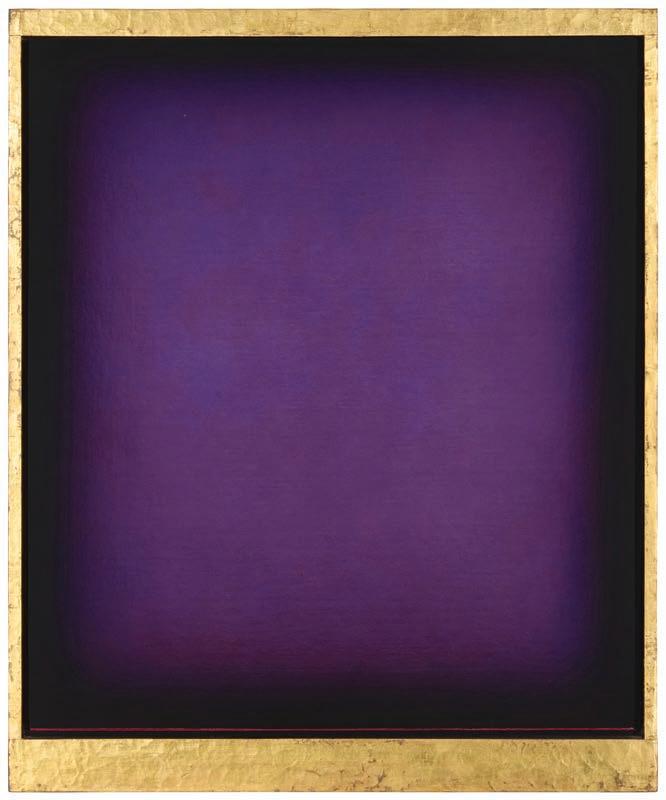
Eric Orr (1939-1998)
“Nightshift 16,” 1986
Mixed media and gold leaf on lead wrapped over wood
Unsigned; titled in pencil, verso; titled again and dated on a gallery label affixed verso 29” H x 24” W
$6,000-8,000
Provenance:
Acme Art, San Francisco, CA
Toby Devan Lewis, Shaker Heights, OH, from the above
Sold: Gray’s Auctioneers LLC, Cleveland, OH, “The Intuitive Eye - Property from The Toby Devan Lewis Collection,” November 27, 2024, Lot 9
Private Collection, Palm Springs, CA, acquired from the above
Exhibited:
San Francisco, CA, Acme Art, “Property from the Toby Devan Lewis Collection,” n.d.
Notes:
This lot is accompanied by a sale’s invoice dated November 27, 2024 from the auction mentioned above.



Richard Mayhew was an acclaimed African American landscapes that explore themes of identity, memory,
Born on Long Island in Amityville, New York in 1924, Cherokee) heritage. These cultural roots deeply influenced and land. Mayhew credits his grandmother with supporting house was Mayhew’s earliest source of inspiration.
George Inness, who was a lifelong influence. As a retreats along the Long Island shore. James Willson in Mayhew and encouraged him to paint. Parallel artist’s career and he performed at small jazz clubs focusing completely on painting.
Mayhew worked as a china decorator in New York formal art education began at the Art Students League school between 1948 and 1959 studying with Reuben prestigious John Hay Whitney Fellowship that enabled evolving modernist movements of the mid-20th
Mayhew rose to prominence in the 1960s as part Romare Bearden and Norman Lewis during the height role of African American artists in society, Mayhew’s overtly political subjects, he expressed cultural and often titled with poetic and spiritual overtones, serve journey.
Over the decades, Mayhew taught at prestigious accolades for his contributions to American art. His Museum and the Whitney Museum of American of emotion, memory, and spirit through his masterful expanded the possibilities of African American art
American painter and illustrator known for his vibrant, dreamlike “Neo-Barbizon” memory, and cultural heritage.
1924, Mayhew was of mixed African American and Native American (Shinnecock and influenced his artistic vision, imbuing his work with a spiritual connection to nature supporting his interest in drawing, and browsing through “Apollo Magazines” at her inspiration. His mother also took him to museums in New York where he first saw the work of a child, Mayhew first encountered professional artists during their summer painting Willson Peale, a landscape painter and medical illustrator, in particular, took an interest Parallel to art, Mayhew’s interest in jazz and performing arts was significant early in the clubs and the Borscht Belt of the Catskill Mountains in the 1940s and early 1950s before
York in the late 1940s where he met his first wife, artist Dorothy Zuccarini. Mayhew’s League in New York under Edwin Dickinson. He attended the Brooklyn Museum of Art Reuben Tam, and attended classes at Columbia University. In 1958, Mayhew won the enabled him to study in Europe, where he was exposed to classical techniques and the century.
part of the politically engaged Black artist collective “Spiral,” which was co-founded by height of the Civil Rights Movement. Although “Spiral” focused on addressing the Mayhew’s work stood out for its abstract, non-figurative approach. Rather than depicting and emotional depth through color, form, and atmosphere. His luminous landscapes, serve as metaphors for the African American experience and his own introspective
prestigious institutions such as Pennsylvania State University and has received numerous His work is held in major museum collections, including the Smithsonian American Art Art. Mayhew is celebrated for his unique ability to convey the intangible concepts masterful use of color and abstract landscape. His legacy is that of a trailblazer who art beyond traditional representation.


Richard Mayhew (1924-2024)
“This Morning,” 2007 Oil on canvas Faintly signed and dated lower left: Mayhew 07; titled and dated in ink, in another hand, on the frame’s backing paper 22” H x 28” W
$50,000-70,000
Provenance: Triton Museum of Art, Santa Clara, CA



Samella Lewis was a pioneering African American understanding and appreciation of African American
Born in New Orleans, Louisiana, Lewis grew up in She started her undergraduate degree at Dillard Catlett, Lewis transferred to Hampton Institute in Transferring to Ohio State University, Lewis earned doctorate in fine art and art history in 1951. Her academic the visibility of Black artists in American art history.
Lewis taught at a number of institutions during her Scripps College; Claremont Graduate University was executed in 1968. Lewis was in Florida from Advancement of Colored People (NAACP). Her prominence of being a Communist and was on the radar of the white community of Plattsburgh in 1958, she was curriculum that Plattsburgh offered, Lewis eventually multicultural population.
Lewis was not only a talented visual artist but also institutions and publications that amplified the voices “International Review of African American Art”), African American,” which became a foundational Black art within mainstream academic and museum
Throughout her career, Lewis combined artistry with Lewis co-founded the Museum of African American artists and scholars, reminding the world of the power a towering figure in the narrative of American art.
American artist, art historian, curator, and educator whose work greatly influenced the American art. She is considered the “Godmother of African American Art.”
in Ponchatoula in segregated Louisiana, where her passion for art emerged early. University in 1941 where she was instructed by Elizabeth Catlett. Encouraged by in Virginia where she earned her B.A. in 1945 and did work toward a master’s degree. earned her M.A. in 1948 and was the first African American woman to receive her academic achievements laid the groundwork for a lifetime dedicated to expanding history.
her career including at Florida A&M University; California State University, Long Beach; and State University College of New York at Plattsburgh, where the present painting 1953 to 1958, where she was an active member of the National Association for the prominence and outspoken activism made her a public target, and she was accused the Ku Klux Klan who shot out windows of her home. Moving to the predominantly was undaunted and founded a chapter of the NAACP. Despite enjoying the progressive eventually relocated to Southern California, so her children could experience a more
also a tireless advocate for cultural equity. In the 1960s and 1970s, she helped establish voices of Black artists, most notably “Black Art: An International Quarterly” (now called which she founded in 1976. She also authored several influential texts, including “Art: foundational resource in African American art history. Her work was instrumental in legitimizing museum circles.
with activism, using her work and scholarship to confront racism and social injustice. American Art in Los Angeles in 1976. Lewis’s legacy continues to inspire new generations of power of representation and the enduring impact of cultural preservation. She remains art.
Samella Lewis (1923-2022)
Dancing figures, 1968
Oil on canvas
Signed and dated lower left: S. Lewis / ‘68; signed again and inscribed “SUC-Plattsburgh, N.Y.” on the stretcher bar; indistinctly signed again, inscribed and titled “And They Were ***” on a label affixed to the stretcher bar
40” H x 51.75” W
$10,000-15,000
Provenance:
Ankrum Gallery, Los Angeles, CA
Private Collection, Glendale, CA

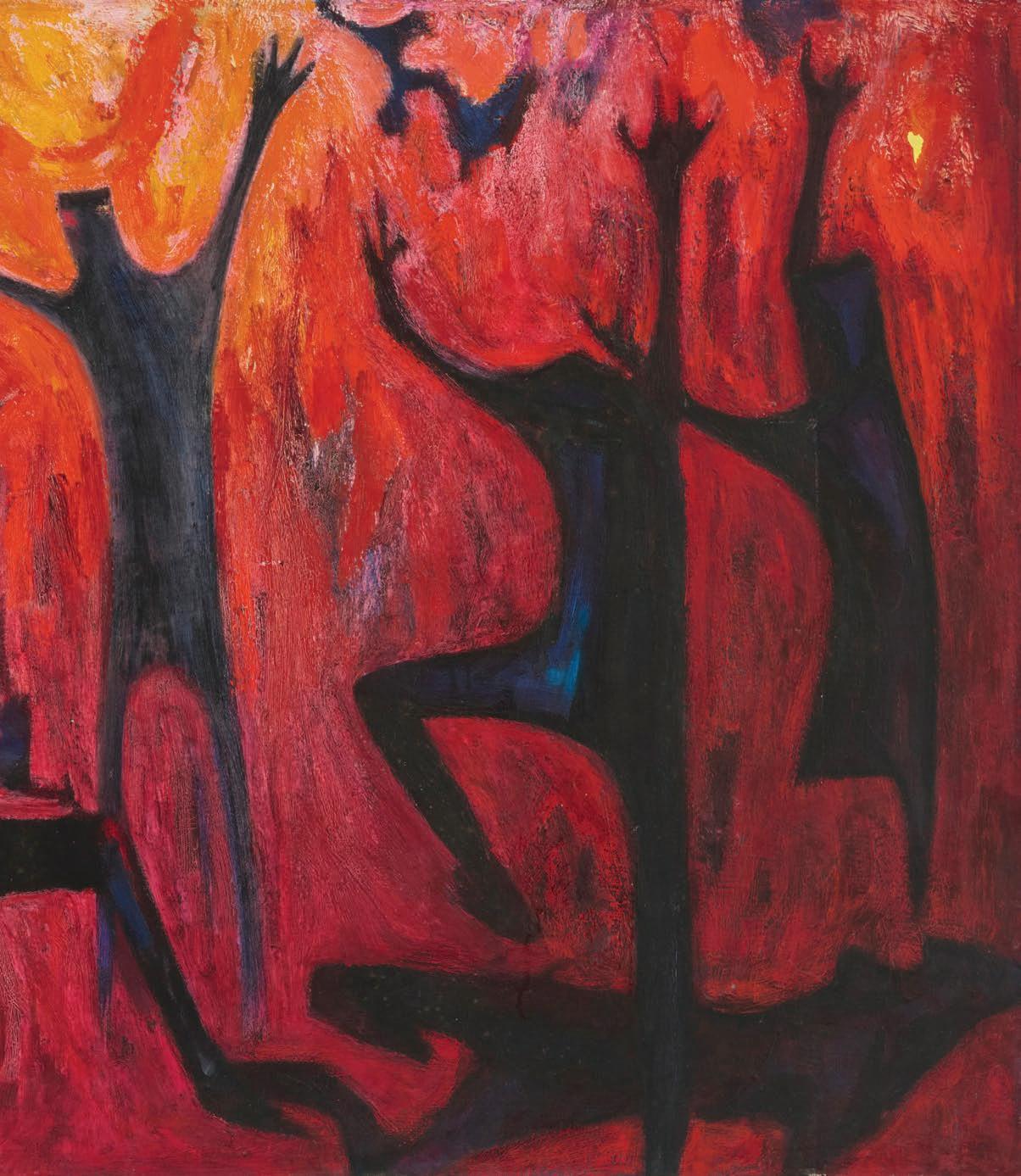



Abstract Expressionist, amateur jazz musician, and important large family of eight children. As a child, he was hospitalized recovery. Local artist and Director of the Studio Program work at the Museum, the only African American employee played jazz saxophone with the Jenkins Orphanage Band
Simpson had early success in a solo exhibition at the Home Painting, Sculpture, and prints by Negro Artists.” At age University under Hale Woodruff. He also worked at legendary Expressionism through interactions with artists including Simpson joined the Air Force in 1951 interrupting his formal famously that of General Dwight D. Eisenhower, and also inclusion of his painting “Nocturnal City” in a 1952 Metropolitan frame shop.
In the mid-1950s, Simpson’s paintings were included in two New York Painters” at the University of Michigan (1956). the Merton D. Simpson Gallery on Madison Avenue in 1954, the artist’s death in 2013. The success of the gallery allowed Africa beginning in 1959. During early trips to Europe, Simpson artists who had largely escaped prejudice in the US.
Simpson joined the “Spiral” in 1963, a Black art collective included many significant African American artists including Lewis, Richard Mayhew, and Simpson’s professor Hale Woodruff.
Simpson’s personal experiences of prejudice and an increased “Confrontation” series, executed between 1964 and 1969. foreshortened portrait compositions, like the present painting, intolerance, alongside ancient tribal imagery and early modernism
With the success of his gallery, Simpson was able to travel African Art, they also connected the artist more profoundly and “Contemporary Melodies” blended his African art heritage innovations to Simpson’s work in the 1990s incorporated his work. A 1995 Gibbes Museum of Art retrospective and American Modernist artist and legendary dealer of African
important dealer of African and tribal art, Merton Simpson grew up in Charleston, South Carolina in a hospitalized and bedridden for extended periods due to diphtheria and started drawing as an outlet in his at the Gibbes Museum of Art, William Halsey, was Simpson’s first art instructor, and hired him to employee of the institution in still segregated Charleston. Music was also important to the artist, and he Band (though not an orphan himself).
Home Book Shop, Charleston, and inclusion in Atlanta University’s “Eighth Annual Exhibition of 20, he moved to New York to study at The Cooper Union under Robert Gwathmey and at New York legendary New York framer Herbert Benevy’s frame shop, where he was directly exposed to Abstract Hans Hofmann and Max Weber.
formal art studies. He served until 1954 as an Air Force artist, where he painted portraits, most also played in a jazz combo on the base. Returning to New York, Simpson was encouraged by the Metropolitan Museum of Art exhibition, and felt reinvigorated to resume his studies and work at the
two museum shows: “Younger American Painters” at the Guggenheim Museum (1954) and “Eight A growing interest in African sculpture, fostered by his Professor Woodruff, led the artist to open 1954, a gallery that exhibited African art and objects alongside Modern art and remained open until allowed Simpson to support his siblings’ education and to make annual purchasing trips to Europe and Simpson was exposed to the robust expat African American community of writers, musicians and
collective interested in exploring how art could contribute to the Civil Rights movement. The group including Charles Alston, Emma Amos, Romare Bearden, Reginald Gammon, Alvi Hollingsworth, Norman Woodruff.
increased interest in social activism led to one of his most significant series of paintings, the 1969. The anger and frustration of the period are starkly evident in the dominant black and white painting, that at once reference the artist’s contemporary experience with social turmoil and modernism in their stark and unambiguously emotional compositions.
travel regularly to West Africa by the 1970s and 1980s. While these trips were ostensibly to search for profoundly to his heritage which in turn impacted his own work. Two 1980s series “Universal Orchestrations” heritage with AbEx-influenced spontaneous brushwork and the artist’s love of jazz. Further collaged elements of West African hunting cloth, adding three-dimensional sculptural elements to and continued gallery shows in the early 2000s have solidified Simpson’s legacy as both an important African and Tribal Art.
110
Merton Daniel Simpson (1928-2013)
“Confrontation,” circa late 1960s Oil on canvas
Signed lower right: M.D. Simpson; titled in pencil on the stetcher bar 24” H x 20” W
$8,000-12,000


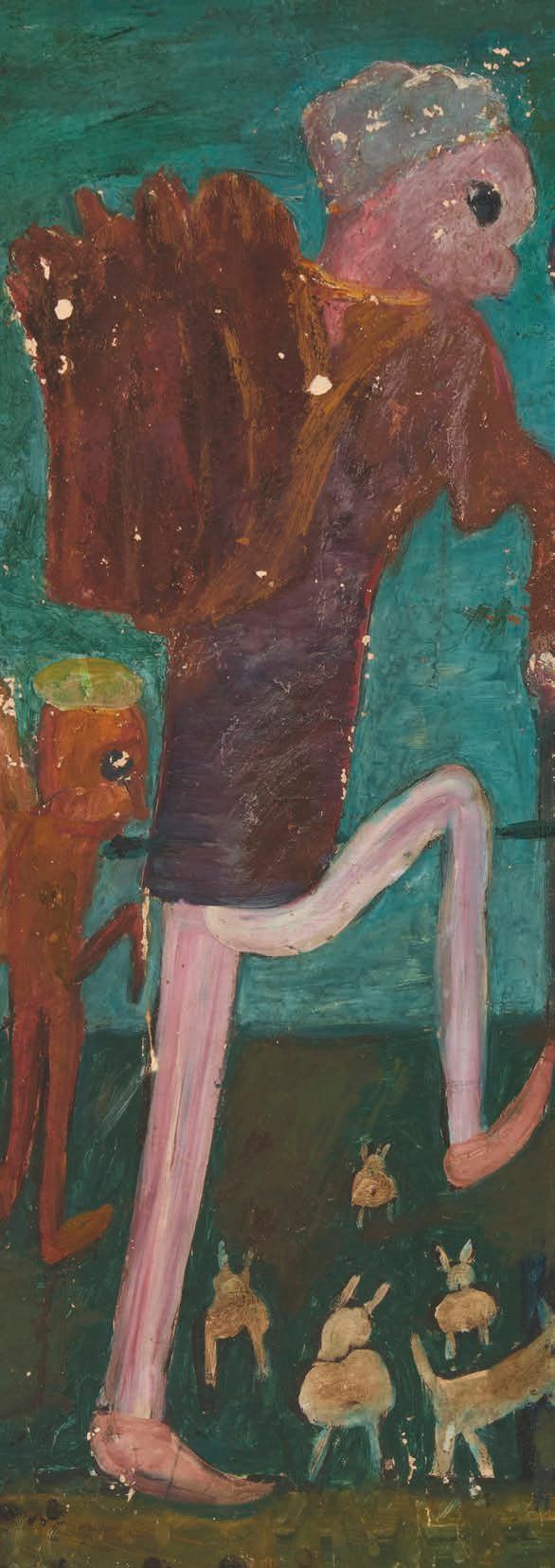
Outsider artist Jon Serl (Joseph Searles) was born Serl had a wild and varied early life: he worked as voice-over artist for silent actors during the transition during the Great Depression, he was Ned Palmer, twice on The Tonight Show starring Johnny Carson
After moving to the Palm Springs area in the 1940s, collection, are naive in execution, with strong figural in the American Folk Art Museum, National Museum
born in Oleans, New York in 1894. Before taking up painting following World War II, as a female impersonator and vaudeville performer known as “Slats,” he was a transition to “talkies” in the late 1920s working under the name Jerry Palmer, and Palmer, a migrant fruit picker. A local character and celebrity of sorts, Serl appeared Carson and counted Howard Hughes, Clark Gable and Hedda Hopper as friends.
1940s, Serl began to paint, completely self-taught. His paintings, like the present figural and narrative elements. Serl died in Lake Elsinore in 1993. His works are held Museum of American Art, and New Orleans Museum of Art.

111
Jon Serl (1894-1993)
Figures and animals, circa 1960s
Oil on pressboard
Signed lower right: Jon; inscribed “N17” in another hand on the verso 40.5” H x 21” W
$1,500-2,500
Provenance:
Estate of the artist
Notes:
There is an unfinished, unsigned painting on the verso of the pressboard.

112
Jon Serl (1894-1993)
“Brothers Picture,” circa 1960s
Oil on repurposed Masonite
Signed lower right: Jon; titled (twice) and inscribed “N14” in another hand on the verso
40.25” H x 21.5” W
$1,500-2,500
Provenance: Estate of the artist

113
Jon Serl (1894-1993)
“Marina,” 1961
Oil on plywood panel
Signed and dated lower left: Jon 61; titled and dated “61” (twice) on the verso, inscribed “N11” in another hand on the verso 40” H x 20.5” W
$1,500-2,500
Provenance:
Estate of the artist

114
Jon Serl (1894-1993)
“Young Albatross,” 1972 Oil on plywood
Signed lower right: Jon; titled and dated “72” (twice) on the verso, inscribed “N13” in another hand on the verso 40” H x 24” W
$1,000-1,500
Provenance: Estate of the artist

115
Jon Serl (1894-1993)
Face, circa 1970s
Oil and collage on reclaimed wood
Signed lower right: Jon; inscribed “N5” in another hand on the verso 23.5” H x 20.5” W (irreg.)
$700-1,000
Provenance: Estate of the artist
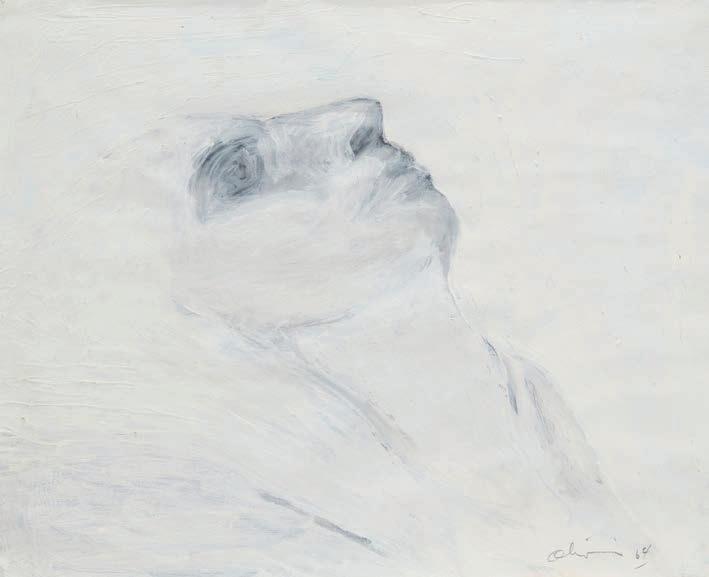
Nathan Oliveira (1928-2010)
“White Head,” 1964
Oil on paper
Signed and dated in pencil lower right: Oliveira 64; titled in pencil, verso
Image/Sheet: 12” H x 15” W
$2,000-3,000
Provenance: Hackett Mill, San Francisco, CA

117
(b. 1943)
Untitled Mixed media on panel
Unsigned
42.25” H x 96.5” W x 2” D (approx.)
$4,000-6,000


118
Laddie John Dill (b. 1943)
Untitled Mixed media on panel
Unsigned 24” H x 24” W x 2.625” D (approx.)
$1,000-1,500

119
Laddie John Dill (b. 1943)
Untitled
Mixed media on panel
Unsigned 24” H x 24” W x 2.625” D (approx.)
$1,000-1,500
Erle Loran (1905-1999)
Untitled abstract, 1952 Oil on canvas
Signed and dated lower right: Erle Loran ‘52 38” H x 26” W
$500-700
Provenance:
The Estate of Erle Loran Carlson Gallery, Carmel, CA Private Collection, Carmel, CA Winfield Gallery, Carmel, CA Gallery North Carmel, Carmel, CA
Exhibited: Sacramento, CA, Crocker Art Museum; Laguna, CA, Laguna Art Museum, “The Blair Collection: San Francisco Bay Area Abstract Expressionism,” traveling exhibition, May 8, 2004-February 27, 2005
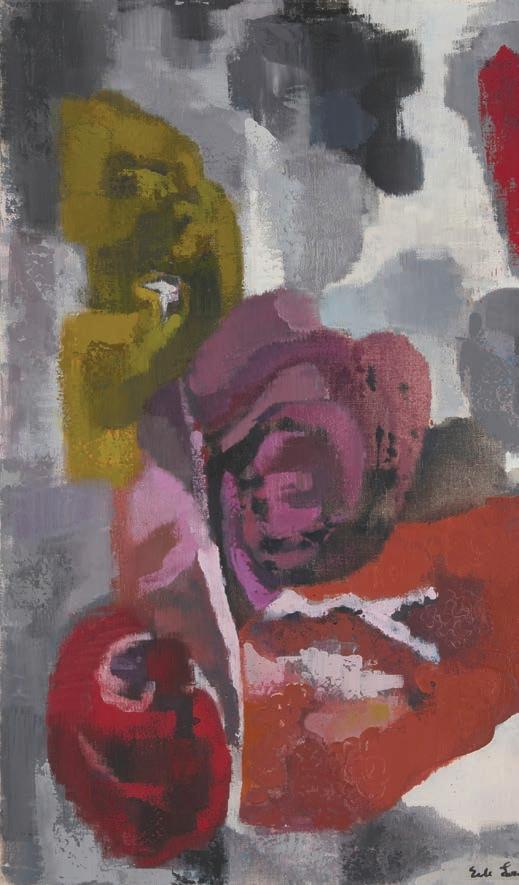
Billy Al Bengston (1934-2022)
“Plato de Moreno,” 1982
Watercolor and collage on Arches paper
Initialed, titled, and dated in pencil in the lower center: B.A.B; illegibly inscribed in pencil in the lower left corner 23” H x 29.5” W
$2,000-4,000
Provenance:
Billy Al Bengston Artist Studio, Venice, CA
Property from the Estate of Teri Garr, Los Angeles, CA

Paul Wonner (1920-2008)
“Study of a Tulip”
Acrylic and graphite on sketchbook paper
Signed in pencil lower right: Paul Wonner Sheet: 11.5” H x 11” W
$1,000-2,000
Provenance:
Sold: Bonhams, Los Angeles, CA, “Modern, Contemporary, and Latin American Art,” May 1, 2005, Lot 51
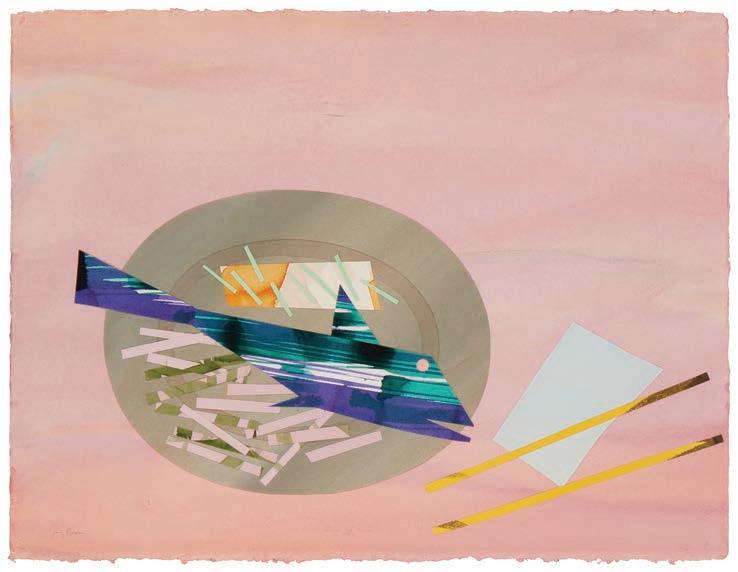
123
Raimonds Staprans b. 1926
“Gray Sky, Black House,” 1967” Oil on canvas laid to canvas
Signed and dated lower left: Staprans-67; titled in ink upper center stretcher, and again in red ink, both presumably in another hand, on a gallery label affixed to the upper stretcher 28” H x 34” W
$20,000-30,000
Provenance: Maxwell Galleries, San Francisco, CA Private collection, Carlsbad, CA
Notes:
Staprans’ work is celebrated for its bold use of color, geometric forms, and unique interplay between abstraction and representation. He often depicts everyday objects and landscapes with distinctive clarity and intensity, establishing himself as a significant figure in the Bay Area painting movement. Throughout his career, Staprans has exhibited widely, earning acclaim for both his visual art and his literary works, which include several successful plays. His enduring impact on the art world is marked by a relentless exploration of form and color, making his pieces a testament to his innovative spirit and artistic mastery.



The story of the career of Henrietta Berk is of triumph genius to become ignited. Born in 1919 in Wichita, 20th century. Until she didn’t. Abandoned by her and tragic. To heal her trauma and forge an independent graduated from high school in 1936 but did not an American housewife, her personal artmaking a
Berk could not resist painting. She began executing recognition in the press in 1957. She was urged by and Crafts (CCAC) from 1957 to 1961, often the summer of 1957, which would alter her artistic career art scene, Berk’s work would become linked to the
Her participation in a group show, “Painted Flower,” gained some attention, but it was her solo exhibition participated in numerous solo and group exhibitions the line between realism in landscape and figurative Coast art world.
Berk’s creative output diminished with her health. she was nearly blind by the middle of the 1970s. could make out shapes and colors until her death
Berk’s artistic achievements inspire, and her work Deborah Solon proclaims, “Berk defied the odds. a complicated personal history-any one of these evaporated. Berk was circumspect and self-effacing. success, her true focus was the personal freedom, Berk’s life works are experiencing a rediscovery and California, in 2021.
Select museums with works by Berk in their collections Art, New York; Whitney Museum of American Art, Museum of Modern Art, San Francisco.
triumph and creative explosion, one that proves that it is never too late for artistic Wichita, Kansas, Berk lived the life of a traditional American woman in the middle of the her father and left at an orphanage by her mother, Berk’s early childhood is clouded independent identity, Berk turned to artmaking during her time at the orphanage. Berk complete a college degree. She married Dr. Morris Berk in 1939, living the life of a mild annoyance to her husband.
executing small interior projects for neighbors in Oakland, California, receiving some by a friend to take art classes and enrolled on and off at California College of Arts oldest student in the classroom. She studied under Robert Diebenkorn in the career forever. From her studies at CCAC and visiting the surrounding contemporary the Bay Area Figurative Movement.
Flower,” at the Oakland Art Museum (now the Oakland Museum of California Art) exhibition at Lucien Labaudt Art Gallery that propelled her career as an artist. Berk exhibitions throughout the next decade, often the only woman on the roster. Berk blurred figurative painting and the movement of Abstract Expressionism gripping the West
health. Diagnosed with diabetes in the late 1960s, it steadily worsened her eyesight until Unfettered by her lack of vision, Berk continued to paint on large canvases so she death in 1990.
work is coming into its own in American art history. As professor and art historian odds. She had every reason not to succeed. Age, gender, lack of full-time training, and obstacles could have derailed her career. But when she painted, all those hurdles self-effacing. Although gratified by the critical recognition and grateful for the financial freedom, joy, and creative delight she experienced through making her art.” Henrietta and were the center of a retrospective exhibition at The Hilbert Museum in Orange,
collections include: Metropolitan Museum of Art, New York; Museum of Modern Art, New York; Solomon R. Guggenheim Museum, New York; and San Francisco


Henrietta Berk (1919-1990)
“Sunset,” circa 1964-68 Oil on canvas
Signed lower right: H Berk; titled and dated by repute 54” H x 72” W
$15,000-25,000
Provenance: Steven Stern Fine Arts, Beverly Hills, CA
Exhibited: Orange, CA, Hilbert Museum, “Henrietta Berk: In Living Color,” August 28-2021-January 15, 2022

125
Henrietta Berk (1919-1990)
“Yenta #2” Oil on canvas
Signed lower right: H Berk; titled on a label affixed to the frame’s backing board 20” H x 20” W
$5,000-7,000
Provenance: Steven Stern Fine Arts, Beverly Hills, CA
Notes:
“Yenta #2” is a portrait of the artist’s cat.

126
Lundy Siegriest (1925-1985)
“Along the Truckee” Oil on canvas laid to canvas
Signed lower right: Lundy Siegriest; signed again and titled on the original canvas prior to lining 34” H x 44” W
$2,000-3,000
Provenance: Ruth Vignao, San Francisco, CA
Sold: John Moran Auctioneers, Altadena, CA, “20th Century & Contemporary Design, November 14, 2017, Lot 2287
Private Collection, Carlsbad, CA, acquired from the above



John Havens Thornton was born in Mexico City to American educator and fostered his early interest in art.
While pursuing a degree in mechanical engineering at Princeton studied painting alongside classmate Frank Stella under Thornton’s early development as a painter.
After graduating in 1955, Thornton relocated to New York Artistic training resumed two years later when he enrolled proponent of the Precisionist art movement in the 1920s Phillip, an artist sometimes labelled as “America’s last Impressionist.”
In the late 1950s, Thornton had a studio space on Madison Willem de Kooning, beginning with a first show at Nordness and would remain there for two decades. During this time to develop a signature style of abstract painting that was
In the early 1970s, Thornton was innovating again, gradually 1973, he produced the first grid paintings, a painting construct precision” to the organization of his canvases by layering
During the decades of the 1960s and 1970s, Thornton had Ward-Nasse Gallery; the DeCordova Museum; a two-person Art at the Museum of Fine Art, Boston; the Hildreth Gallery University. In 1967, a painting by Thornton was included (which would become the Whitney Biennial beginning in
In 1984, Thornton settled in New Bedford, MA with his wife perspective and three-dimensional space for the first time. balls, doors, stairways and architectural building blocks in
Thornton continued to enjoy critical success with solo exhibitions Bedford Art Museum held a retrospective exhibition of the New York. Thornton’s work is in the collections of Massachusetts
American parents and grew up in Upper Montclair, NJ. Thornton’s mother, Dorothy, was an artist and arts
Princeton University, Thornton began creating cartoon illustrations for student publications. He also William C. Seitz, who was a staunch champion of Abstract Expressionism and a great influence on
York and began working as an industrial designer for Henry Dreyfuss Associates and General Electric. enrolled in the Arts Student League in 1957 taking classes with abstract painter Ralston Crawford, a leading and 30s. The following year, Thornton took classes at the National Academy of Design under Robert Impressionist.”
Madison Avenue and exhibited works with fluid abstraction influenced by artists including Arshile Gorky and Nordness Gallery in 1961. In 1962, Thornton moved to Boston to teach at the Massachusetts College of Art time in Boston, Thornton also worked as a set designer for the Theater [3] Company, while also continuing moving toward minimalism.
gradually introducing representational pictorial elements into his formally completely abstract paintings. In construct the artist incorporated into his work for his remaining career which adding “mathematical layering a uniformity of a grid layout on top of his already hard-line imagery.
had a number of solo and group exhibitions in prominent Boston galleries and institutions including: the two-person show with the artist Richard Hamilton at the Institute of Contemporary Art, Boston; The School of Gallery at Nasson College; the Bromfield Gallery in Boston; and the Rose Art Museum at Brandeis in the Whitney Museum of American Art’s “Annual Exhibition of Contemporary American Painting” 1973).
wife Pat Coomey Thornton, a fellow painter and textile artist. In the 1980s, Thornton turned to linear time. Through a series of untraditional still life pictures, like the present work, he arranged colorful boxes, in lifeless landscapes that seem to recall a sense of the uncanny like a Giorgio de Chirico painting.
exhibitions at the Clark Gallery, Lincoln, MA, and Dartmouth Gallery, Dartmouth, MA. In 2004, the New the artist’s work and in 2015 a major survey show was mounted at the Bienvenu Steinberg & J Gallery in Massachusetts museums Addison Gallery of American Art and the Rose Art Museum.
John Havens Thornton (1933-2021)
“Light and Shadow,” 1987 Oil on canvas
Signed and dated on the canvas overlap: Thornton ‘87; dated again and titled on a sheet affixed to the frame’s verso
20” H x 24” W
$3,000-5,000
Provenance:
K. Nathan Gallery, La Jolla, CA
Notes:
We are grateful to Keith Kelman of K. Nathan Gallery for his assistance in cataloging this lot.

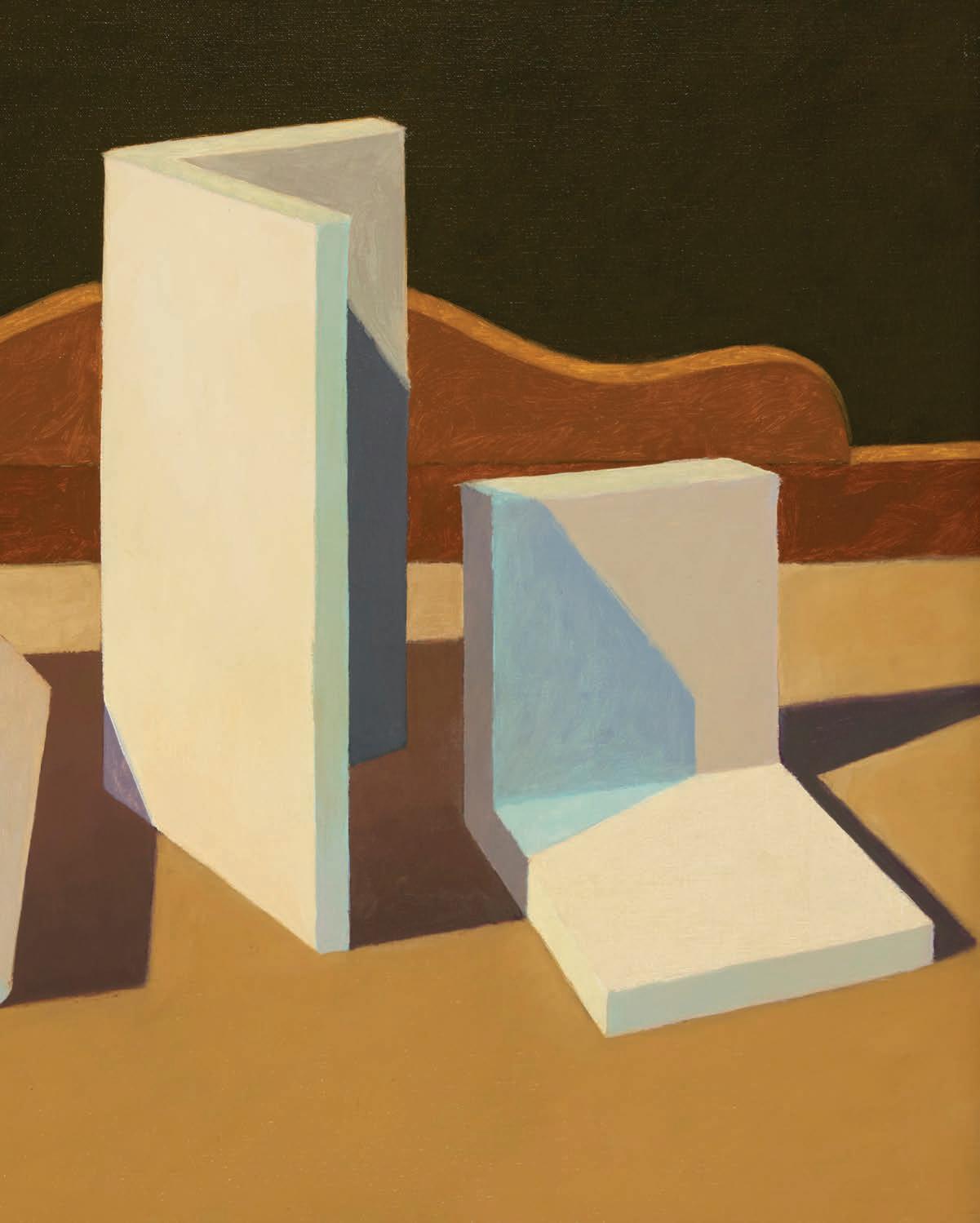

128
Michael Bedard
(b. 1949)
“5 Shapes”
Acrylic on canvas
Signed lower right: Bedard; titled and inscribed “#6” in pencil, possibly in the artist’s hand, on the frame’s backing paper 18” H x 36” W
$1,000-1,500
Provenance: Patricia Correia Gallery, Santa Monica, CA


Michael Bedard (b. 1949)
“Unusual Suspects”
Acrylic on board laid to cardboard
Signed lower right: Bedard; titled and inscribed “#2” in pencil, possibly in the artist’s hand, on the frame’s backing paper 11” H x 14” W
$500-700
Ira Yeager (1938-2022)
Rabbit wearing overalls Oil and acrylic on canvas
Signed lower left: Ira Yeager
78” H x 48.5” W
$3,000-5,000
Provenance:
The Estate of Cal and Joann Setzer, Sacramento, CA, acquired circa 1987 The Estate of Cinders Hope Setzer, Palm Springs, CA, acquired from the above by descent Private Collection, CA, acquired from the above by descent
Notes:
A string tag attached to this work’s hanging wire is inscribed, presumably in another hand, / La Ville du Soleil / Sm: Mrs. Cal Setzer.” This refers to an antiques store of this name located Sansome St. in San Francisco. Started in the late 1960s by Lillian Williams and her husband was eventually taken over by Lillian’s hand-picked successor, Suze Perry-Hinkle. Lillian was fond of displaying and selling fine and decorative items depicting anthropomorphism animals human clothing along with the other items in her antiques store.
130
Michael Bedard (b. 1949)
“Stage Fight,” 2000 Oil on canvas
Signed and dated along the underside of the lower edge: Bedard / 3-3-2000; titled and inscribed “#9” in pencil, possibly in the artist’s hand, on the stretcher 5” H x 5” W
$200-300

descent hand, “12-4-87 located on husband Teddy, it was apparently animals in

132
Maggie Hasbrouck (b. 20th century)
“Angelboy,” 2004
Oil on panel
Signed, titled, and dated verso:
Maggie Hasbrouck / 2-04
48” H x 36” W
$800-1,200


133
Helen Allois (b. 1969)
“Dreamcatchers,” 2017 Oil on oxidized steel
Signed, titled, and dated lower left: Allois / 17; signed, titled, and dated again, all verso 10” H x 8” W
$500-700

134
Helen Allois (b. 1969)
Ships near a port, 2019 Oil on panel
Signed with the artist’s device and dated lower right: Allois 2019
Sight: 20” Dia.
$800-1,200

R. Kenton Nelson is a contemporary American painter work blends nostalgia with narrative realism, drawing artists.
The Mexican artist and muralist Roberto Montenegro, One of the first artists to be involved in the Mexican contemporary of Diego Rivera and Frida Kahlo. Nelson Art and Design. Before transitioning to fine art in experiences that continue to inform his precise line
Nelson’s paintings are characterized by their idealized own unique balance of light and shadow. His style also reflecting the influence of advertising and cinema present the world as he envisions it.
Throughout his career, Nelson has exhibited extensively including Peter Mendenhall Gallery, the Pasadena Ruzicska in Austria.
Still actively painting in Southern California, Nelson refined beauty and timeless elegance.
painter renowned for his stylized depictions of mid-century life in Southern California. His drawing from American Scene painting, Regionalism, and inspiration from WPA-era mural Montenegro, Nelson’s great-uncle, in particular, had a profound impact on the artist’s early work. Mexican muralist movement following the Mexican Revolution, Montenegro was a Nelson studied at California State University, Long Beach, and the Otis College of in the 1990s, Nelson spent nearly two decades as a graphic designer and illustrator, line work and bold compositions.
idealized portrayals of everyday Americana figures, architecture, and objects, each with their style evokes the aesthetics of 1930s American Regionalists and Mexican muralists, while cinema from the 1950s. He describes his approach as “idolizing the ordinary” aiming to
extensively both in the United States and internationally, with shows at renowned venues Pasadena Museum of California Art, Gerald Peters Gallery in New York, and Galerie Nikolaus
Nelson remains dedicated to his craft, producing paintings that invite viewers into a world of

135
Robert Kenton Nelson (b. 1954)
“Lucidity,” 2005 Oil on canvas
Signed lower left: R. Kenton Nelson; titled and dated “2005” on a label affixed to the frame’s backing paper
36” H x 24” W
$15,000-20,000
Provenance: Collection of John Sacret Young Montgomery Gallery, San Francisco, CA



136
Robert Kenton Nelson (b. 1954)
“Shadowed House” Oil on Masonite
Signed lower right: R.Kenton Nelson; titled by repute 24” H x 36” W
$10,000-15,000
Provenance: Montgomery Gallery, San Francisco, CA

John Tarahteeff (b. 1972)
Untitled (Figures in suspended action), 2009 Oil on canvas
Signed and dated verso: John Tarahteeff / 2009 28” H x 36.75” W
$1,500-2,500
Provenance: Triton Museum of Art, Santa Clara, CA
Notes:
John Tarahteeff creates probing classically rendered figurative paintings that challenge viewer’s perceptions through unusual lighting and scale, suspended mid-action, and heightened emotional tension between innocence and knowledge. Imaginative and dramatic narrative compositions like the present work spark questions in their story telling, but leave the viewer questioning and searching for a clear message or intention.

138
Robert Ginder
(b. 1948)
“Via Sienna,” 1993
Oil and gold leaf on panel
Signed, titled, and dated, all verso: Robert Ginder ‘93; alternatively titled “4339 Via Siena” [sic] on a gallery label affixed verso 56” H x 36” W
$2,000-3,000
Provenance: OK Harris, New York, NY

Jeffrey Beauchamp (b. 1964)
“Rose Portal,” 1991 Oil on canvas
Signed and dated in ink on the canvas overlap: Jeffery Beauchamp 1991; titled by repute 22” H x 40” W
$2,000-3,000

140
Robert Kenton Nelson
(b. 1954)
“Passing” Oil on board
Signed lower left: R. Kenton Nelson; titled by repute 24” H x 24” W
$5,000-7,000
Provenance: Montgomery Gallery, San Francisco, CA


141
Robert Kenton Nelson (b. 1954)
“Across from Mr. Barnes” Oil on Masonite
Signed lower left: R.K. Nelson; titled on a label affixed to the frame’s backing paper
12” H x 12” W
$3,000-4,000
Provenance: Montgomery Gallery, San Francisco, CA
142
Robert Kenton Nelson (b. 1954)
“Time Out” Oil on Masonite
Signed lower right: R.K. Nelson; titled on a label affixed to the frame’s backing paper
12” H x 12” W
$3,000-4,000

143
Andrea Vizzini
(b. 1949)
Classical collage, diptych
Oil, collage, and mixed media on canvas
Signed and indistinctly inscribed lower right: Andrea Vizzini
2 pieces
Overall: 113.5” H x 20” W (irreg.)
$800-1,200
Provenance: Private Collection, Tucson, AZ
144
Andrea Vizzini (b. 1949)
“Installazione No. 83,” 1992
Mixed media on panel
Signed and indistinctly inscribed lower right: Andrea Vizzini, inscribed indistinctly lower left; signed again (twice), titled, dated in Italian, and inscribed, all verso: “Venice 30 Ottobre
1992 / For James / And / Jocelyn”
24” H x 32” W
$500-700
Provenance:
The artist Galleria d’arte Moderna Ravagnan, Venice, Italy
Private collection, Tucson, AZ, acquired from the above, 1992
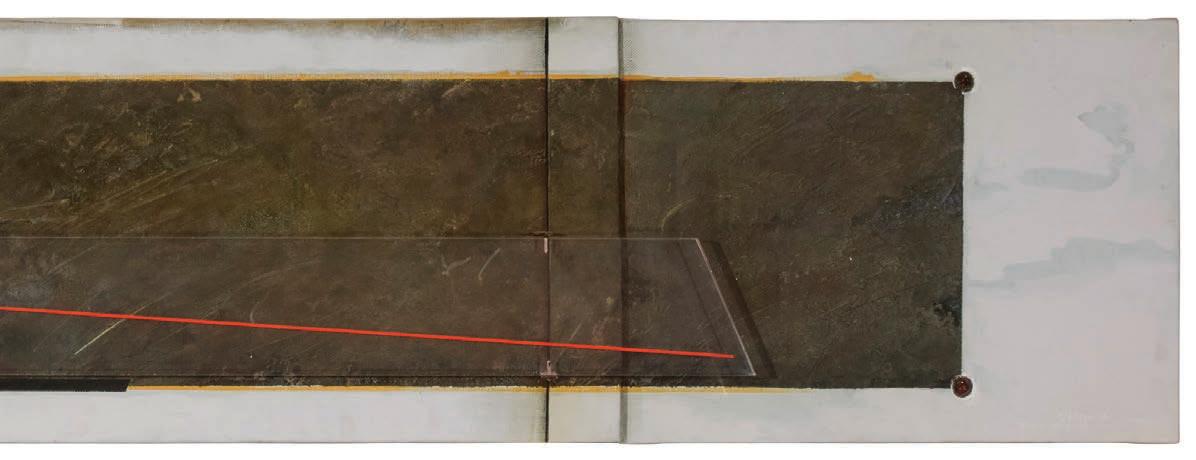
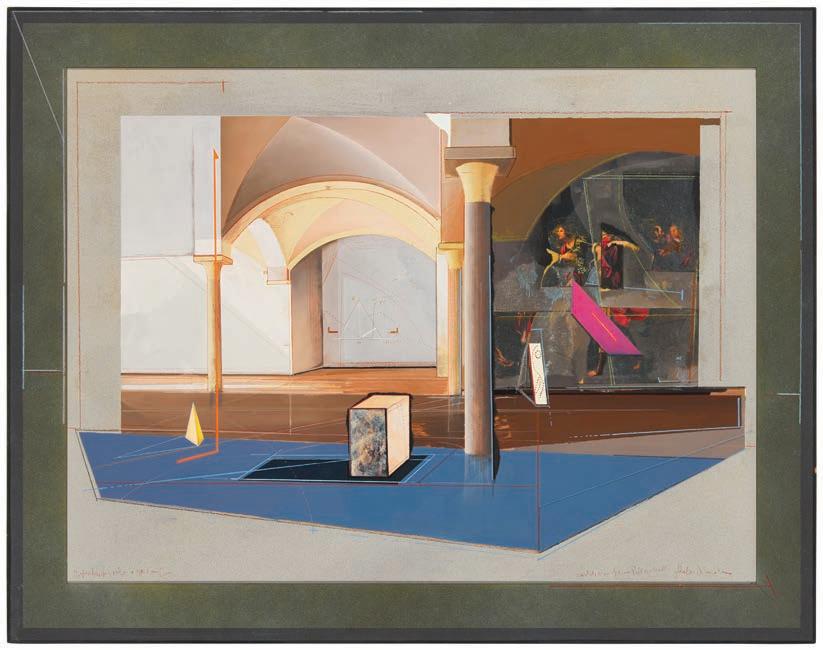

Babak Emanuel has always believed that art moves are visually immediate and rationally inexplicable.
In response to the conceptual demands of today’s morphologies that emotionally have defined the
Babak begins his work with “concrete visions” and him through recondite and mysterious pathways. in a cohesive expression. Emanuel makes forms for adherence to a standard. He aims for them to be
Babak also wants the viewer to take these strands desires and experiences. Just as the artist’s own aesthetic historical and cultural narratives. Yet through all of
Fascinated by the interplay of accidents and reason, entropy stands face to face with coherent arrangements
Emanuel is deeply engaged with techniques and print-making, painting, sculpture and digital technology
moves beyond the narrow confines of language and explores indescribable dimensions that inexplicable.
today’s art, Emanuel has, while cognizant of art history, remained faithful to those visions and purpose and limitations of “Being” for him as an artist.
and yet does not work with an end in sight. The emotional language of his vision guides pathways. He works on several paintings at once and allows for multiple impulses to synchronize for form’s sake and chooses not to have his works understood or to be scrutinized by be seen for their own power, awaken senses, and envision new vistas.
strands and create their own personal narratives. Art is often interwoven with the viewer’s aesthetic preferences are determined by their feelings formed in the crucible of social, of this, Emanuel is guided by the unconscious forces that often lie beyond reasoning.
reason, Babak Emanuel’s art pits rules and order against chaos and the unexpected. Always, arrangements and their confrontations, though tragic, are meaningful.
and media. They are vehicles of his emotional yearnings and explorations. Photography, technology all facilitate his desires and the quest for meaning and the purpose of “Being.”
145
Babak Emanuel b. 1966
“The Hero with a Thousand Faces”
Engraved sheet metal sections mounted to wood
Signed and titled in pencil, verso: B Emanuel
30” H x 68” W x 4” D
24” H x 32” W
$2,000-3,000
Notes:
The work is currently on a detachable wood base.

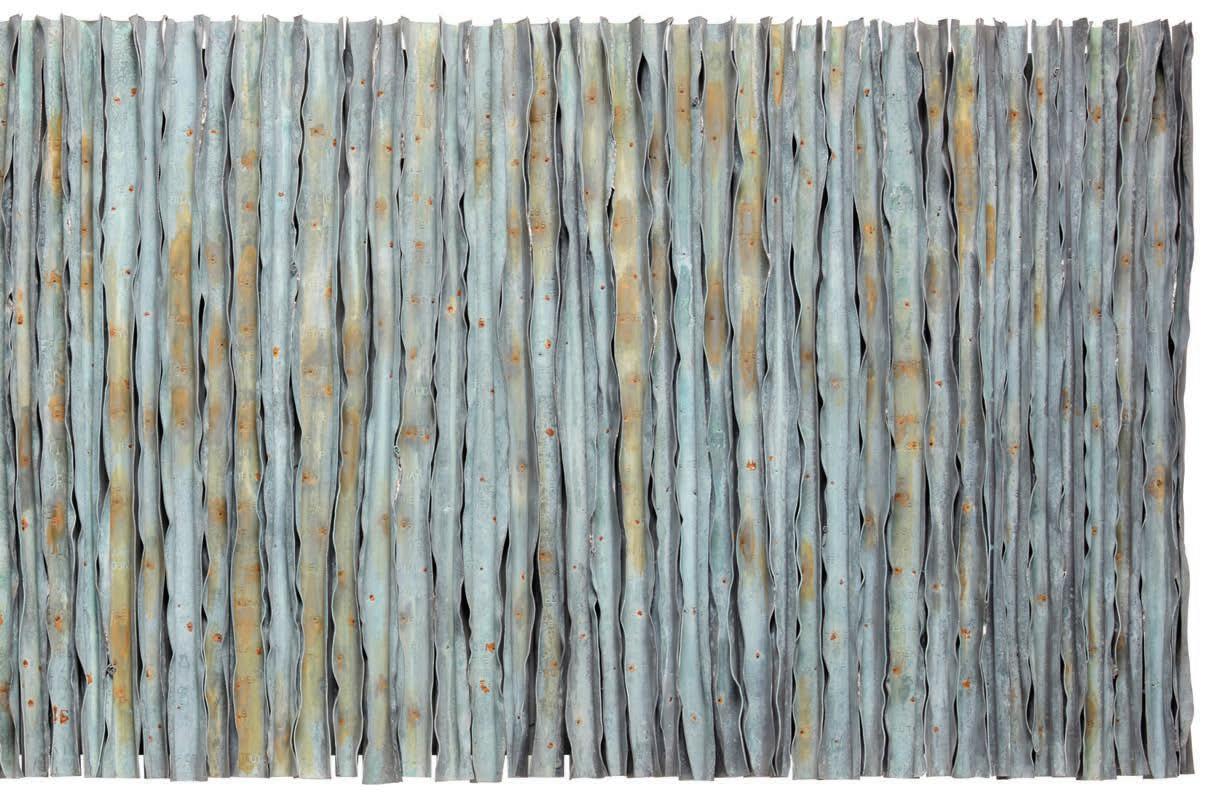
146
Babak Emanuel (b. 1966)
“To Bring Together”
Mixed metal mounted to wood Signed and titled in pencil, verso: B Emanuel 66” H x 41” W x 2.5” D (irreg.)
$2,000-3,000
Notes:
The work is currently on a detachable wood base.



147
Fletcher Benton (1931-2019)
“Lyrical Construct #2,” 1995 Steel
With the incised artist name, signature and date lower left: Fletcher Benton “Fletcher Benton” 1995; titled by repute 16” H x 15” W x 2.25” D (approx.)
$1,500-2,500
Provenance: Collection of the artist Krevsky Fine Art, Oakland, CA, acquired from the above Private Collection, Oakland, CA, acquired from the above
Robert Carston Arneson (1930-1992)
“Brick,” 1969
Terra cotta
Impressed to top surface: ARNESON
4.75” H x 9.5” W x 3.125” D
$1,500-2,500
Provenance:
Allan Stone Collection, New York, NY Cowan’s Auctions, Cincinnati, OH, “Modern Ceramics & Modern Art + Design” October 28, 2016 Rago Arts and Auctions, Lambertville, NJ, “Modern Ceramics and Glass,” September 24, 2017, Lot 1510
Sold: Wright Auctioneers, Chicago, IL, “Art + Design,” January 16, 2020, Lot 271
Private Collection
Exhibited: Claremont, CA, Lang Art Galleries, Scripps College, “23rd Ceramic Invitational,” March 21-April 12, 1967 San Francisco, CA, The Hansen Galleries, “Ceramic Sculpture,” May 30-June 17, 1967

Internationally celebrated British artist Gavin Turk authenticity and identity. His provocative subjects ready-mades. In repurposing common household art historical medium of bronze, Turk takes on the being.
Turk said about his own work in a 2022 interview notions of reality and perception, which in turn are interested in the idea that there is a whole load of way you understand that ‘thing’ and give it meaning” buck).

Turk is a pioneering contemporary sculptor whose work addresses issues of authorship, subjects continue a century-long avant-garde debate that harkens back to Macel Duchamp’s household objects like the present work’s paint roller subject or rubbish bags rendered in a classic the ‘myth’ of the artist and ontological ideas that question the concept and nature of
with Louisa Buck, “I have always engaged with Surrealism and with art that questions are informed by dreams, the psyche, and psychological states. I have been especially of mental baggage you bring to an object that you’re engaging with, which informs the meaning” (www.gavinturk.com/about/essays/2022/interview-gavin-turk-conversation-louisa-
149
Gavin Turk
(b. 1967)
“9” Roller in Bronze,” 1995
Paint roller, bronze powder, glue, and paint in a wood and glass display cabinet
From the edition of 3
Roller: 2.375” H x 10.375” W x 14.375” D; Plinth: 33.25” H x 26.5” W x 17.75” D; Glass: 17.75” H
$15,000-25,000
Provenance: Jay Jopling, White Cube, London
Private Collection, Arcadia, CA, acquired from the above



Rebecca Horn was a German artist whose body of drawing. Horn’s work often aligned with Body Art, and Romanticism. Her practice is rooted in an engagement
Emerging in the early 1970s, she became prominent the human form into a site of poetic, often mechanical, a period of illness and isolation in her twenties, she environment. Her breakthrough works, such as “Finger turning movement into drawing, sensation into choreography. artists like Marina Abramovic and Bruce Nauman,
By the 1980s, Horn transitioned into creating complex Anarchy” (1990)—a grand piano suspended upside objects with a haunting theatricality. Similarly, “Thermomètre a simple thermometer to poetically measure emotional gesture.
Throughout her career, she exhibited widely, including Documenta, and major institutions such as the Tate, the prestigious Kaiserring award in Germany.
of work spanned many fields including performance, sculpture, installation, film, and Art, Kinetic Art, and Conceptual Art, and incorporates elements of Dada, Surrealism, engagement with the body: its limits, vulnerabilities, and extensions.
prominent through a series of visceral body-sculptures and performances that transformed mechanical, transformation. Horn’s early work was born out of personal experience: after she began to explore the body’s relationship to confinement, perception, and “Finger Gloves” (1972) or “Pencil Mask” (1972), extended the body into space, choreography. These early pieces placed her in close dialogue with performance Nauman, though Horn’s approach remained uniquely lyrical and metaphorical.
complex kinetic sculptures and immersive installations. Works like “Concert for upside down that periodically explodes into chaos—showcase her ability to animate “Thermomètre d’Amour,” 1985, created for the Luna Luna art amusement park, uses emotional temperature, fusing science, sensuality, and interactivity in a deeply human including at the Venice Biennale (where she represented Germany in 1980), Tate, MoMA, and Centre Pompidou. In 1992, she became the first woman to receive

Rebecca Horn (1944-2024)
“Thermomètre d’Amour,” 1985
Glass and fluid in lined leather case
Edition: 9/20
Signed, dated, and numbered to case interior: Rebecca Horn; embossed title to case exterior
Glass: 30” L x 2” Dia.; Case: 31.5” L x 3” Dia.
$2,000-3,000
Provenance: Private Collection, Pasadena, CA
Notes:
“Thermomètre d’Amour,” or “Love Thermometer” (as it is named in current exhibitions of Luna, Luna), resembles a traditional thermometer, crafted from glass and filled with a vivid blood-red liquid. When a participant holds the thermometer, their body heat causes the liquid to rise within the glass tube. This limited-edition sculpture exemplifies Horn’s fascination with the interplay between the human body and mechanical objects. By requiring physical contact, the artwork emphasizes the intimate connection between emotional and physical states. The use of red liquid not only mimics the appearance of blood but also symbolizes passion and vitality, reinforcing the theme of love and emotional intensity.

Rebecca Horn (1944-2024)
“The Double (Der Doppelgänger)” for Parkett no. 13, 1987
Silver-plated brass in cardboard box
Edition: 58/99
Box signed and numbered in ink: Rebecca Horn; embossed to box: DER DOPPELGÄNGER / [title in Cyrillic]
Hammer: 10” H x 3.5” W x 0.5” D; Box: 10.375” H x 3.625” W x 0.75” D
$500-700
Provenance:
Documenta, Kassel, Germany Private Collection, Pasadena, CA, from the above, 1987
Notes:
In 1987, Horn was invited to participate in Skulptur Projekte Münster, in Münster, Germany, where she created a site-specific installation, Concert in Reverse. It included 42 mechanical double-sided hammers and 40 grave candles. The hammers rhythmically strike the walls, producing a persistent ticking sound reminiscent of time passing or a heartbeat. Also in 1987, Horn and Parkett, an art magazine founded in Zurich, Switzerland, collaborated to produce “The Double” (Der Doppelgänger), an edition of 99 silver-plated brass double-sided brass hammers. These pieces, echoing the hammers in Concert in Reverse, reflect Horn’s internal conflict and her fascination with psychological shadow-selves. “Doppelgänger” has deep roots in German Romanticism and literature, where it often symbolizes an alter ego, a hidden self, or even a harbinger of death. Horn used this motif to explore internal psychological conflict and selfconfrontation.

152
Steve Klein
(b. 1946)
“Exploration XIII,” 2000
Mottled glass on a plastic plinth
Etched signature, date, and title to underside: S Klein
Overall: 9” H x 16” W x 16” D
$1,000-1,500

Pine Cones #2 & #3 [2 works]
Stainless steel and cement
Each appears unmarked
Larger: 27” H x 19” Dia.; Smaller: 16” H x 14.5” Dia.
$500-700
Provenance: The Chara Schreyer Collection
154
Julie Speidel (b.1941)
“Purusha,” 1991
Patinated bronze on wood plinth
Unmarked
Bronze: 29.625” H x 9” W x 3.4” D; Plinth: 4” H x 7” W x 4” D
$2,000-3,000


Julie Speidel (b.1941)
Untitled Verdigris patinated bronze
Unmarked 9.875” H x 12.625” Dia.
$1,000-1,500

156
Lee Silton (1931-2016)
“Man Machine”
Mixed media in painted wood shadow box Appears unsigned
24” H x 48” W x 7.5” D
$1,000-2,000


157
David Bennett (b. 1941)
Horse head
Pigmented glass on a metal base
Signed below the mane: David Bennett
Together with an associated DVD
Overall: 18” H x 30.75” W x 12.625” D
$1,500-2,000

158
Tal Yerushalmi (b. 1978)
Tiger, 2006
Oil on canvas
Signed and titled in Hebrew, and dated, all verso: Tal Yerushalmi / 2006 60” H x 107” W
$1,500-2,500
Provenance: Ota House, Marina Del Rey, CA

Alec Monopoly (b. 1986)
Nude figure with butterfly wings
Acrylic on linen
Signed lower left: Alec
73.5” H x 119.5” W
$4,000-6,000
Notes:
Possibly a study for “Angel” by Alec Monopoly.

161
Alec Monopoly (b. 1986)
Robert De Niro in ‘Taxi Driver’
Acrylic and graphite on linen
Unsigned
32” H x 96” W
$1,000-2,000


160
Alec Monopoly (b. 1986)
Jack Nicholson, 2010
Acrylic on canvas
Signed and dated lower right: Alec / 2X1X 14” H x 11” W
$3,000-5,000

Three kimonos from the film “The Girl from Nagasaki,” 2013
Acrylic on linen and cotton
Two signed: Alec; each numbered to interior collar lower edge: K130; K127; K134
67.5” - 65” H x 53 - 52” W (approx.)
$500-700


163
Uttaporn Nimmalaikaew (b. 1980)
“Black and White,” 2007
Fishing line and oil on tulle and zephyr cloth in a boxed installation
Signed and dated lower right; signed and dated again, and titled in pencil, all verso: Mr. Uttaporn Nimmalaikaew / February 2007
47” H x 59” W
$6,000-8,000

164
Lawrence Weiner (1942-2021)
“How It Went,” 1988
Pencil and ink on thin paper
Initialed and dated in pencil lower right: L.W. 88; dated again and titled on a gallery label affixed to the frame’s backing board Sheet: 16.5” H x 23.5” W
$2,500-3,500
Provenance:
The artist
Burnett Miller Gallery, Los Angeles, CA, acquired from the above, late 1990
Exhibited: Los Angeles, CA, Burnett Miller Gallery, circa 1990s

165
Lawrence Weiner (1942-2021)
“Small,” 1988
Pencil and ink on thin paper
Initialed, dated, and indistinctly inscribed in ink lower right: L.W. / 88; dated again and titled on a gallery label affixed to the frame’s backing board Sheet: 16.5” H x 23.375” W
$2,500-3,500
Provenance:
The artist
Burnett Miller Gallery, Los Angeles, CA, acquired from the above, late 1990
Exhibited: Los Angeles, CA, Burnett Miller Gallery, circa 1990s
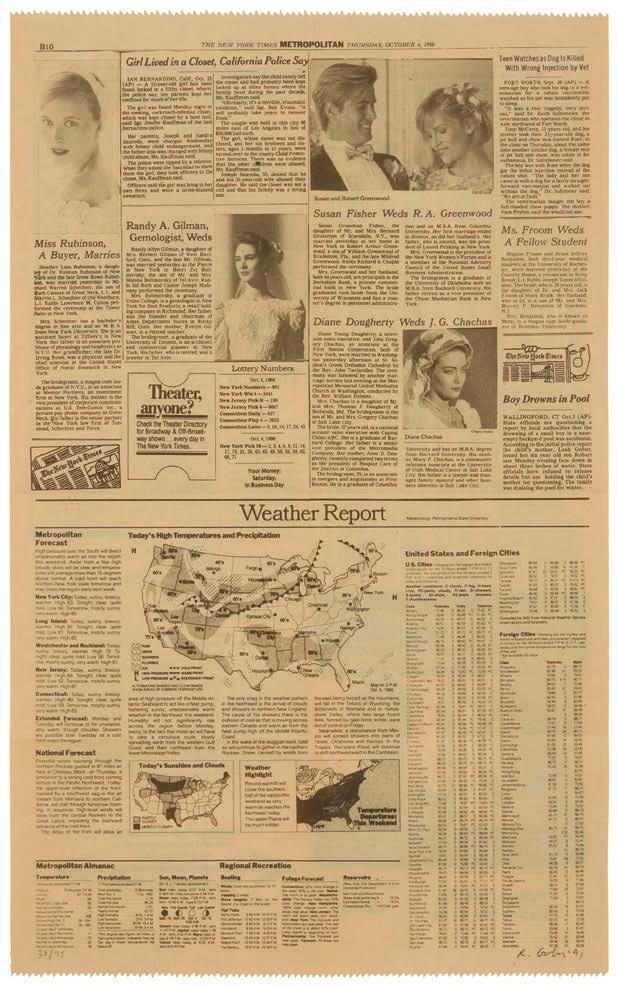
Robert Gober
(b. 1954)
Untitled, for “Parkett” vol 27, 1991
Photolithograph on newsprint paper (hand-colored with coffee by the artist) with hand-torn edges, printed on both sides, and folded three times, all as issued Edition: 38/75
Signed, dated, and numbered in pencil in the lower margin: R. Gober ‘91; Maurice Sanchez and Joe Petruzzelli, prntr.; Derrière L’Étoile Studios, New York, NY, pub. Image: 20.75” H x 13” W; Sheet: 22.25” H x 14” W
$600-900
Provenance: The artist
Burnett Miller Gallery, Los Angeles, CA
Literature: Parkett Magazines, “Parkett Vol. 27 - 1991: Robert Gober” (Zürich and New York: Parkett Magazines, 1991), 78-79.

167
William Dole (1917-1983)
“Landfall,” 1980
Watercolor, ink, gold leaf, and collage on thick wove paper
Signed and dated in ink lower right: W. Dole 1980; titled in pencil, verso Image: 20” H x 15.625” W (approx.); Sheet: 22” H x 17” W
$1,000-1,500
Provenance: Staempfli Gallery, New York, NY

Miguel Osuna has been painting and drawing since moved to Los Angeles. He practiced architectural while visiting Buenos Aires. Upon his return, he engaged extensive series of abstract landscape paintings that
His studio practice frequently involves investigations of abstract work, ‘SPIN,’ in Los Angeles in November present a solo exhibition at the CALTRANS District were included in the 2015 Ping Pong Exhibition in when Ping Pong “bounces” in Miami Beach during “Work Over School” at the Craft Contemporary Art exhibition ‘Ambiguous Reality,’ showing in Naples, residency by the Art 1307 Institution, culminating
His work is part of the permanent collection at the permanent collection of the City of Santa Monica,
since an early age. He studied architecture in Mexico, and a year after graduating, architectural design in diverse industries through 2001. In 2002 he started painting full-time engaged in an exploration of Los Angeles, his adopted hometown, through an that continue.
investigations of different techniques, applications, and materials. He presented a new body November of 2012. He was invited by the California Department of Transportation to District 7 Headquarters on November 2013. Works from his new series “The Bends” in Basel, Switzerland during the 2015 Art Basel Art Fair in June, and in Miami Beach during Art Basel Miami, in December 2015. His work was included in the exhibition Art Museum of Los Angeles in September 2016. His work was also included in the Naples, Italy in December 2017, where he was subsequently invited to a three-month art culminating in a solo exhibition in May of 2018.
the Pio Monte della Misericordia Museum in Naples, Italy. His work is also in the Monica, CA. Osuna lives and works in Los Angeles.

168
Miguel Osuna (b. 1961)
“LA Dusk”
Diptych, Oil on canvas
Appears unsigned; titled twice on the frame’s verso
Each element: 24” H x 48” W
$3,000-5,000
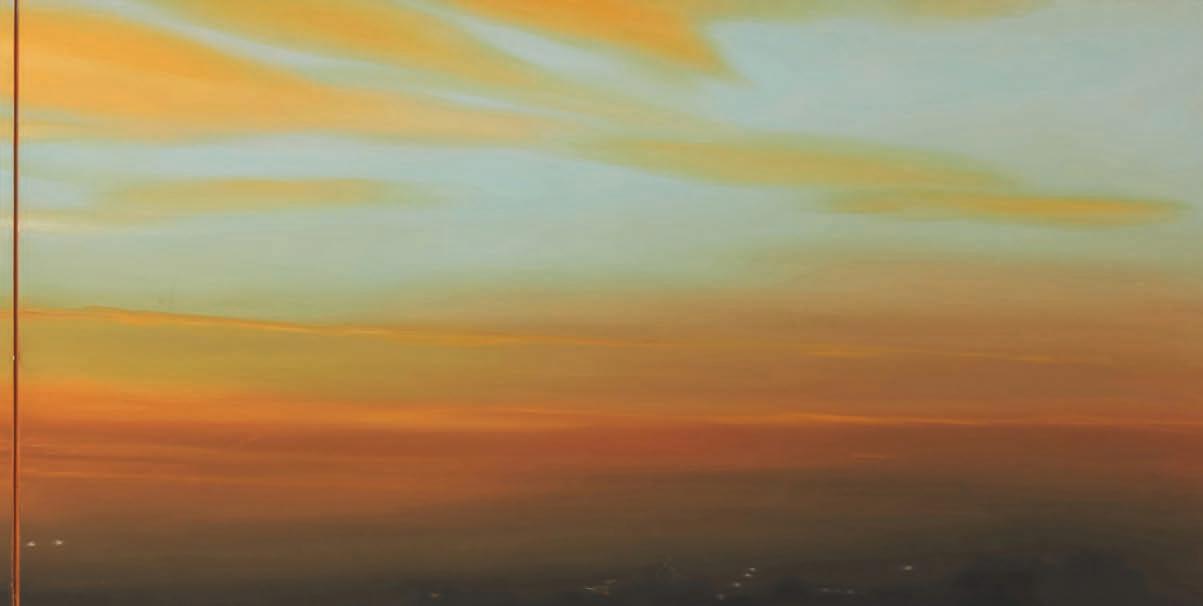

169
Miguel Osuna (b. 1961)
“Contrail,” 2004
Diptych, Oil on canvas
Signed, titled, dated, and numbered on the verso of each element: Miguel Osuna 2K4 #2401
Left element: 48” H x 48” W; Right element: 48” H x 36” W
$3,000-5,000


Miguel Osuna (b. 1961)
“Night Highway Overpass” Oil on canvas
Appears unsigned; titled by repute 48” H x 48” W
$1,500-2,000

171
Mark Strickland
(b. 20th century)
“Subway Series #2,’’ 1987 Oil on canvas
Signed and dated lower right: M. Strickland 1987; titled by repute 60” H x 72” W
$1,000-2,000
Provenance:
The Collection of David and Holly Davis, Pasadena, CA

Gabriel Gonzalez (b. 1978)
Abstract, 2008
Acrylic on canvas
Signed, dated, numbered “00285,” and indistinctly inscribed, all verso: Gabriel Gonzalez / Jan. 2008
60” H x 60” W
$400-600

Josh Agle, born on August 31, 1962, known professionally distinctive style that captures the essence of mid-century and playful characters, SHAG has become an icon
Growing up in Southern California, SHAG developed 1960s. His artistic journey began during his childhood, visual culture of the time. These early experiences
In the late 1980s, SHAG attended the California allowed him to refine his skills and experiment with time, he also started exhibiting his work in local galleries
It was in the early 1990s that SHAG began to establish modern design, Tiki culture, cocktail lounges, and glamorous and whimsical settings, exuding an air SHAG’s art transports viewers into a retro-futuristic
professionally as Shag (stylized as SHAG), is a contemporary artist widely known for his mid-century modernism and retro pop culture. With his vibrant colors, bold designs, icon in the world of modern art.
developed a deep appreciation for the architecture, design, and fashion of the 1950s and childhood, where he would spend countless hours drawing and immersing himself in the experiences would later shape his artistic vision and inspire his signature style.
State University, Fullerton, where he studied both illustration and fine art. His studies with different mediums, including painting, printmaking, and sculpture. During this galleries and art shows, slowly gaining recognition for his unique approach to art.
establish his distinct style, drawing inspiration from Palm Springs culture, mid-century and vintage advertising. He created a universe of characters, often depicted in air of sophistication and mystery. With his masterful use of flat colors and sharp lines, retro-futuristic world that feels simultaneously nostalgic and contemporary.

173
Josh Agle (aka SHAG) (b. 1962) “Paternity”
Acrylic on panel
Signed lower left: SHAG; titled by repute 24” H x 48” W
$8,000-12,000

174
Josh Agle (aka SHAG) (b. 1962)
“Match Game,” 2005
Acrylic on panel
Signed lower left: SHAG; signed again, titled, and dated in pencil, all verso: Josh Agle / © 2005 24” H x 40” W
$7,000-9,000
Provenance: Billy Shire Fine Arts, Culver City, CA


Josh Agle (aka SHAG) (b. 1962)
“Cyclops at the Beat Club”
Acrylic on panel
Signed lower left: SHAG 15” H x 24” W
$5,000-7,000
Provenance: Outré Gallery, Melbourne, Australia
Notes:
According to SHAG, “ ‘Cyclops at the Beat Club’ was one of the first 20 paintings I did and was sold at Outré Gallery in Melbourne, Australia in 1997. In those days I framed all my paintings myself by hand, and this is no exception. I had a significant quantity of gold bamboo moulding which I would spray paint and stain to look like natural bamboo. When I look at it now, it seems a bit cheap, but it’s the original frame so it should stay with the painting. It’s hard to believe that it’s 28 years old.”

176
Frédéric Bruly Bouabre (1923-2014)
“Qui vous invitera au jeu de l’amour quand vous êtes en endeuillés!,” 2005
Each: Ink, colored crayon, and pencil on heavy cardstock
Each signed and dated in ink, verso: FB Bouabre / 30-11-2005; titled and inscribed in French and in ink along each edge with the same inscription, except on each card, three words change to represent colors and a Nationality: “ici homme / et femme [interchangeable color] en voyage dans l’ocean [interchangeable color] / sur les cote [interchangeable Nationality]”; 40 pieces
Each sheet: 7.5” H x 6” W
$1,000-2,000

Frédéric Bruly Bouabre (1923-2014)
“T’che la Palme de la main,” 2007
Each: Ink, colored crayon, and pencil on heavy cardstock
Each signed and dated in ink, verso: FB Bouabre / 14-8-2007; titled and inscribed in French and in ink along each edge with the same inscription, except on each card, one word changes to represent a Nationality: “vue dans / L’Orient du ciel sud de la / terre [interchangeable Nationality] symbolisant ici l’innocence / de la saint humanité”; 40 pieces
Each sheet: 7.5” H x 6” W
$1,000-2,000

Consign Today
Art + Design
September 17, 2025
Magdalena Abakanowicz
“Atoris,” 2005
Price Realized: $82,550
Consignment and Auction Inquiries: fineart@johnmoran.com
SINCE 1969















1
Overall good condition. The full sheet with deckled edges. Very pale time-staining along the verso of the extreme upper sheet edge. A very soft 1” horizontal handling crease near the center of the right edge, mostly visible in raking light. A pinhead-sized area of possible printer’s ink or staining on the verso of the lower right sheet corner. The sheet is hinged to the overmat with three pieces of clear tape from the verso of the upper sheet edge.
Framed under glass: 28.625” H x 32.5” W x 2” D
2
Overall good condition. The full sheet with deckled edges. Two very pale traces of vertical staining along the left and right edges, possibly attendant with previous matting. Occasional, very pale pinpoint-sized (or smaller) foxmarks scattered near the lower edge. A 1” very soft, horizontal crease above the signature, primarily visible in raking light. A rice-sized abrasion on the extreme upper margin edge, right of center, mostly visible on the verso. The sheet is hinged to the overmat with three pieces of clear tape from the verso of the upper sheet edge.
Framed under glass: 28.625” H x 32.5” W x 2” D
3
Overall good appearance. The sheet with full margins. Pale light-staining attendant with the window opening of the mat. A pinhead-sized foxmark in the woman’s chest, and another, much paler, foxmark in the blank at left. A small, pale and unobtrusive stain in the upper left margin corner. Old hinging residue at the verso of the upper margin corners. The sheet is hinged to the back mat with linen tape from the verso of the upper margin corners.
Framed under glass: 24.5” H x 18.5” W x 1” D
4
Overall good appearance. With wide (possibly full) margins. Two tiny foxmarks in a shoulder and arm of the sleeping figure. Occasional very minor and unobtrusive specks of surface grime and/or foxing in the lower margin and verso. A 2.5” H x 2.5” W paper gallery sticker affixed to the verso of the lower right margin corner. An unidentified blue ink stamp on the verso of the lower left margin corner. Two old white paper hinges at the verso of the upper margin corners with attendant slight cockling of the paper in those corners. The sheet is loose, not matted.
Unframed
5
Overall generally good appearance. With wide (possibly full) margins, the lower and right margin edges deckled. Approximately 0.375” wide bands of mat staining showing along the window opening of the overmat. Occasional, minor handling marks scattered in the outer margins. Scattered areas of faint printer’s ink marks on the verso, not affecting the recto. The sheet is hinged to the back mat with two small pieces of hinging tape from the upper margin corners.
Framed under glass: 19.5” H x 14.75” W x 1” D
6
With wide margins, deckled at right. Scattered soft handling marks, surface soiling, and uneven, minor staining, showing in the margins and on the verso. A series of flattened creases and one tiny edge tear measuring 0.125” along the upper portion of the left margin edge. With a purple ink French tax stamp and a large brown ink inscription in another hand, both verso: “Still Life by Braque, G.” Hinged to the back mat with Japanese tissue hinges from the verso of the upper margin edge.
Framed under Plexiglas: 32.5” H x 16.75” W x 0.75” D
7
Overall good appearance. With margins. A 4” diagonal printer’s crease affecting both the image and upper margin in the upper left quadrant. A pea-sized, pale foxmark in the upper left quadrant of the image. Not examined out of the frame.
Framed under glass: 25.125” H x 22.125” W x 2” D
8
Overall good appearance. Full margins with deckled edges. A few soft handling marks in the upper and lower margins, primarily visible in raking light. Three rectangular hinging and glue remnants with attendant surface skinning at the verso of the lower margin edge and the center of the left margin edge. The sheet is framed floating, hinged to the back mat from the verso of the upper margin and the center of the right margin edges.
Framed under Plexiglas: 35.25” H x 28.5” W x 1.75” D
9
Overall good appearance. The full sheet with deckled edges, and the colors good. The sheet possibly very slightly toned. The sheet is framed floating, hinged to the back mat from the verso of the sheet corners. Not examined out of the frame.
Framed under Plexiglas: 41.5” H x 34.5” W x 1.5” D
10
Overall good appearance. With full margins deckled along the right and lower edges. The colors fresh. The hinges on the verso showing through to the recto ever so slightly in the upper margin corners. The sheet is framed floating, hinged to the back mat at the verso of the margin corners.
Framed under Plexiglas: 29.5” H x 24.25” W x 1.75” D
11
Overall good condition. Full margins with deckled edges and the colors good. Pale light-staining showing in the margins. A band of very slight surface skinning along the verso of both the upper and lower margin edges, attendant with prior removal of old tape. The work is now hinged to the back mat from the verso of the upper margin corners.
Framed under glass: 29” H x 32” W x 1.5” D
Overall generally good condition. With full margins. Pale light-staining. Very slight surface skinning and traces of tape residue in a few places at the upper and lower margin edges from removal of previous hinges. The sheet is hinged to the back mat from the verso of the upper margin edge.
Framed under Plexiglas: 33.25” H x 36” W x 1.5” D
13
Overall good appearance. Full margins with deckled edges. The sheet is hinged to the overmat with a long band of tape from the verso of the extreme upper margin edge.
Framed under Plexiglas: 39” H x 30” W x 1.125” D
14
Full margins with deckled edges along the right and lower edges. The sheet slightly toned throughout and with old backboard staining showing through from the verso throughout the image and into the margins, and yet the colors are still quite good. A few soft handling marks in the upper margin, visible primarily in raking light. Staining from two old pieces of masking tape showing through from the verso of the upper margin corners. The sheet is loose, secured to the back mat with four clear archival corners.
Framed under glass: 40” H x 30.75” W x 1.75” D
15
Overall good appearance. Full margins deckled along the right and lower edges. A few very slight handling marks, one near the center of the right margin and one near the center of the upper margin, both visible only in raking light. The sheet is framed floating, hinged to the back mat from the verso of the margin corners.
Framed under Plexiglas: 32” H x 24.5” W x 1.5” D
16
With wide margins. Remnants of old light- and mat staining. The colors attenuated, most noticeably in the reds and purples. A rice-sized area of slight wear at the left of the extreme upper margin edge. A very soft handling mark in the lower margin, just below the signature. The sheet is loose, secured to the back mat with four archival corners.
Framed under Plexiglas: 20.5” H x 23.25” W x 1.5” D
17
Overall good condition. Full margins with deckled edges. A few scattered handling marks throughout. Four 0.75” diagonal indentations in the paper along the right margin edge. A very pale, unobtrusive, 0.25” area of surface soiling in the lower portion of the right margin edge. The sheet is framed floating, tipped to the back mat from the verso of the upper margin corners.
Framed under glass: 37.5” H x 26.5” W x 2” D
18
With margins and deckled edges, but no longer the full margins. Large chunks of the margin edges and corners torn off, the largest areas being in the upper left margin edge and corner, and the lower right margin corner; the lower left margin corner with scattered pea-sized punctures, a 1” H x 0.5” W tear and a few smaller ones, and minor creases, all not affecting the image. A 4” diagonal crease running through the image and affecting the printed signature in the lower left corner. A soft 1” horizontal crease to the right of the black printed image in the upper right quadrant. The verso sheet with pale pinhead-sized (or smaller) occasional foxmarks scattered on the verso, mostly visible in raking light, and not showing on the recto. The sheet is hinged to the overmat with a long band of tape from the verso of the upper margin edge.
Framed under Plexiglas: 42.625” H x 32.125” W x 2” D
19
The full sheet. Pale toning throughout, both recto and verso. Several soft horizontal ripples across the upper portion of the sheet. An approximately 1.5” H x 0.5” W scattered stain (possibly stray printer’s ink) in the image near the right edge. Traces of green printer’s ink in the upper portion of the left sheet edge. The lower sheet corners very slightly dog-eared. The sheet is loose, not matted.
Unframed
20
Overall good appearance. Full margins with deckled edges. The colors good. A very soft 1” vertical handling mark in the lower right margin corner, primarily visible in raking light. The sheet is framed floating, hinged to the back mat. Not examined out of the frame.
Framed under Plexiglas: 55.5” H x 44.25” W x 2.125” D
21
Each overall good condition. Full margins/sheets with deckled edges and the colors fresh. As mentioned, the title page, four plates, and the colophon, each loose, and separated by individual tissues (except in-between the last plate and the colophon).
Unframed
22
Overall good appearance. The full sheet with deckled edges. The sheet is framed floating, hinged to the back mat. Not examined out of the frame.
Framed under glass: 27.5” H x 35” W x 2.125” D
23
Visual: Overall generally good appearance. Occasional small, flaked losses to the copper leaf scattered throughout, primarily in the background. An unobtrusive 1.25” horizontal surface scratch in the lower left corner of the image. Very soft stretcher bar creases, primarily visible in raking light.
Blacklight: No evidence of restoration.
Unframed
24
Overall good appearance. Not examined out of the frame.
Framed under glass: 31” H x 35” W x 1” D
25
Overall good appearance. Full margins with deckled edges. Very pale time staining. The sheet is framed floating, hinged to the back mat from the verso of each of the margin corners. Not examined out of the frame.
Framed under Plexiglas: 23.125” H x 18.625” W x 1.25” D
26
Overall good condition. The sheet is framed floating, hinged to an invisible matboard from the verso of the sheet edges, and that matboard is subsequently affixed to the back mat.
Framed under Plexiglas: 16.5” H x 16.5” W x 1.5” D
27
Overall good condition with minor shelf wear, scuffs, and light scratches commensurate with age.
28
Overall good condition with minor shelf wear, scuffs, and light scratches commensurate with age.
29
Overall good condition with minor shelf wear commensurate with age.
30
Overall good condition with minor shelf wear commensurate with age. Dust jacket in good condition with wear at edges and corners and a 3” long area of scuffing to front at middle of title text. Scuffing to page ends.at side edge.
31
Overall very good condition. All of the screenprints with full sheets and the colors fresh, having seemingly been stored within the portfolio rather than framed and/or exposed to light. Very slight curling to the extreme edges of the protective sleeve at the back of the portfolio, not affecting the loose prints stored within. Slight edge wear and minor fading to the fabric-covered boards of the portfolio.
Portfolio: 17.5” H x 14.25” W x 0.5” D
32
Overall generally good appearance. With margins. Uneven toning throughout the margins. A pale, pea-sized area of staining in the upper portion of the left margin. Occasional hairline pigment losses scattered in the image, a few near the center of the left edge, and others in the lower right quadrant, the largest measuring 2”. Not examined out of the frame.
Framed under glass: 24.25” H x 30.25” W x 1” D
33
Overall good appearance. Not examined out of the frame.
Framed under Plexiglas: 52.25” H x 40.5” W x 3” D
34
Overall good appearance. With margins. A few minor handling marks scattered along the lower margin. Not examined out of the frame.
Framed under Plexiglas: 46.125” H x 41.25” W x 1.625” D
35
Overall good appearance. With margins. The colors good. Not examined out of the frame.
Framed under glass: 33.75” H x 21.5” W x 1.5” D
36
Overall good appearance. With margins. Not examined out of the frame.
Framed under Plexiglas: 38.25” H x 50.25” W x 2” D
37
Overall good appearance. Slight abrasions along each extreme edge. The work is framed floating, mounted to the back mat. Not examined out of the frame
Framed under glass: 12.25” H x 17.75” W x 1.75” D
38
Overall generally good appearance. The sheet is dry mounted to the back mat. The overmat with sticky tape along the edges, making it difficult to gain access to the full sheet.
Framed under glass: 21.375” H x 16.5” W x 1.375” D
39
Overall good appearance. Two pale pinpoint-sized foxmarks on the matboard, one to the right of the upper edge, and the other near the center of the right side. A small abrasion on the matboard, at the center of the extreme lower edge. As mentioned, the sheet is mounted to a matboard, as issued.
Unframed
40
Overall good appearance. “Untitled, number 17” with two short lines of scattered, very delicate touch-up along the figure’s shoulders, presumably in the hand of the artist, visible only in raking light. “Untitled, number 21” with a few scattered specks of grime near the center of the left edge, visible only in raking light. “Untitled, number 35” and “Untitled, number 56” both secured to their back mats with clear archival corners. Each of the others examples is hinged to its overmat with clear tape from the verso of the matboard mount’s upper edge.
Each unframed
41
Overall good appearance. A soft 3” diagonal crease in the upper right margin corner, slightly affecting the image. Two specks of grime near the center of the lower margin. Cockling along the left and right edges. The sheet is framed floating, hinged to the back mat in two places from the verso of the upper margin edge.
Framed under Plexiglas: 41.25” H x 34” W x 2” D
Each overall good condition. As mentioned, the title page and 12 mounted prints, each loose, and separated by individual interleaving tissues, all housed together in the original, black, cloth-covered portfolio, as issued.
Black cloth-covered portfolio: 19” H x 16” W x 1.5” D
43
Overall good appearance. The matboard with pale time staining along the extreme edges. Two very pale pinpointsized foxmarks on the matboard, one at the center of the left side, and the other in the lower portion of the right side. As mentioned, the sheet is mounted to a matboard, as issued.
Unframed
44
Overall good appearance. The paper mount with minor surface soiling in the upper left corner. Two unobtrusive handling marks under the signature near the lower right corner of the paper mount, each less than an inch, mostly visible in raking light. As mentioned, the sheet is mounted to a paper mount, as issued.
Unframed
45
Overall good appearance. The sheet with deckled edges. Pale time staining and occasional surface staining. A few very minor, soft handling marks, and slight cockling, primarily in the outer edges. Artist pinholes in each corner, with attendant circular staining in the upper corners. A small area of paper loss in the lower left corner. The sheet is framed floating, tipped to the back mat from the verso of the sheet corners and edges.
Framed under glass: 25.5” H x 31.5” W x 1.5” D
46
Visual: Overall generally good appearance. Scattered craquelure throughout, heavily concentrated in the lower half. Scattered tiny bubbles beneath the surface of the pigment, likely due to imperfections in the board.
Blacklight: Rice-sized (or smaller) touch-ups scattered primarily in the lower half.
Frame: 38” H x 30” W x 2.25” D
47
Visual: Overall good appearance.
Blacklight: A 2” H x 1” W zig-zag-shaped touch-up and other smaller touch-ups scattered in the sky, and a 0.75” H x 0.5” W area of touch-up and other smaller touch-ups scattered near the center of the left edge.
Frame: 25.75” H x 33.75” W x 1.75” D
48
Visual: Surface grime throughout. A 0.25” H x 1.25” W abrasion with attendant pigment loss in the lower right quadrant, just below the leftmost tower of the bridge, and a few more minor, rice-sized abrasions with attendant pigment loss at the center of the lower edge. A 2” diagonal hairline scratch near the lower right corner, and another, softer, 3” horizontal scratch on the right portion of the bridge.
Blacklight: The two scratches mentioned above fluoresce under blacklight.
Frame: 31.25” H x 43.25” W x 1.75” D
49
Visual: Overall good condition.
Blacklight: No evidence of restoration.
Frame: 38.5” H x 30.25” W x 2.5” D
50
Visual: Overall good condition.
Blacklight: No evidence of restoration.
Frame: 30.25” H x 38.25” W x 2.25” D
51
Visual: Overall good appearance. Specks of grime and minor varnish discoloration. An approximately 2” H x 2.5” W area of very pale grime or varnish discoloration in the sky near the center of the upper edge. A very unobtrusive dime-sized area of fine craquelure in the white pigment, near the center of the left edge, primarily visible in raking light. Minor, scattered frame abrasion in places along the extreme upper edge and the lower portion of the extreme right edge.
Blacklight: No evidence of restoration.
Frame: 30.625” H x 22.625” W x 2.125” D
52
Visual: Overall generally good appearance. Two large areas of varnish discoloration or grime in the upper corners, the largest approximately 2” H x 2.5” W in the upper left corner.
Blacklight: No evidence of restoration.
Frame: 30” H x 22.5” W x 2” D
53
Visual: Overall good appearance. Occasional, unobtrusive, fine craquelure scattered in areas of the impasto.
Blacklight: No evidence of restoration.
Frame: 33.25” H x 36.875” W x 2.5” D
54
Visual: Overall good condition.
Blacklight: No evidence of restoration.
Frame: 29.5” H x 23.5” W x 3” D
55
Visual: Overall good condition.
Blacklight: No evidence of restoration.
Frame: 51” H x 51” W x 4” D
56
Overall generally good appearance. Minor cockling throughout, attendant with the medium used. Scattered very small and generally unobtrusive surface scratches, the longest 1.5,” with an area of scratches concentrated in the figure’s lower back. Soft creases scattered primarily in the upper right quadrant, mostly visible in raking light. Artist pinholes and tiny edge tears in places along the extreme edges of the sheet.
Framed under Plexiglas: 33.25” H x 39.5” W x 2.25” D
57
Visual: Overall good appearance. Dust accumulation and grime commensurate with age and materials used.
Blacklight: No evidence of restoration.
Frame: 49.5” H x 27.5” W x 1.75” D
58
Uneven, pale toning throughout. Three horizontal creases extending across the sheet. Two of them extending through the image in the upper half, and the other in the blank outside the image near the lower edge of the sheet. These creases sometimes partially broken through in places as tears. A 1” H x 0.75” W, tongue-shaped, repaired tear in the lower portion of the right edge. A 1.625” diagonal crease across the upper left corner. Oil pooling around the pigments, inherent in the material used. Slight surface soiling, staining, and other minor defects. As mentioned, the sheet is laid to cardstock. The work is loose, secured to the back mat with three clear archival corners.
Framed under Plexiglas: 24.75” H x 19.5” W x 1.75” D
59
Overall good appearance. An unobtrusive pinhead-sized pigment loss in the dark purple square of the upper right quadrant. Artist pinholes in the upper corners. Pale foxing, a 0.75” W band of surface skinning along the extreme edges, and a few scattered areas of tape remnants, all on the verso and not affecting the recto. The sheet is taped to the overmat with four pieces of white hinging tape from the verso of the upper and lower sheet edges.
Framed under Plexiglas: 21.75” H x 19” W x 2” D
60
Visual: Overall good condition.
Blacklight: No evidence of restoration.
Frame: 24.75” H x 24.875” W x 1.5” D
61
Visual: Overall good appearance. A pinhole near the lower left corner.
Blacklight: No evidence of restoration.
Frame: 14.5” H x 13.75” W x 1.75” D
62
Visual: Overall good appearance. Small, scattered, unobtrusive areas of craquelure. Soft stretcher bar creases along each side. Minor surface soiling along the extreme upper edge and corners.
Blacklight: No evidence of restoration.
Frame: 27” H x 33.125” W x 2” D
63
Visual: Overall good appearance. Dust accumulation and grime. A few minor, scattered, hairline cracks, possibly intrinsic to the creation.
Blacklight: No evidence of restoration.
Unframed, weight approximately 75 lbs
64
Visual: Overall generally good condition. Dust accumulation as well as occasional scattered craquelure, and flecks of grime, all commensurate with age. A 0.5” H x 0.125” W puncture and nearby 1.25” diagonal abrasion, both with attendant pigment losses, in the black background of the upper right quadrant. Slight stretcher bar creases and occasional minor surface scuffing at the extreme edges.
Blacklight: No evidence of restoration.
Frame: 40.5” H x 55.5” W x 1” D
65
Visual: Overall good appearance. A few artist’s pinholes in the upper corners. An approximately pea-sized area of the Masonite showing through near the bottom of the extreme right edge, however this appears to be in the hand of the artist.
Blacklight: No evidence of restoration.
Frame: 45.75” H x 34” W x 4” D
66
Overall good condition with scattered scuffs, dust accumulation, and darkening/oxidation to bronze commensurate with age. Scattered small losses to patination throughout.
67
Overall good condition with scattered minor scuffs and darkening/oxidation to bronze commensurate with age. Plinth with small chipped losses at corners.
Overall good condition with scattered minor scuffs, dust accumulation, and darkening/oxidation to bronze commensurate with age. Adhesive residue to plinth.
69
Overall good appearance. Very pale and uneven lightstaining, primarily visible in the upper half of the work. Not examined out of the frame.
Framed under glass: 24” H x 20” W x 2.25” D
70
Overall good appearance. A pinpoint-sized foxmark in the upper edge, at right. Not examined out of the frame.
Framed under glass: 30.25” H x 23” W x 1.25” D
71
Overall good condition. Not examined out of the frame.
Framed under glass: 23.75” H x 18.25” W x 2.25” D
72
Visual: Overall good appearance. Specks of grime. Very fine, unobtrusive paint shrinkage scattered in the black pigment along the lower edge. Occasional, minor wear and abrasion along the extreme edges.
Blacklight: No evidence of restoration.
Frame: 10.25” H x 14.5” W x 1.75” D
73
Visual: Overall good appearance. An unobtrusive, pea-sized spot of grime and some very minor, scattered craquelure in the white pigment near the center of the extreme left edge.
Blacklight: No evidence of restoration.
Frame: 37.5” H x 27.5” W x 2.5” D
74
Visual: Overall good appearance. Scattered areas of craquelure.
Blacklight: No evidence of restoration.
Frame: 31.125” H x 41.125” W x 1.75” D
75
Visual: Overall good appearance. Craquelure scattered throughout. Occasional specks of grime.
Blacklight: An approximately 2.5” diameter touch-up in the background to the right of the figure’s head. Uneven varnish application.
Frame: 50.5” H x 36” W x 2.5” D
76
Visual: Overall good appearance. Scattered specks of grime. Fine, scattered craquelure, and an area of unstable craquelure with two attendant pinhead-sized (or smaller) pigment losses in the background of the lower right quadrant. Soft stretcher bar creases along each side, mostly visible in raking light. A very faint, unobtrusive, hairline, scattered surface scuff mark or line of grime near the lower right corner.
Blacklight: No evidence of restoration.
Frame: 26.375” H x 19” W x 3” D
77
Visual: Overall good condition.
Blacklight: No evidence of restoration.
Unframed
78
Light-staining and uneven toning throughout. A repair to an irregular 3.5” H x 2” W jagged tear extending vertically from the center of the lower sheet edge. Scattered creasing, primarily in the outer edges. The sheet is trimmed slightly unevenly. As mentioned, the sheet is laid to board.
Framed under glass: 21.75” H x 16.75” W x 2” D
79
Visual: Overall good appearance. Dust accumulation and grime. Very fine, unobtrusive craquelure scattered in places throughout, primarily visible in raking light.
Blacklight: No evidence of restoration.
Frame: 22.75” H x 17.125” W x 3” D
80
Visual: Overall generally good appearance. Dust accumulation and grime. A pea-sized area of grime/residue at the center of the left edge. A split in the panel along the left edge, presumably just the natural cracking of the panel. A thin, 0.5” surface scratch to the left of the nun’s head.
Blacklight: No evidence of restoration.
Frame: 22.75” H x 17” W x 2.5” D
81
Visual: Overall good appearance. Grime scattered throughout. Scattered, fine, hairline craquelure and some areas of unstable craquelure with small pigment losses in the lower left and upper right quadrants.
Blacklight: Specks of grime fluoresce under blacklight.
Frame: 22.875” H x 17” W x 3” D
82
Visual: Overall good appearance. Dust accumulation, grime, and minor varnish discoloration. Very fine, unobtrusive craquelure, mostly visible in raking light, one area of craquelure with attendant pigment loss at the center of the right edge. Minor paint shrinkage in the figure’s clothing and the trees in the upper left quadrant.
Blacklight: No evidence of restoration.
Frame: 22.875” H x 17.125” W x 3” D
83
Visual: Scattered specks of grime throughout. Stretcher bar creases along each edge. A 1.5” H x 1” W reverse pressure mark with attendant craquelure in the cheek of the left figure, and another, smaller, in the extreme lower right corner with an attendant pinhead-sized area of wear.
Blacklight: No evidence of restoration.
Frame: 43.5” H x 32” W x 2.25” D
84
Visual: Overall good appearance. Fine craquelure scattered throughout. A few pigment losses scattered along the extreme upper edge and the upper portion of the extreme right edge, the largest measuring 0.125” H x 0.75” W. The board creased/warped in the upper right quadrant.
Blacklight: No evidence of restoration.
Framed under glass: 34.625” H x 28.625” W x 1.25” D
85
Visual: Overall good condition.
Blacklight: No evidence of restoration.
Frame: 19.5” H x 23.375” W x 2” D
86
Visual: Overall good appearance. Stretcher bar creases and scattered specks of grime throughout. Very minor craquelure in the thicker pigments.
Blacklight: No evidence of restoration.
Frame: 27.5” H x 41.5” W x 1” D
87
Visual: Overall generally good appearance. A 4” horizontal scratch with an attendant 1.5” tear in the left portion of the scratch, in the lower right corner. Craquelure primarily in the black and white pigments, and a few attendant peasized (or smaller) pigment losses in the lower half, plus one in the black circle of the upper left quadrant.
Blacklight: No evidence of restoration.
Frame: 39.5” H x 39.5” W x 2” D
88
Visual: Overall good appearance. Scattered specks of grime, primarily in the outer edges. Stretcher bar creases along each edge. Scattered craquelure with an attendant pinpoint-sized pigment loss in the upper portion of the right edge. A 0.75” H x 0.125” W surface scuff in the left portion of the lower edge, and a few more minor hairline surface scuffs scattered primarily in the center of the lower half.
Blacklight: No evidence of restoration. Grime and surface scuffs fluoresce under blacklight.
Frame: 45.25” H x 35.25” W x 2.75” D
89
Visual: Overall generally good appearance. Craquelure and paint shrinkage throughout, and areas of scattered, unstable craquelure with attendant pigment losses. The upper stretcher with newer keys.
Blacklight: A 2” H x 1” W thin, sideways ‘Y-shaped’ touchup near the upper portion of the left edge, and other occasional penny-sized (or smaller) touch-ups scattered in the left half of the work.
Frame: 37” H x 29” W x 2” D
90
Overall generally good appearance. Pale toning throughout. Slight cockling to the sheet showing primarily near the edges, outside the image. A few soft creases near the sheet corners, some of which just affect the corners of the image but are primarily visible in raking light. An artist pinhole in each corner of the sheet, a few short tears and pinhead-size paper losses at the sheet edges, none of which affect the image. Small remains of old paper hinges and adhesive in places at the verso of the upper sheet edge and upper corners. The sheet is loose, not matted.
Unframed
91
Pale toning concentrated primarily along the window opening of the mat. Several vertical bands of soft cockling affecting the right half of the sheet, spanning from the upper to lower edges, visible primarily in raking light. A 7.25” vertical tear, predominantly in the blank, in the lower right quadrant. Two irregular tears that have been partially repaired, the longest approximately 3”, near the center of the left edge, and the other, smaller, in the center of the upper edge. A few scattered pinhead-sized (or smaller) foxmarks in places primarily along the upper edge. The sheet is sandwiched in its mat.
Framed under glass: 22.75” H x 25.625” W x 1” D
Visual: Scattered craquelure throughout. A 14” nearly vertical crease with attendant craquelure and a few unobtrusive, pinpoint-sized pigment losses near the left edge. Occasional rice-sized (or smaller) pigment losses near the right edge. Slight wear along the extreme edges of the painting where previously wrapped around a stretcher. As mentioned, the painting has been removed from its original stretcher and is currently stapled to a backing board along the unpainted edges of the canvas
Blacklight: No evidence of restoration.
Frame: 21.75” H x 25.5” W x 1.75” D
93
Visual: Overall good appearance. A few scattered and unobtrusive pea-sized (or smaller) pigment losses. Two slight surface scuffs near the lower edge, the longest being a 7” diagonal at lower right, primarily visible in raking light.
Blacklight: No evidence of restoration.
Frame: 42” H x 35.5” W x 1.5” D
94
Visual: Overall generally good appearance. A few vertical surface scratches, the longest 5.5” H, and a quarter-sized triangular area of loss, all in the upper right quadrant. Black permanent marker scattered throughout, covering up previous scuffs and losses, possibly in the hand of the artist. Scattered frame abrasion mostly visible in the upper and left edges. The board is slightly convex.
Blacklight: Black permanent marker fluoresces under blacklight.
Frame: 38” H x 47.75” W x 2.75” D
95
Visual: Overall good condition.
Blacklight: No evidence of restoration.
Frame: 31” H x 43” W x 2” D
96
Visual: Overall good condition.
Blacklight: No evidence of restoration.
Frame: 32” H x 27” W x 1.5” D
97
Visual: Overall good appearance. Minor dust accumulation and slight frame abrasion. An unobtrusive 1” area of craquelure and a pinhead-sized pigment loss at the tip of the impasto, both in the upper right quadrant.
Blacklight: No evidence of restoration.
Frame: 39.75” H x 32” W x 3.5” D
98
Visual: Overall good appearance. Rice-sized (or smaller) areas of minor wear to the pigment, mostly in the impasto of the pigments. A few thin, faint, scuffmarks, primarily visible in raking light, all scattered in the upper half of the work.
Blacklight: No evidence of restoration.
Unframed
99
Visual: Overall good appearance. Very fine craquelure along the extreme edges. A 0.5” vertical scuff with an attendant pinhead-sized pigment loss near the lower left corner. A few minor, small surface scuffs scattered in the outer edges. A speck of grime in the light orange pigment in the upper right quadrant.
Blacklight: No evidence of restoration.
Frame: 37.5” H x 73.5” W x 2” D
100
Visual: Overall generally good appearance. Fine craquelure scattered primarily in the left half of the work. A faint 39” horizontal scuff in the upper half of the work, and a few other 1” or smaller faint scuff marks in the lower right quadrant.
Blacklight: No evidence of restoration.
Frame: 31” H x 40.75” W x 1.5” D
101
Visual: Overall good appearance. Very fine craquelure in places along the extreme upper edge.
Blacklight: No evidence of restoration.
Frame: 20.625” H x 27.5” W x 2.5” D
102
Visual: Overall good condition.
Blacklight: No evidence of restoration.
Unframed
103
Overall good condition.
Frame: 53” H x 69” W x 2” D
104
Visual: Overall good appearance. A stretcher bar crease along the left edge, primarily visible in raking light. A peasized pressure mark in the purple pigment of the lower portion of the left edge, and another in the light yellow pigment of the upper right quadrant.
Blacklight: No evidence of restoration.
Frame: 30.5” H x 40.5” W x 1.75” D
105
Overall good appearance. Dust accumulation and minor grime. Scattered surface scratches and scuffs, with some areas of small pigment losses to the tips and edges of the pyramids.
Frame: 36” H x 36” W x 4” D
106
Visual: Overall good appearance. Minor abrasions scattered along the extreme edges. The frame’s backing board has not been removed.
Blacklight: No evidence of restoration.
Frame: 41.25” H x 35” W x 2” D
107
Overall good appearance. A few small surface scratches, scattered primarily at the center of the upper half of the work, mostly visible in raking light. Some minor wear to the gold leaf edges.
Unframed
108
Visual: Overall good appearance. A 0.25” area of unstable pigment with an attendant rice-sized pigment loss in the lower portion of the extreme right edge.
Blacklight: No evidence of restoration.
Frame: 23” H x 29” W x 2” D
109
Visual: Overall good appearance. A 1.25” H x 0.5” W pigment loss near the upper right corner. An approximately 3” diameter pressure mark and a few scattered pea-sized pressure marks in the upper right quadrant, primarily visible in raking light and from the verso.
Blacklight: No evidence of restoration.
Frame: 40.75” H x 52.5” W x 2.5” D
110
Visual: Overall good appearance. A 0.5” rice-size puncture in the canvas, with an attendant pressure mark and a small, minor, stretcher bar crease, all near the upper edge, at right.
Blacklight: No evidence of restoration.
Frame: 30.5” H x 26.25” W x 2” D
111
Visual: Dust accumulation and scattered grime throughout. Bubbling and crazing to the surface of the pigments, primarily in the areas of heavier impasto in the upper half, with attendant pigment losses revealing the underlying gesso. The largest of these losses is approximately 0.75” H x 0.5” W at upper center, a few others are pea-sized, but most are rice-sized or smaller. Wear, rubbing, and small losses to the panel along the extreme edges and corners. Other minor defects.
Blacklight: No evidence of restoration.
Unframed
112
Visual: Dust accumulation, dirt, and scattered grime throughout. Various superficial cuts, small gouges, accretions, and other irregularities presumably on the surface of the Masonite when repurposed by the artist. Occasional scattered pigment losses, pea-sized or smaller. A 10” H x 0.125” W line of scattered pigment losses near the upper edge. Rubbing, wear, and attendant pigment losses in places along the extreme edges, concentrated primarily at the corners. Other minor defects.
Blacklight: No evidence of restoration.
Unframed
113
Visual: Scattered craquelure, dust accumulation, and significant areas of grime throughout. Some irregularities to the paint surface attendant with the plywood panel, including in the sky at upper left, in three pea-sized areas across the uppermost hill, in a pinhead-sized hole near the center of the right edge, and along the center of the left edge. Pinhead-size pigment losses scattered throughout. Occasional wear, splits, and small losses to the panel at the edges, particularly in the lower left corner (with attendant pigment losses).
Blacklight: No evidence of restoration.
Frame: 42.5” H x 23” W x 1.25” D
114
Visual: Dust accumulation and scattered grime throughout. Scattered craquelure mostly attendant with the grain of the plywood. Scattered pigment losses throughout, generally pea-sized or smaller. Damp staining with attendant partial lifting, splitting, and losses to the surface layer and pigment along the lower edge, the largest loss measuring 2” H x 0.625” W in the lower left corner. Other minor defects.
Unframed
115
Visual: Overall good appearance. Dust accumulation and scattered grime throughout. An occasional fleck of possibly unrelated white pigment.
Blacklight: No evidence of restoration.
Unframed
Overall good appearance. Artist pinholes at each of the four corners. Pale, uneven toning on the verso. Hinging and double-sided sticky tape remnants scattered on the verso. The sheet is loose, secured to the back mat with four clear archival corners.
Framed under Plexiglas: 18.75” H x 21.5” W x 1.5” D
117
Overall good appearance. Dust accumulation and minor scattered scuffs and scratches.
Unframed
118
Overall good appearance. Dust accumulation and minor scattered scuffs and scratches. A 0.375” H x 0.75” W area of loss on the underside of the lower edge.
Unframed
119
Overall good appearance. Dust accumulation and minor scattered scuffs and scratches. Scattered areas of fine cracking along the left edge and in the lower left quadrant. The upper portion of the left edge of the work slightly lifting.
Unframed
120
Visual: Overall good condition.
Blacklight: No evidence of restoration.
Frame: 40” H x 28” W x 2.5” D
121
Overall good appearance. With deckled edges. The sheet framed floating, mounted to the back mat from the verso of the sheet corners.
Framed under glass: 24.25” H x 31” x 2” D
122
Overall good appearance. Soft cockling in the blank of the sheet, inherent to the materials used. Artist pinholes at the upper sheet corners. A few, very pale specks of foxing scattered on the verso of the upper left quadrant, primarily visible in raking light. The sheet with the perforated edges from the sketchbook still attached along the upper edge. The sheet is hinged to the overmat with two pieces of tape from the verso of the upper sheet edge.
Framed under Plexiglas: 17.25” H x 14.75” W x 2” D
123
Visual: Overall good appearance. Dust accumulation and occasional specks of grime. Craquelure scattered throughout. A few pinpoint-sized (or smaller) pigment losses at the extreme lower edge, underneath the signature and date, but not affecting them. As mentioned, the canvas has been relined.
Blacklight: A thin, 2” vertical line and a few specks of touch-up at the center of the work. Very occasional specks of touch-up scattered near the lower left corner.
Frame: 29.375” H x 35.375” W x 2” D
124
Visual: Overall good appearance. Craquelure and paint shrinkage scattered throughout the lower half. An unobtrusive, 2” horizontal surface scratch with the tiniest flecks of attendant, scattered pigment loss, near the center of the upper edge. An approximately 5” horizontal, very unobtrusive, surface scuff confined to the top layer of the varnish, seemingly not affecting the pigment, and only visible in raking light, near the center of the lower edge.
Blacklight: No evidence of restoration.
Frame: 55.25” H x 73.5” W x 2.5” D
125
Visual: Overall good appearance. Very minor paint shrinkage, primarily in the orange pigments.
Blacklight: No evidence of restoration.
Frame: 25.5” H x 25.5” W x 2.5” D
126
Visual: Overall good appearance. Fine scattered craquelure with attendant unobtrusive flecks of pigment loss scattered throughout. As mentioned, the canvas has been relined.
Blacklight: Scattered touch-ups, the largest 2” H x 1.75” W in the lower right quadrant, and other smaller areas near the upper edge.
Unframed
127
Visual: Overall good condition.
Blacklight: No evidence of restoration.
Frame: 24.625” H x 28.625” W x 2.25” D
128
Visual: Overall good appearance. A delicate, rice-sized, surface scuff with attendant transfer of off-white pigment to the right of center in the upper background. An unobtrusive speck of stray off-white pigment in the background near the upper left corner.
Blacklight: No evidence of restoration.
Frame: 22” H x 40” W x 2.5” D
129
Visual: Overall good appearance. As mentioned, the board is laid to cardboard.
Blacklight: No evidence of restoration.
Frame: 15” H x 18” W x 2.5” D
130
Visual: Overall good condition.
Blacklight: No evidence of restoration.
Unframed
131
Visual: Overall generally good appearance. Wear and scuffing along the extreme edges of the canvas. Very fine and unobtrusive scattered craquelure, minor scattered grime, and scuffing throughout.
Blacklight: No evidence of restoration.
Unframed
132
Visual: Overall good condition.
Blacklight: No evidence of restoration.
Frame: 51.5” H x 39.75” W x 3.5” D
133
Visual: Overall good condition.
Blacklight: No evidence of restoration.
Frame: 14.5” H x 12.625” W x 2” D
134
Visual: Overall good appearance. Three pinholes scattered in the extreme outer edge.
Blacklight: No evidence of restoration.
Frame: 35” Dia. x 4” D
135
Visual: Overall good appearance. Minor frame abrasion scattered along the extreme upper edge.
Blacklight: No evidence of restoration.
Frame: 41.5” H x 29.5” W x 2.5” D
136
Visual: Overall good condition.
Blacklight: No evidence of restoration.
Frame: 27.75” H x 39.75” W x 2” D
137
Visual: Overall good appearance. Small, occasional areas of grime residue adhered to the surface and scattered along the upper edge. Minor wear in the extreme lower right corner.
Blacklight: No evidence of restoration.
Unframed
138
Visual: Overall good appearance. Occasional scattered surface grime. A 3” H x 0.5” W area with very tiny, scattered flaked losses of the gold leaf at right of center, just above the telephone wires, between the palm leaves.
Blacklight: No evidence of restoration.
Unframed
139
Visual: Overall good appearance. Occasional areas of dust remnants scattered near and along the lower edge, with the most apparent area to the left of the lower edge. Minor frame abrasion with attendant, small, scattered pigment losses along the left of the extreme lower edge.
Blacklight: No evidence of restoration.
Frame: 24” H x 46” W x 2.5” D
140
Visual: Overall good condition.
Blacklight: No evidence of restoration.
Frame: 28.25” H x 28.25” W x 2” D
141
Visual: Overall good appearance. Frame abrasion with attendant scattered pigment losses along the extreme upper edge.
Blacklight: No evidence of restoration.
Frame: 15.75” H x 15.625” W x 1” D
142
Visual: Overall good appearance. Frame abrasion with attendant small, scattered, pigment losses along the upper, left, and right edges.
Blacklight: No evidence of restoration.
Frame: 15.625” H x 15.75” W x 1.25” D
143
Overall good appearance. Dust accumulation, grime, and minor surface soiling. The leftmost side of the work, where the figures are, with small areas of loss to the pigment and/ or collage, as well as abrasions, and bubbling underneath the collage.
Unframed
144
Overall good appearance. Minor paint shrinkage in the neon orange pigment along the left side and in the rectangular band of white pigment in the lower right quadrant.
Frame: 29.25” H x 37.25” W x 1.375” D
145
Overall good condition. The spots of rust scattered throughout are inherent in the artist’s process.
146
Overall good condition with minor scratches and small areas of oxidation to the metal, all inherent in the artist’s process.
147
Overall good appearance with scattered minor surface scratches.
Frame: 31” H x 31” W x 3.5” D
148
Overall good condition with shelf wear, scattered minor scuffs, and inherent firing flaws commensurate with age.
149
Roller overall good condition. Plinth with scattered stains and scuffs; glass with scattered scratches.
150
Overall good condition. The case with some shelf wear and scattered minor scuffs and scratches, concentrated at ends. Signature, date, and numbering with heavy bleed, limiting legibility. One hinge of case detached.
151
Overall good condition with scattered scuffs, scratches, minor nicks, and tarnishing to silver plating commensurate with age. The very tip of each hammer head slightly bent. Original box in good condition with minor shelf wear.
152
Overall good condition with minor shelf wear, scuffs, and light scratches commensurate with age. Concentrated scratches to area where ball meets plane.
153
Each with multiple losses to pinecone scales.
154
Overall good condition with scattered minor scuffs and darkening/oxidation to bronze commensurate with age. Base of bronze with paint residue from when plinth was repainted. Plinth with small chipped loss to upper surface at one mounting juncture.
155
Overall good condition with scattered minor scuffs and darkening/oxidation to bronze commensurate with age.
156
Overall good condition with scattered scuffs and scratches to shadow box frame commensurate with age. The back with wall-mounting hardware.
157
With four losses to tips of horse’s mane, at back. Overall good condition with minor shelf wear, scuffs, and light scratches commensurate with age. DVD not tested.
158
Visual: Overall good appearance. Three delicate and unobtrusive vertical lines of stray pigment, to the left of center, the longest measuring 1.25”.
Blacklight: No evidence of restoration.
Frame: 109.5” H x 62.5” W x 2.5” D
159
Visual: The canvas is slightly loose on the stretcher and has two tears (12” H and 10” H) on the right and left edges. Scattered pea-sized (or smaller) punctures, primarily in the lower edge. Stretcher bar creases along the upper and lower edges.
Blacklight: No evidence of restoration.
Unframed
160
Visual: Overall good condition.
Blacklight: No evidence of restoration.
Frame: 19.5” H x 16.5” W x 2.125” D
161
Visual: Overall good appearance. Soft stretcher bar creases along the upper and lower edges. Minor surface soiling scattered in the outer edges.
Blacklight: No evidence of restoration.
Unframed
162
Each overall good condition with creasing and light wear in the fabric commensurate with age and use. Each with light soiling to hem.
163
Overall good appearance. A rice-sized puncture in the tulle in the lower right quadrant, and minor creasing to the tulle. Not examined out of the frame.
Frame: 49.625” H x 61.5” W x 7.25” D
164
Overall good appearance. Pale time-staining along the extreme sheet edges. Horizontal and vertical folding creases and handling marks, inherent in the artist’s process. The sheet is framed floating, tipped to the back mat from the verso of the upper corners.
Framed under Plexiglas: 21” H x 27.625” W x 1.25” D
165
Overall good appearance. Very pale time staining along the extreme sheet edges. Two pale, square-shaped stains appearing on the recto’s upper corners, attendant with the tipping glue used on the verso. Horizontal and vertical folding creases and handling marks, inherent in the artist’s process. The sheet is framed floating, tipped to the back mat from the verso of the upper corners.
Framed under Plexiglas: 21” H x 27.625” W x 1.25” D
166
Overall good condition. Handling creases throughout. As mentioned, the three folds in the paper are in the hands of the artist. The work is framed floating, hinged to the back mat from the verso of the upper sheet corners.
Framed under Plexiglas: 24” H x 15.75” W x 1.25” D
167
Overall good condition. The sheet with the lower edge deckled. The sheet is hinged to the overmat with two pieces of hinging tape from the verso of the upper sheet edge.
Framed under glass: 25.5” H x 21.25” W x 1” D
168
Visual: Overall good appearance. Framed together in a metal slat frame along the upper and lower edges. Minor scattered edge wear and a few scattered minor scuffs.
Blacklight: No evidence of restoration.
Frame: 25” H x 97.5” W x 2” D
169
Visual: Overall good appearance. Framed together in a metal slat frame along the upper and lower edges. Minor scattered edge wear and a few scattered minor scuffs.
Blacklight: No evidence of restoration.
Frame: 50” H x 86” W x 2” D
170
Visual: Overall good appearance. Minor scattered edge wear and a few scattered minor scuffs. Framed in a metal slat frame along the upper and lower edges.
Blacklight: No evidence of restoration.
Frame: 48.5” H x 48” W x 2” D
171
Visual: Overall good appearance. Paint shrinkage in the upper portion of the lower right quadrant. Small, scattered areas of pigment losses, mostly pea-sized (or smaller), with just one area measuring 0.375” H x 1” W near the center of the extreme lower edge.
Blacklight: No evidence of restoration.
Unframed
172
Visual: Overall good condition.
Blacklight: No evidence of restoration.
Frame: 61.25” H x 61.25” W x 2.5” D
173
Visual: Overall good appearance. A 1” painted-over crack in the board, in the green pigment, near the lower right corner. A few, hairline, unobtrusive surface scratches near the center of the lower edge, mostly visible in raking light. An all-over speckled effect, some areas penny-sized, throughout, possibly attendant with the materials used.
Blacklight: No evidence of restoration.
Frame: 29.5” H x 53.5” W x 1.5” D
174
Visual: Overall good appearance. Occasional, small, unobtrusive frame abrasion scattered in places along the extreme left, upper, and lower edges. The slightest, most unobtrusive fleck of pigment loss in the light green pigment, to the right of the seated figure.
Blacklight: No evidence of restoration.
Frame: 30” H x 46” W x 2” D
175
Visual: Overall good condition.
Blacklight: No evidence of restoration.
Frame: 16.125” H x 25.125” W x 1.25” D
176
Overall good appearance. Light scuffing, abrasion, and folding to the corners of each card commensurate with handling. Slight transfer of crayon to the verso of each card.
Each unframed
177
Overall good appearance. Light scuffing, abrasion, and folding to the corners of each card commensurate with handling. Slight transfer of crayon to the verso of each card.
Each unframed

Head of Sale, Director, Fine Art
President, Auctioneer
Vice President, Specialist, Silver, Western & American Indian Art
Associate Specialist, Fine Art
Associate Specialist, Fine Art
Department Administrator, Fine Art
Senior Cataloguer, Fine Art
Cataloguer, Fine Art
Cataloguer, Fine Art
Specialist / Department Manager, Furniture and Decorative Arts
Senior Specialist, Furniture & Decorative Art
Post-War & Contemporary Design Specialist
Cataloguer, Furniture & Decorative Arts
Cataloguer, Silver, Western and American Indian
Director, Jewelry & Watches
Specialist, Jewelry & Watches
Senior Vice President, Director Trusts & Estates
Director, Appraisals
Associate Appraiser
Department Administrator, Trusts and Estates
Office/HR Manager
Client Services
Finance Administrator
Client Services
Vice President, Business Director, Auctioneer
Controller
Consignment Coordinator
Warehouse Supervisor, Senior Art Handler
Transport Supervisor, Senior Art Handler
Art Handler
Art Handler
MARKETING
Director, Advertising & Marketing
Manager, PR/Social Media
Graphic Designer
Senior Photographer, Head of Photography
Photographer
Founder
Co-Founder
Katherine Halligan, AAA
Jeffrey J. Moran
Maranda Moran
Bobby Cullen
Ian Anderson
Jacob Baer
Anne Spink
Madison Ari
Lori Kassabian
Jen Kurtz
Angela Past
Matthew Grayson
Grant Stevens
Sally Andrew
Tom Burstein
Kelly Sitek
Morgana Blackwelder, ISA AM
Mariam Whitten, ISA AM
Shannon Dailey
Julia Kelley
Mario Esquivel
Ella Fountain
Jamie Holthauser
Bryan Ortega
Stephen Swan
Joseph Scott
Jean Rapagna
Richard Corral
Joe Miranda
Romero Corral
Robert Robles
Nathan Martinez
Brenda Smith
Brian Olivas
Keith Berson
Madison Torres
John H. Moran (1942-2017)
Madeleine Moran
This catalogue is meant merely as a guide. The Auctioneers do not warrant the accuracy, genuineness, authenticity, description, weight, count or measure of any of the lots specified herein.
BUYER’S PREMIUM is calculated at 27% on the first $1,000,000 of the hammer price, plus 21% on any amount between $1,000,001 - $5,000,000, and 15% on any amount above $5,000,000 when paying by cash, check or wire transfer.
Credit card payments will be subject to an additional 3.5% acceptance fee. This fee is not more than the cost of accepting these cards. Buyers outside of the United States must submit payment via wire transfer.
Credit cards are not an accepted form of payment for buyers outside of the United States.
$100 - $475 @ $25 increments
$500 - $950 @ $50 increments
$1,000 - $1,900 @ $100 increments
$2,000 - $4,750 @ $250 increments
$5,000 - $9,500 @ $500 increments
$10,000 - $19,000 @ $1,000 increments
$20,000 - $47,500 @ $2,500 increments
$50,000 - $95,000 @ $5,000 increments
$100,000 - $190,000 @ $10,000 increments
$200,000 - $480,000 @ $20,000 increments
$500,000 & above @ $50,000 increments, or at Auctioneer's discretion.
View Illustrated Catalogue Online @ www.johnmoran.com
Download Moran Mobile today at the App Store and Google Play!
These Terms and Conditions of Sale (“Terms“) set out the terms by which the sale or purchase of property at auction through John Moran Auctioneers, Inc. (“Moran”) will be governed. These Terms constitute a legal and binding agreement between You and Moran.
Except as otherwise expressly stated in writing, Moran acts as an agent for the seller. Thus, any contract for the sale of property through Moran is made between the respective seller and buyer.
(a) Public Preview. All property is available for inspection by public or private preview according to the auction information posted online and in the catalogue. In many cases, particular lots can be examined in advance by private appointment by contacting a customer service representative at info@johnmoran. com or by dialing 626-793-1833. Prospective buyers are strongly encouraged to personally examine any property in which they are interested.
(b) Buyer’s Responsibility. Buyers are responsible for determining to their own satisfaction the true nature and condition of any lot prior to bidding. Though buyers are not legally required to inspect lots prior to purchase, failure to do so may constitute a waiver of complaint that an item was not delivered in a condition equal to the existent condition at the auction.
(c) Property Sold “As Is”: Neither Moran nor the seller provides any guarantee in relation to the nature of the property, or to any errors or omissions in the catalogue or supplemental material, apart from the Limited Warranty stated in Section 5 below. ALL PROPERTY IS SOLD “AS IS.” Condition reports are offered as a courtesy and are typically published in Moran’s catalogue, or online, or can be made available upon request. The absence of a condition report does not imply that an item is free from defects or restoration, nor does reference to particular defects imply the absence of others.
(a) Admission. Moran’s auction is open to the public, although Moran reserves the right to, in its sole discretion, refuse admission or participation to anyone at any time. The auction may be recorded (visually, aurally, or otherwise) and all participants or attendees at the auction consent to such recording.
(b) Buyer Registration. Prospective buyers must register with Moran before bidding. Moran may, in its sole discretion, require identification, financial references, or a deposit in advance of buyer eligibility. Registered bidders accept personal liability to pay the purchase price, including the Buyer’s Premium, as described in Section 4(a) below, plus all applicable charges, unless Moran agrees in advance that the bidder is acting as agent on behalf of an identified third party that Moran, in its sole discretion, deems acceptable. In such case, Moran will look to the third party for payment. Successful bidders may be required to further verify their identity before property is released.
(c) Bidding Guidelines. Bidding, whether in person or by agent, absentee bid, telephone, or internet, constitutes a bidder’s acceptance of these Terms. The highest bidder acknowledged by the auctioneer shall be the buyer. The auctioneer retains the absolute right to reject any bid; withdraw, pass, or divide any lots; combine multiple lots; advance the bidding at their absolute discretion; and—in the case of error or dispute, whether during or after the sale—determine the successful bidder; continue the bidding; cancel the sale; or re-offer and sell the lot in question. Under no circumstances are sellers, or agents acting on their behalf, permitted to bid on their own property. In the event of any dispute after the auction, Moran’s sale record shall be conclusive as to the successful bidder and the price of the successful bid.
(d) Absentee, Telephone, and Internet Bidding. Moran offers absentee, telephone, and internet bidding as a convenience to clients and does not accept liability for errors or failures to execute bids. Absentee and telephone bids must be recognized by Moran prior to auction day. When identical absentee bids are submitted that become the highest bids at the auction, the bid first received by Moran shall be accepted as the winning bid. Telephone bidders are encouraged to leave minimum bids in case of technical failure.
(e) Reserves. Unless Moran expressly indicates otherwise, lots may be offered subject to a reserve, which is the confidential minimum price below which the lot will not be sold. The reserve for any lot shall not exceed its published estimate. Moran shall act to protect the reserve by bidding through the auctioneer, who may open bidding on any lot below the reserve by placing a bid on the seller’s behalf. The auctioneer may continue to bid on behalf of the seller up to the reserve amount, either by placing consecutive bids or by placing bids in response to other bidders. Lots without reserves are typically opened for bidding at 50% of their low estimate. In the absence of a bid at that level, the auctioneer may proceed backward at their discretion or deem the lot unsold if a bid is not recognized.
(a) Payment and Title Transfer. The buyer agrees to pay the sum of the hammer price plus Buyer’s Premium, plus any applicable sales tax. The Buyer’s Premium will be calculated as follows: 27% on the first $1,000,000 of the hammer price, plus 21% on any amount between $1,000,001 and $5,000,000, and 15% on any amount above $5,000,000 when paying by cash, check, or wire transfer.
Successful bidders using Live Auctioneers or Invaluable platforms will be charged a Buyer’s Premium calculated as follows: 32% on the first $1,000,000 of the hammer price, plus 26% on any amount between $1,00,001 and $5,000,000, and 20% on any amount above $5,000,000 when paying by cash, check, or wire transfer.
Credit card payments made directly to Moran will be subject to an additional 3% acceptance fee. This fee is not more than the cost of accepting these cards. The name and address associated with the credit card must match the name and address of the successful bidder. Credit Cards are not an accepted form of payment for buyers outside the United States.
Buyers are strongly encouraged to provide full payment at the auction. Payment must be received by Moran within five business days immediately following the auction. The buyer does not acquire title to and may not take possession of the lot until all amounts (including the hammer price, premium, and applicable taxes) due to Moran have been paid in full.
Unless alternate payment arrangements are made immediately following the auction, successful Live Auctioneers bidders will be automatically charged via Live Auctioneers’ LivePayments 24 hours after the auction. Payments made through Live Auctioneers LivePayments are subject to an additional processing fee and any applicable state sales tax.
(b) Collection: Buyers are strongly encouraged to collect purchased items from the sale site at the time of the auction. Packing material and labor are provided free of charge at the sale site during the auction. Packing and handling of purchased lots is undertaken by Moran solely as a convenience to customers. If a buyer opts to use this courtesy packing and handling service, Moran is not liable for damage to property, regardless of cause.
(c) Storage and Abandonment. Following the auction, uncollected lots shall be relocated to and stored in Moran’s warehouse. Moran shall retain possession of all purchases until full payment has been received from the buyer. Lots remaining uncollected after the fifth business day following the sale, regardless of payment status, are subject to a per-lot daily storage charge of $10.00. In addition to other remedies available by law, Moran reserves the right to impose upon delinquent buyers a separate 1% monthly charge (of the purchase price, or the maximum permitted by law) commencing on the sixth business day after the sale date. If a buyer fails to retrieve a purchased lot within thirty (30) days after the date of sale (the “Retrieval Period”), Moran may, without further notice, (a) continue to store the lot in Moran’s warehouse, or at the warehouse of a third-party, subject to the storage charge described above; (b) deliver the lot to the buyer at the buyer’s expense; or (c) sell the lot at auction without reserve at a place and time determined by Moran in its sole discretion.
(d) Consequences of Late Pick-Up/Abandoned Property. Notwithstanding the foregoing, Moran has no duty to store any lot indefinitely. Any purchased lot that remains in Moran’s possession sixty (60) days after the Retrieval Period (collectively, ninety (90) days) will be deemed abandoned (“Abandoned Property”) and title to it will pass to Moran. Moran may, in its sole discretion, discard or sell any Abandoned Property and may keep any proceeds from any such sale. Moran may not be held liable for any claims related to Abandoned Property. Moran is not responsible for damage or loss that occurs to Abandoned Property and Moran is not responsible for insuring Abandoned Property after the Retrieval Period.
(e) Shipping. As a courtesy to buyers, Moran provides a list of preferred shippers who are in the business of transporting antiques and works of art. Buyers are responsible for arranging their own shipping estimates and deliveries. Moran, in its sole discretion and as a courtesy to buyers, may arrange to have purchased lots packed, insured, and forwarded by a third-party shipper at the request, expense, and risk of the buyer. In circumstances where Moran arranges for such third-party services, Moran may apply an administration charge of 15% of that service fee. Moran assumes no responsibility for acts or omissions in such packing or shipping by other packers or carriers, even if recommended by Moran. Moran also assumes no responsibility for any damage to picture frames or to the glass therein.
(f) All Sales Final. Notwithstanding other terms mentioned herein, refunds may be given in Moran’s sole discretion. Refunds requested on the grounds of authenticity must be made within 180 days of the auction and accompanied by a supporting written statement from a recognized authority (defined as a person who has authored, edited, or substantially contributed to a monograph on the artist; a person who has curated, organized, or substantially contributed to a solo exhibition on the artist; or a person who has represented the artist’s estate or someone who represented or worked closely with the artist while they were alive and, in any of the foregoing instances, physically handled works of the period, medium, and subject matter in question during the course of their duties) stating that the object sold is incorrect or not the work of the artist. Dealers, appraisers, and representatives of other auction firms do not qualify as authenticators of individual artists unless they have had such specific involvement with that artist’s work, as specified above, in addition to their daily duties. Refunded lots must be returned to Moran in the same condition as when sold. Moran does not grant extensions to refund considerations based upon authenticity due to shipping delays. There are no exceptions to this refund policy.
(a) Liability. The buyer expressly agrees that (i) neither Moran nor the seller shall be liable, in whole or in part, for any special, indirect, or consequential damages, including, without limitation, loss of profits, and (ii) the buyer’s damages, if any, are limited exclusively to the original purchase price paid for the lot.
(b) Limited Warranty. ALL PROPERTY IS SOLD AS IS. Neither the seller nor Moran or its associates make any representation, express or implied, warranty (including merchantability and fitness), or guarantee in condition, age, size, provenance, medium, signature, inscription, exhibition history, importance, rarity, country of origin, genuineness, historical relevance, monetary or other value, framing or lack thereof, mounting, conservation, coloring, palette, inscription, edition, style, label, or other descriptor. No statement in the catalogue, brochures, website, bill of sale, invoice, any supplementary material, or statements by any Moran employee shall be deemed a warranty, representation or assumption of liability.
(c) Descriptions. No warranty, whether express or implied, is made with respect to any description contained in this auction or any second opinion. Any description of the items or second opinion is for the courtesy of identifying the items for those bidders who do not have the opportunity to view the lots in person, and no description of items has been made part of the basis of the transaction or has created any express warranty that the goods would conform to any description made by the auctioneer. Color variations can be expected in any electronic or printed imaging and are not grounds for the return of any lot.
(d) Estimates. All estimates provided are carefully considered opinions of Moran’s specialists and are merely suggested guidelines for interested buyers. Buyers must be aware that all property sold is subject to fluctuating values depending on the subjective interests of collectors and a wide variety of other uncontrollable factors. The lots auctioned may sell at prices above, within, or below estimate.
(e) Notices, Demands, and Refunds. Any demands for refunds, problems with the lot(s) sold or notices of any kind concerning the auction shall be made (1) in writing and addressed to John Moran Auctioneers, Inc, 145 East Walnut Avenue, Monrovia, CA 91016 or (2) via email at info@johnmoran.com.
(f) Notices, Demands and Refunds: Any demands for refunds, problems with the lot(s) sold or notices of any kind concerning the auction shall be in writing and addressed to John Moran Auctioneers, Inc, 145 East Walnut Avenue, Monrovia, CA 91016.
(a) Copyright. The copyright on all images, illustrations, and written material produced by or for Moran for its auction is and will remain at all times the property of Moran. Moran and the seller make no representation or warranty that the buyer will acquire any copyright or reproduction rights to a purchased lot.
(b) Buyer’s Breach of Conditions. If a buyer fails to comply with any of these Terms, Moran may, in addition to asserting all remedies available by law, including the right to hold that buyer liable for the purchase price, (i) cancel the sale, retaining as liquidated damages any payment made by the buyer; (ii) resell the property without reserve at public auction or privately upon notice to the buyer; or (iii) take such other action as Moran deems necessary or appropriate. If Moran resells the property, the original defaulting buyer shall be liable for the payment of any deficiency between the original sale price and any subsequent mitigation sale, including warehousing, the expenses of both sales, reasonable attorney’s fees, commissions, incidental damages, and all other charges due hereunder. In the event that such buyer pays a portion of the purchase price for any property, Moran’s shall apply the payment received to such property that Moran, in its sole discretion, deems appropriate. Moran shall have the benefit of all rights of a secured party under the Uniform Commercial Code as adopted in the State of California.
(c) Governing Law. The rights and obligations of the parties with respect to these Terms and the conduct of the auction shall be governed and interpreted by the laws of the State of California.
(d) Arbitration. Any dispute, claim, or controversy arising out of or relating to these Terms or the breach, termination, enforcement, interpretation, or validity thereof, including the determination of the scope or applicability of this agreement to arbitrate, shall be determined by private arbitration before an arbitrator. The arbitration shall be administered by JAMS pursuant to its Comprehensive Arbitration Rules and Procedures. Judgment on the award may be entered in any court having jurisdiction.
This clause does not preclude the parties from seeking provisional remedies in aid of arbitration from a court of appropriate jurisdiction. The parties shall maintain the confidential nature of the arbitration proceeding and the award, including the hearing, except as may be necessary to prepare for or conduct the arbitration hearing on the merits, or except as may be necessary in connection with a court application for a preliminary remedy, a judicial challenge to an award or its enforcement, or unless otherwise required by law or judicial decision.
In any arbitration arising out of or related to these Terms, the arbitrator shall award to the prevailing party, if any, the costs and attorneys’ fees reasonably incurred by the prevailing party in connection with the arbitration. If the arbitrator determines a Party to be the prevailing party under circumstances where the prevailing party won on some but not all of the claims and counterclaims, the arbitrator may award the prevailing party an appropriate percentage of the costs and attorneys’ fees reasonably incurred by the prevailing party in connection with the arbitration.
(e) Severability. Should any of these conditions be deemed unenforceable, invalid, or illegal in any court having jurisdiction, that part shall be severed from these Terms and shall have no effect on the enforceability of the remaining provisions contained herein, which shall remain valid to the fullest extent permitted by law.
